Not Like Any Other Visit to Israel
© David Burton 2018
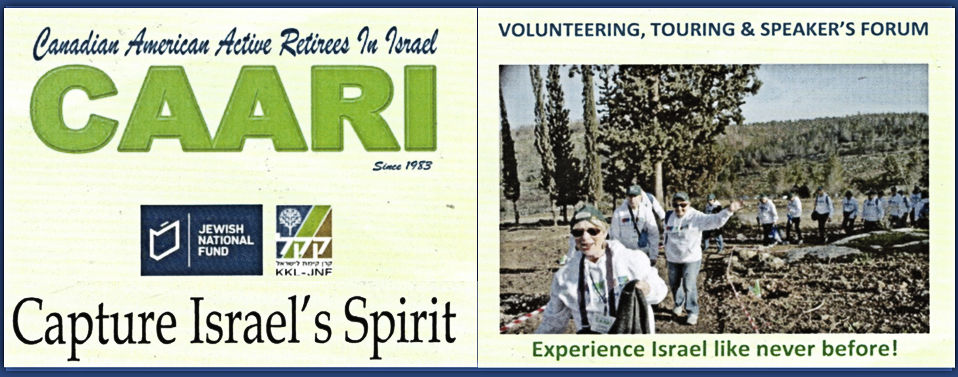
Not Like Any Other Visit to Israel© David Burton 2018 |
 |
 |
 |
 |
 |
 |
 |
 |
 |
 |
 |
 |
 |
|
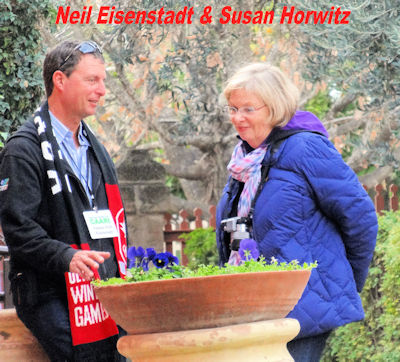 Over these years, the CAARI program has been run by two American expatriates, Susan Horwitz,
formerly from Boston, and Neil Eisenstadt, formerly from upper New York state. Both shared a
number of functions in running the CAARI program. Neil, more or less, functioned as the tour guide, while
Susan mostly handled the administrative matters. Neil was ex-IDF, an IDF reservist, a volunteer policeman,
and a licensed and very experienced Israel tour guide. Susan lived in Tel Aviv and, besides handling the
myriad of administrative program details, served as a surrogate house-mother to all of the CAARI
participants. Neil lived in Israel for about 30 years and Susan about half as long.
Over these years, the CAARI program has been run by two American expatriates, Susan Horwitz,
formerly from Boston, and Neil Eisenstadt, formerly from upper New York state. Both shared a
number of functions in running the CAARI program. Neil, more or less, functioned as the tour guide, while
Susan mostly handled the administrative matters. Neil was ex-IDF, an IDF reservist, a volunteer policeman,
and a licensed and very experienced Israel tour guide. Susan lived in Tel Aviv and, besides handling the
myriad of administrative program details, served as a surrogate house-mother to all of the CAARI
participants. Neil lived in Israel for about 30 years and Susan about half as long. To describe all of my experiences with CAARI would require the writing of a monstorously thick book. To those interested, think of this as this as an appetizer. For the rest of the meal, consider a trip to Israel with CAARI – you will discover it to be unlike any other visit to Israel you may have made or are likely to make! Volunteer Service in Tel Aviv Hagalil School: 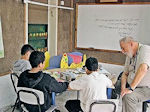 For my volunteer work in Tel Aviv, I chose to tutor English at the Hagalil School located in the
southeast corner of the city. The Hagalil School was a secular elementary school in a middle to lower
economic area. Over my 7 years at the school, I got to meet with a number of the teachers and
administrators, as well as hundreds of Israeli students ranging in age from 6 to 13 years. Interacting
with these young Israeli students proved to be fascinating and enlightening. Many if not most of the
students were either immigrants to Israel or were the children of immigrants. Several were from the
former Soviet Union while others were Blacks from Africa.
For my volunteer work in Tel Aviv, I chose to tutor English at the Hagalil School located in the
southeast corner of the city. The Hagalil School was a secular elementary school in a middle to lower
economic area. Over my 7 years at the school, I got to meet with a number of the teachers and
administrators, as well as hundreds of Israeli students ranging in age from 6 to 13 years. Interacting
with these young Israeli students proved to be fascinating and enlightening. Many if not most of the
students were either immigrants to Israel or were the children of immigrants. Several were from the
former Soviet Union while others were Blacks from Africa. Tel Aviv Botanical Gardens: 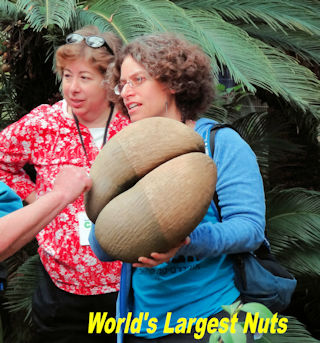 Another site for community service in Tel Aviv was at the Botanical Gardens at the University of Tel Aviv.
Back in 2014, on CAARI’s first visit to the Botanical Gardens, there was considerable new building and
major construction taking place. There was new management at the facility and they were in the process of
upgrading the Garden. Bright spots on my visit to the Botanical Garden were the cactus displays and the
tropical vegetation building. One of the more interesting items in the tropical vegetation building was
an example of a species of nut that comes from a plant that produces the largest nuts in the
world.
Another site for community service in Tel Aviv was at the Botanical Gardens at the University of Tel Aviv.
Back in 2014, on CAARI’s first visit to the Botanical Gardens, there was considerable new building and
major construction taking place. There was new management at the facility and they were in the process of
upgrading the Garden. Bright spots on my visit to the Botanical Garden were the cactus displays and the
tropical vegetation building. One of the more interesting items in the tropical vegetation building was
an example of a species of nut that comes from a plant that produces the largest nuts in the
world. Ichilov Rehabilitation Center: 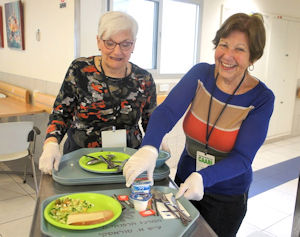 The third opportunity for volunteer work in Tel Aviv was at the Ichilov Rehabilitation Center which
cared for patients recovering from surgery or treatment. Located near the Rabin Memorial and Yitzchak
Rabin Square, the rehabilitation center was part of Tel Aviv’s major hospital complex. CAARI volunteers
helped with meals, talked with the patients, and provided other support to the regular staff.
The third opportunity for volunteer work in Tel Aviv was at the Ichilov Rehabilitation Center which
cared for patients recovering from surgery or treatment. Located near the Rabin Memorial and Yitzchak
Rabin Square, the rehabilitation center was part of Tel Aviv’s major hospital complex. CAARI volunteers
helped with meals, talked with the patients, and provided other support to the regular staff. Volunteer Service Outside Tel Aviv Park Chezi: 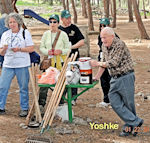 One constant during all of my CAARI visits to Israel was that of helping to maintain a park area in
the Horeshim Forest, 15 to 20 miles northeast of Tel Aviv, just south of the Arab town of
Qalqilya and right on the “Green Line” separating the West Bank from the rest of Israel. The
park area was called Park Chezi. Our work at park Chezi involved painting of benches and signs, clearing undergrowth, lining walking
paths with stone borders, clearing drainage channels, and removing any and all accumulated
debris.
One constant during all of my CAARI visits to Israel was that of helping to maintain a park area in
the Horeshim Forest, 15 to 20 miles northeast of Tel Aviv, just south of the Arab town of
Qalqilya and right on the “Green Line” separating the West Bank from the rest of Israel. The
park area was called Park Chezi. Our work at park Chezi involved painting of benches and signs, clearing undergrowth, lining walking
paths with stone borders, clearing drainage channels, and removing any and all accumulated
debris. The Horeshim Forest was supported by JNF, but the park’s establishment was the result of lobbying by Yoshke Sapir in memory of his son, Chezi Sapir. Chezi Sapir was an IDF officer under whom Neil Eisenstadt served. Their reserve unit was called up to go into the Gaza Strip to protect Jewish settlers there who were under constant attack by Arab terrorists. Chezi sent Neil to obtain up-to-date maps and while Neil was doing this, Chezi Sapir and 2 other officers were killed by a suicide bomber on a bicycle. Chezi’s father, Yoshke was a Holocaust survivor from the Ukraine, who came to Israel after the war on an illegal immigrant ship that was intercepted by the British. Yoshke was interred by the British and then served in the Palmach, the striking arm of the Haganah which later became the IDF Ayalon Park Canada: 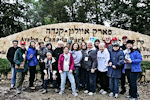 CAARI has helped to maintain several JNF park areas and forest throughout Israel, including the Ofir
Park in the Carmel Forest, the Ben Shemen Forest, and Ayalon Park Canada. Ayalon
Park Canada was one of these forests and was named after the Ayalon Valley in which it lies, and in
recognition of the contribution for its development from JNF Canada.
CAARI has helped to maintain several JNF park areas and forest throughout Israel, including the Ofir
Park in the Carmel Forest, the Ben Shemen Forest, and Ayalon Park Canada. Ayalon
Park Canada was one of these forests and was named after the Ayalon Valley in which it lies, and in
recognition of the contribution for its development from JNF Canada. Tree Planting Day: 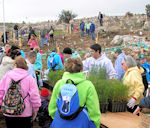 Each year, CAARI joined JNF (KKL in Israel) in celebrating Tu B’Shvat by assisting in the
country’s national tree planting day. This tree planting day was an annual semi-holiday and many
families came out to spend time planting trees in Israel’s forests. Our duties consisted of handing out
saplings and showing the planters where to go to plant them. Typically, hundreds of Israelis would come
out to our site to partake of the tree planting effort.
Each year, CAARI joined JNF (KKL in Israel) in celebrating Tu B’Shvat by assisting in the
country’s national tree planting day. This tree planting day was an annual semi-holiday and many
families came out to spend time planting trees in Israel’s forests. Our duties consisted of handing out
saplings and showing the planters where to go to plant them. Typically, hundreds of Israelis would come
out to our site to partake of the tree planting effort. One thing that stood out in my memories of the tree plantings was the expression of thanks by the Israelis for CAARI’s coming to Israel to support them when they were often under attack by knife-wielding terrorists, by Hamas-led terrorism from Gaza and by Israel-haters abroad. One of the main reasons why I traveled to Israel year after year was to show the people there that I supported them and that they were not alone in their struggles. Since CAARI is JNF affiliated, what would be more natural than tree planting at various JNF founded and maintained forests. CAARI tree planning was carried out every year. In 2016 the planting site was in the Lavi Forest near the Golani Junction Interchange. The tree planting ceremony included the planting of a sapling, the receipt of a certificate from JNF showing that a tree was planted in Israel on behalf of whoever’s name was written on the certificate and the recitation of a prayer associated with the planting of trees. Project Leket:  Founded in 2005, Project Leket was an initiative that sent thousands of volunteers and dozens of paid
pickers into the fields and orchards of Israel to gather produce donated or left to rot by farmers. All
produce was delivered, free of charge, to over 290 nonprofit organizations serving Israel's needy. It was
Israel’s national food bank program.
Founded in 2005, Project Leket was an initiative that sent thousands of volunteers and dozens of paid
pickers into the fields and orchards of Israel to gather produce donated or left to rot by farmers. All
produce was delivered, free of charge, to over 290 nonprofit organizations serving Israel's needy. It was
Israel’s national food bank program. Project Leket was inspired by the Bible, which states: “When you reap your harvest in your field and forget a sheaf in the field, you shall not go back to get it; it shall be left for the alien, the orphan, and the widow, so that the Lord your God may bless you in all your undertakings.” (Deuteronomy 24:19) Each year CAARI would go to an orchard, pick oranges and, by the time we were finished, we had provided about a ton of oranges for the needy – enough for about 120 families. 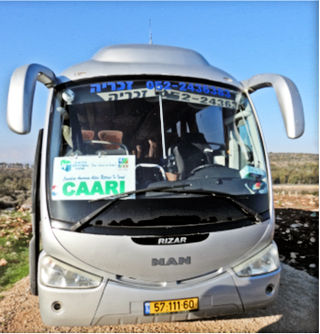 To travel all over Israel, CAARI used a 50+ passenger air-conditioned bus with wi-fi. For most years,
a Yemenite-Jew, Zacharia, was the bus driver. He could maneuver the large touring bus through
the most difficult locations with amazing skill. Zacharia was always on time, had bottles
of water to keep us hydrated, never got flustered, and always had a smile and great attitude.
To travel all over Israel, CAARI used a 50+ passenger air-conditioned bus with wi-fi. For most years,
a Yemenite-Jew, Zacharia, was the bus driver. He could maneuver the large touring bus through
the most difficult locations with amazing skill. Zacharia was always on time, had bottles
of water to keep us hydrated, never got flustered, and always had a smile and great attitude. In Tel Aviv: Each year, CAARI spent about a month in Tel Aviv. One major activity there was its community service work. In addition, CARRI arranged several visits within the city and CAARI participants had ample opportunity to visit as many of Tel Aviv’s points of interest as they wished. Among the many places visited by CAARI were the following: Tayelet: 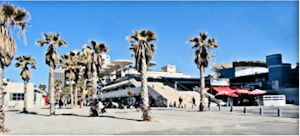 The Tayelet was a walking/biking path in Tel Aviv that runs along the Mediterranean Sea all the way from
the Port of Tel Aviv in the north to Jaffa in the south. It was particularly
busy and pleasant on weekends with folk-dancing and other activities.
The Tayelet was a walking/biking path in Tel Aviv that runs along the Mediterranean Sea all the way from
the Port of Tel Aviv in the north to Jaffa in the south. It was particularly
busy and pleasant on weekends with folk-dancing and other activities. Port of Tel Aviv: 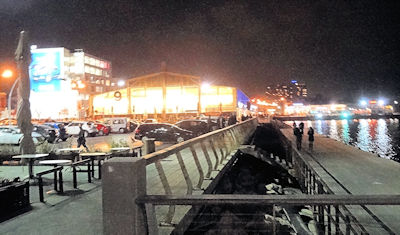 The Port of Tel Aviv lies at the north of the city, just south of the Yarkon River. It was a
pleasant 1-1/4 mile walk from CAARI’s Tel Aviv hotel along the Tayelet,
Tel Aviv’s walkway along the
Mediterranean Sea. On weekends, the port was wall-to-wall people -
children everywhere, bicycle-riders,
in-line-skaters, walkers, dogs by the dozens, and street entertainers. Even tin mid-afternoon, the
restaurants and cafes were jammed and most had lines of customers waiting for tables.
The Port of Tel Aviv lies at the north of the city, just south of the Yarkon River. It was a
pleasant 1-1/4 mile walk from CAARI’s Tel Aviv hotel along the Tayelet,
Tel Aviv’s walkway along the
Mediterranean Sea. On weekends, the port was wall-to-wall people -
children everywhere, bicycle-riders,
in-line-skaters, walkers, dogs by the dozens, and street entertainers. Even tin mid-afternoon, the
restaurants and cafes were jammed and most had lines of customers waiting for tables. Carmel Market and Tel Aviv Crafts Fair: 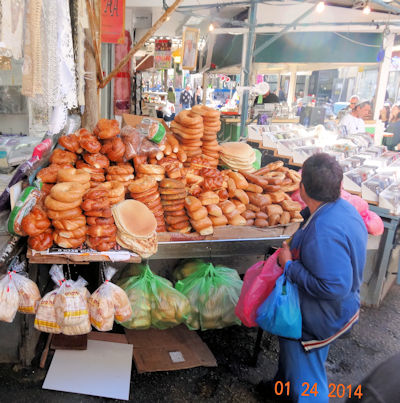 Friday was typically the day to visit the Carmel Market or Shuk
and the Crafts Fair in Tel Aviv. CAARI
usually left Friday as a free day, while the Crafts Fair was open on that day. Several street entertainers
performed at the Shuk and Fair. The Shuk contained a multitude of outdoor markets, while the Crafts Fair
had numerous booths offering a variety of hand-made craft items. There were also several outdoor
restaurants at which to have lunch, a snack or coffee. It was a joy to be eating at an outdoor café in
shirt sleeves, in the middle of winter, people watching, while listening to excellent street music. It was
certainly well worth a trip to Israel just to experience the Carmel Shuk and the adjacent Crafts Fair.
As always, the Shuk was jammed on Fridays. The food stands were filled with magnificent produce,
beautiful baked goods, fresh fish, smoked fish, meats and other delicacies. When you come to the Shuk,
be an Israeli and just push your way through.
Friday was typically the day to visit the Carmel Market or Shuk
and the Crafts Fair in Tel Aviv. CAARI
usually left Friday as a free day, while the Crafts Fair was open on that day. Several street entertainers
performed at the Shuk and Fair. The Shuk contained a multitude of outdoor markets, while the Crafts Fair
had numerous booths offering a variety of hand-made craft items. There were also several outdoor
restaurants at which to have lunch, a snack or coffee. It was a joy to be eating at an outdoor café in
shirt sleeves, in the middle of winter, people watching, while listening to excellent street music. It was
certainly well worth a trip to Israel just to experience the Carmel Shuk and the adjacent Crafts Fair.
As always, the Shuk was jammed on Fridays. The food stands were filled with magnificent produce,
beautiful baked goods, fresh fish, smoked fish, meats and other delicacies. When you come to the Shuk,
be an Israeli and just push your way through. Bialik Street: 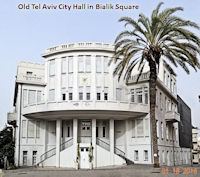 In 2016, CAARI took a walking tour of Bialik Street in Tel Aviv. At one end of Bialik Street was the old
Tel Aviv City Hall. Originally intended as a hotel, the building was rented out to the
new city of Tel Aviv, which established the city hall there in 1924 and which remained the
Tel Aviv city hall for over 40 years.
In 2016, CAARI took a walking tour of Bialik Street in Tel Aviv. At one end of Bialik Street was the old
Tel Aviv City Hall. Originally intended as a hotel, the building was rented out to the
new city of Tel Aviv, which established the city hall there in 1924 and which remained the
Tel Aviv city hall for over 40 years. Walking down Bialik Street toward Allenby Street, we passed the home of Haim Nahman Bialik, the Rubin Museum, an old synagogue that served the neighborhood, and a variety of buildings constructed mainly by wealthy people from Europe accustomed to gracious living. The architectural styles in the area included pre-World War I Turkish-Ottoman buildings and other buildings designed and built in the Bauhaus style developed in Germany between the two world wars. Bauhaus Architecture: 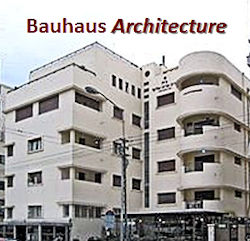 CAARI conducted guided walking tours of Tel Aviv’s Bauhaus architecture. Tel Aviv was sometimes referred
to as the White City, which refered to a collection of over 4,000 Bauhaus or International style
buildings built in the city during the 1930s by German Jewish architects who immigrated after the rise to
power of the Nazis. Tel Aviv had the largest number of buildings in this style of any city in the world.
In 2003, UNESCO proclaimed Tel Aviv's White City a World Cultural Heritage site, as "an outstanding
example of new town planning and architecture in the early 20th century."
CAARI conducted guided walking tours of Tel Aviv’s Bauhaus architecture. Tel Aviv was sometimes referred
to as the White City, which refered to a collection of over 4,000 Bauhaus or International style
buildings built in the city during the 1930s by German Jewish architects who immigrated after the rise to
power of the Nazis. Tel Aviv had the largest number of buildings in this style of any city in the world.
In 2003, UNESCO proclaimed Tel Aviv's White City a World Cultural Heritage site, as "an outstanding
example of new town planning and architecture in the early 20th century." Neve Tzedek: 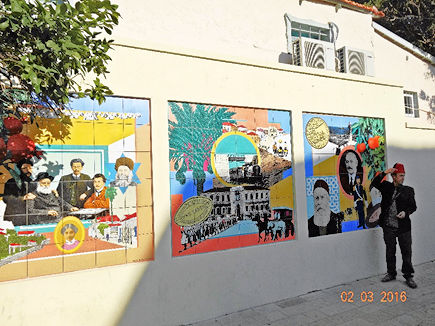 In Tel Aviv, CAARI took guided walking tours of the Neve Tzedek neighborhood. In 1882 Neve-Tzedek
became the first Jewish neighborhood to be built outside the walled city of Jaffa and was the first
Jewish community in the newly created city of Tel Aviv. At the beginning of the 20th century Neve Tzedek
was the home of many artists and writers. Most notably, future Nobel Prize laureate
Shmuel Yosef Agnon.
Later, the area suffered from neglect with many of the old houses and streets crumbling away. But today,
Neve Zedek is regaining its former prestige and has become a stylish yuppie residence with many
restaurants, galleries and designer shops. The architecture of Neve Tzedek is one of its highlights with
many beautiful old houses already restored to their earlier grandeur.
In Tel Aviv, CAARI took guided walking tours of the Neve Tzedek neighborhood. In 1882 Neve-Tzedek
became the first Jewish neighborhood to be built outside the walled city of Jaffa and was the first
Jewish community in the newly created city of Tel Aviv. At the beginning of the 20th century Neve Tzedek
was the home of many artists and writers. Most notably, future Nobel Prize laureate
Shmuel Yosef Agnon.
Later, the area suffered from neglect with many of the old houses and streets crumbling away. But today,
Neve Zedek is regaining its former prestige and has become a stylish yuppie residence with many
restaurants, galleries and designer shops. The architecture of Neve Tzedek is one of its highlights with
many beautiful old houses already restored to their earlier grandeur. Dizengoff Street:  At one time Dizengoff Street was the only street on which to be seen in Tel Aviv. Although it had aged a
bit, it was still a place to shop, have coffee, see and be seen and to simply enjoy. Two popular spots on
the street were the Dizengoff Mall and Dizengoff Circle On my 2017 visit, Dizengoff
Circle was undergoing major changes, going from two levels to one.
At one time Dizengoff Street was the only street on which to be seen in Tel Aviv. Although it had aged a
bit, it was still a place to shop, have coffee, see and be seen and to simply enjoy. Two popular spots on
the street were the Dizengoff Mall and Dizengoff Circle On my 2017 visit, Dizengoff
Circle was undergoing major changes, going from two levels to one. Rabin Memorial and Yitzchak Rabin Square: 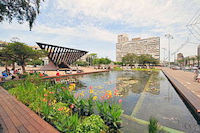 Rabin Square was in the center of Tel Aviv and was originally named Kings of Israel Square.
It is the place
where Yitzchak Rabin was assassinated in 1995. It was an old-fashioned square in the middle of modern
Tel Aviv and was always home to large gatherings such as political demonstrations. The
Rabin Memorial consisting of 16 basalt rocks from the Golan Heights was in the square.
Rabin Square was in the center of Tel Aviv and was originally named Kings of Israel Square.
It is the place
where Yitzchak Rabin was assassinated in 1995. It was an old-fashioned square in the middle of modern
Tel Aviv and was always home to large gatherings such as political demonstrations. The
Rabin Memorial consisting of 16 basalt rocks from the Golan Heights was in the square. Independence Hall: 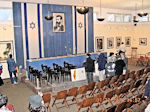 Independence Hall in Tel Aviv had been toured by CAARI more than once. In this building, David
Ben-Gurion announced the formation of the State of Israel in May 1948. Independence Hall was
originally the home of Meir Dizengoff, one of the original 66 Jewish founders of Tel Aviv in
1909. Later, he donated his house to the city for an art museum, the Tel Aviv Art Museum.
30 years afterward, the art museum was converted into Independence Hall.
Independence Hall in Tel Aviv had been toured by CAARI more than once. In this building, David
Ben-Gurion announced the formation of the State of Israel in May 1948. Independence Hall was
originally the home of Meir Dizengoff, one of the original 66 Jewish founders of Tel Aviv in
1909. Later, he donated his house to the city for an art museum, the Tel Aviv Art Museum.
30 years afterward, the art museum was converted into Independence Hall. Tel Aviv Museum of Art: 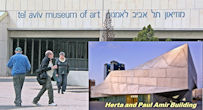 CAARI visited the Tel Aviv Museum of Art on more than one occasion. In 2012, we had a guided tour of
the museum’s very modernistic new wing. The museum was originally located in the house of Meir
Dizengoff, which he donated to the city in 1932. When the original building became
Independence Hall,
the museum moved to its present location.
CAARI visited the Tel Aviv Museum of Art on more than one occasion. In 2012, we had a guided tour of
the museum’s very modernistic new wing. The museum was originally located in the house of Meir
Dizengoff, which he donated to the city in 1932. When the original building became
Independence Hall,
the museum moved to its present location.The new wing of the Tel Aviv Museum of Art, the Herta and Paul Amir Building, was designed by the Cambridge, Massachusetts architect Preston Scott Cohen who was chairman of the architecture department at Harvard University. The building’s 3 floors were linked to 2 more below ground by an 87-foot-high, top-lit atrium and a “lightfall” that shone on the world’s largest collection of Israeli art. The Tel Aviv Museum of Art was one of the city’s must-visits. Yitzhak Rabin Museum: 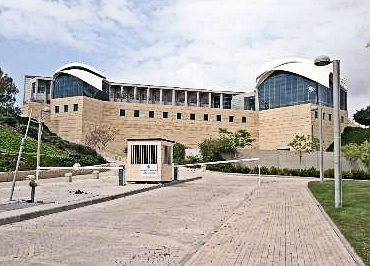 The Yitzhak Rabin Museum was on the campus of Tel Aviv University.
I visited the museum more than once with CAARI and I found it as interesting on my most recent visit
as on my first. One feature of the museum that I did not notice on my early visits was the lovely and very
well-kept olive tree garden to the right of the entrance, which was presented to the museum by the former
King Hussein of Jordan. The Yitzhak Rabin Center, one of Israel’s newest museums,
was the official
memorial dedicated to the memory and legacy of the assassinated Israeli Prime Minister,
Yitzhak Rabin.
The Yitzhak Rabin Museum was on the campus of Tel Aviv University.
I visited the museum more than once with CAARI and I found it as interesting on my most recent visit
as on my first. One feature of the museum that I did not notice on my early visits was the lovely and very
well-kept olive tree garden to the right of the entrance, which was presented to the museum by the former
King Hussein of Jordan. The Yitzhak Rabin Center, one of Israel’s newest museums,
was the official
memorial dedicated to the memory and legacy of the assassinated Israeli Prime Minister,
Yitzhak Rabin. The museum explored the history and development of the modern State of Israel, using the biography of Yitzhak Rabin as a connecting thread. The museum boasted internationally acclaimed architecture and breathtaking panoramic views of the city from its terraces. It should not be missed if one visits Israel. Built in a downward spiral, the museum presented two parallel stories: the history of the State and Israeli society, and the biography of Yitzhak Rabin. Diaspora Museum: 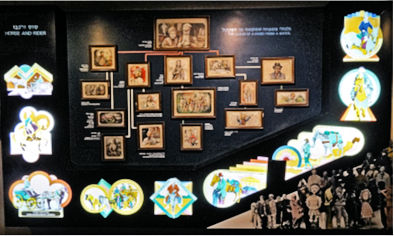 It took CAARI about 2 hours for a guided tour of the Diaspora Museum, located just north of the Yarkon
River on the campus of Tel Aviv University. The museum tells the story
of the Jewish diaspora,
starting around 70 C.E. with the destruction of the 2nd Temple and the expulsion of Jews
from the Land of Israel.
It took CAARI about 2 hours for a guided tour of the Diaspora Museum, located just north of the Yarkon
River on the campus of Tel Aviv University. The museum tells the story
of the Jewish diaspora,
starting around 70 C.E. with the destruction of the 2nd Temple and the expulsion of Jews
from the Land of Israel. Eretz Israel Museum: 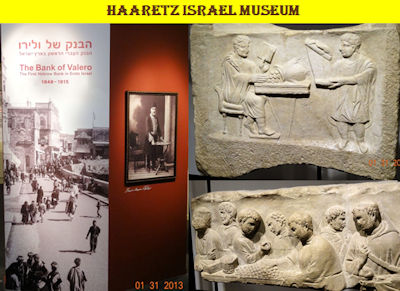 The Eretz Israel Museum was on the campus of Tel Aviv University and was dedicated to the history of the
Holy land and its peoples. The museum was located on a tel and archaeological excavations took place
there. The museum was composed of several buildings plus outdoor exhibits. We went through the “Postal
Museum”, the “Pottery Museum” and the “Coin Museum.” One of the interesting exhibits in the Postal
Museum was that on the “Gymnasia”, which was the first school in the world to teach in Hebrew. The
co-ed Gymnasia was built in 1907 on land in the southern part of what eventually became part of
Tel Aviv – the city of Tel Aviv did not yet exist at that time. The Gymnasia was torn down in 1959.
During our tour of the Gymnasia exhibit, we were addressed by a gentleman who had attended and graduated
from the school.
The Eretz Israel Museum was on the campus of Tel Aviv University and was dedicated to the history of the
Holy land and its peoples. The museum was located on a tel and archaeological excavations took place
there. The museum was composed of several buildings plus outdoor exhibits. We went through the “Postal
Museum”, the “Pottery Museum” and the “Coin Museum.” One of the interesting exhibits in the Postal
Museum was that on the “Gymnasia”, which was the first school in the world to teach in Hebrew. The
co-ed Gymnasia was built in 1907 on land in the southern part of what eventually became part of
Tel Aviv – the city of Tel Aviv did not yet exist at that time. The Gymnasia was torn down in 1959.
During our tour of the Gymnasia exhibit, we were addressed by a gentleman who had attended and graduated
from the school. Palmach Museum: 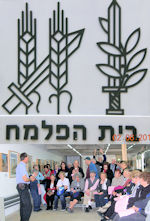 The Palmach Museum was adjacent to the Yitzchak Rabin Museum,
the University of Tel Aviv and the Eretz Yisrael Museum.
The Palmach was the elite striking force of the
Haganah, an underground military organization prior to the establishment of the State of
Israel. It, along with the other underground organizations, eventually coalesced into the IDF.
The Palmach Museum was adjacent to the Yitzchak Rabin Museum,
the University of Tel Aviv and the Eretz Yisrael Museum.
The Palmach was the elite striking force of the
Haganah, an underground military organization prior to the establishment of the State of
Israel. It, along with the other underground organizations, eventually coalesced into the IDF. The Palmach was founded by the British in May 1941 to help defend Palestine against the approaching German armies in North Africa and against the Vichy French forces (at that time allied with Nazi Germany) in Syria and Iraq. From the summer of 1945 until the end of 1947, the Palmach fought the British. Anticipating the withdrawal of the British and the subsequent Arab military uprisings, preparations were also made to counter the attacks of local Arabs and of neighboring Arab countries. In Israel’s War of Independence, the Palmach and Haganah liberated Jerusalem and other besieged towns, opened roads and defeated the invading Arab armies. Immediately after the declaration of the State of Israel, the Israel Defense forces (IDF) was established, based on the infrastructure of the Haganah and its striking force, the Palmach. The Palmach Museum was an experiential museum, covering the Palmach legacy through the stories of individuals and groups. The manner of presentation was extremely innovative. There were no displays or documents, but rather an account of a fascinating personal story accompanied by three-dimensional decor, films and various effects incorporating documentary materials. CAARI’s tour began and ended in the Memorial Hall for Palmach warriors who died fighting for the establishment of the state of Israel. As we walked through the hall, we passed by the names of all 1,168 Palmach fighters that were killed in the fighting that resulted in the formation of the State of Israel. On one visit, we were extremely fortunate to have Uri, a former member of the Palmach and a relative of one of the CAARI group, speak to us. Uri was a very spry 84 years of age. I visited the Palmach Museum with CAARI more than once and it was just as moving the last time as it was the first time. Beit Gidi Etzel Museum:  In 2012 CAARI took me to the Beit Gidi Etzel Museum, which was located on the southern end of Tel
Aviv’s Tayelet, just north of Jaffa and just west of the Neve
Tzedek neighborhood. The museum was small
and not particularly impressive. BUT a museum guide named Yoske Nachmias
made the visit a most
memorable one. The museum was a sleek glass rectangular structure built over the ruins of a former
Ottoman building. Etzel was one of 3 Jewish paramilitary forces - Etzel, the Haganah
and Lehi - that
fought both the British and the Arabs to win Jewish independence. The museum was dedicated to the
history of the Etzel movement. The central exhibit was about the battle for Jaffa and commemorated
the 41 Etzel soldiers who fell in the battle. In April 1948, Menachem Begin was the Etzel
leader who sent 600 fighters into the battle for Jaffa.
In 2012 CAARI took me to the Beit Gidi Etzel Museum, which was located on the southern end of Tel
Aviv’s Tayelet, just north of Jaffa and just west of the Neve
Tzedek neighborhood. The museum was small
and not particularly impressive. BUT a museum guide named Yoske Nachmias
made the visit a most
memorable one. The museum was a sleek glass rectangular structure built over the ruins of a former
Ottoman building. Etzel was one of 3 Jewish paramilitary forces - Etzel, the Haganah
and Lehi - that
fought both the British and the Arabs to win Jewish independence. The museum was dedicated to the
history of the Etzel movement. The central exhibit was about the battle for Jaffa and commemorated
the 41 Etzel soldiers who fell in the battle. In April 1948, Menachem Begin was the Etzel
leader who sent 600 fighters into the battle for Jaffa. 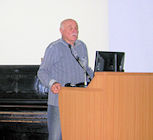 In 2012, Yoske was a very young 86 years of age. In WWII, he joined
the British Army at the age of
only 14. He spent the next 6 years in the British Army but was also a member of Etzel. Later, Yoske took
part in a number of operations against the British forces in Palestine. He was captured by the British
and imprisoned in the Acre Prison where he was one of the 28 Jewish prisoners that
were rescued during
the famous attack on the prison. There were many more fascinating aspects of the Yoske
Nachmias narrative.
In 2012, Yoske was a very young 86 years of age. In WWII, he joined
the British Army at the age of
only 14. He spent the next 6 years in the British Army but was also a member of Etzel. Later, Yoske took
part in a number of operations against the British forces in Palestine. He was captured by the British
and imprisoned in the Acre Prison where he was one of the 28 Jewish prisoners that
were rescued during
the famous attack on the prison. There were many more fascinating aspects of the Yoske
Nachmias narrative. Dan Gourmet School of Kosher Culinary Arts: 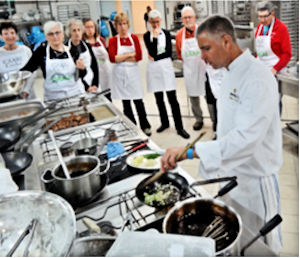 One site visited by CAARI that immediately became popular was the Dan Gourmet High Culinary Center in
southern Tel Aviv. The Dan Hotel Chain was the leading hotel chain in Israel.
The Dan Gourmet School of
Kosher Culinary Arts opened in 2012 as a collaboration between the ORT Vocational Schools
and the Dan
Hotel chain. The $2 million center was fully equipped and claimed to be the largest kosher learning
kitchen in the world. It offered an internationally recognized cooking and baking curriculum for aspiring
chefs. In addition to training young people to be kosher chefs, the school offered informal courses for
Israelis and tourists looking to improve their cooking skills. CAARI spent entire afternoons at the
Center, preparing and then eating various styles of cuisine.
One site visited by CAARI that immediately became popular was the Dan Gourmet High Culinary Center in
southern Tel Aviv. The Dan Hotel Chain was the leading hotel chain in Israel.
The Dan Gourmet School of
Kosher Culinary Arts opened in 2012 as a collaboration between the ORT Vocational Schools
and the Dan
Hotel chain. The $2 million center was fully equipped and claimed to be the largest kosher learning
kitchen in the world. It offered an internationally recognized cooking and baking curriculum for aspiring
chefs. In addition to training young people to be kosher chefs, the school offered informal courses for
Israelis and tourists looking to improve their cooking skills. CAARI spent entire afternoons at the
Center, preparing and then eating various styles of cuisine. Peres Peace Center: 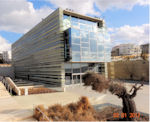 Shortly after the death of Shimon Peres, CAARI visited the Peres Peace Center, located at the
southernmost tip of Jaffa. The Center was founded in 1996 by Shimon Peres. The Peres Center for
Peace was an austere, but imposing glass and concrete structure on the edge of the Mediterranean
Sea.
Shortly after the death of Shimon Peres, CAARI visited the Peres Peace Center, located at the
southernmost tip of Jaffa. The Center was founded in 1996 by Shimon Peres. The Peres Center for
Peace was an austere, but imposing glass and concrete structure on the edge of the Mediterranean
Sea. CAARI received a verbal presentation about the Peace Center in a spacious auditorium with the Mediterranean Sea visible as a backdrop through enormous glass windows. We then watched short video clips on the history, mission and activities of the Peres Center for Peace. The presentations were excellent and gave some hope that there could eventually be peace between the Arabs and Jews in Israel and between Israelis and “Palestinians”. i24 News studio: 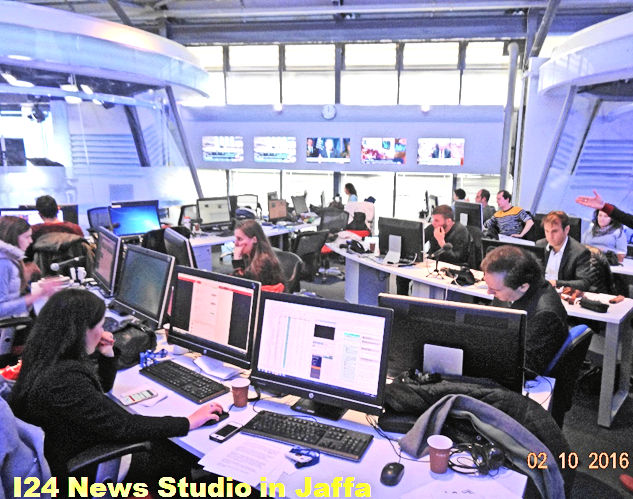 CAARI visited the i24news studio in the port of Jaffa twice after the start
of the station’s operation
in 2013. i24news was an international 24-hour news and current affairs television channel that
provided news and talk shows designed to cover international news with a diverse Israeli perspective.
Some 250 journalists of different nationalities, ethnicities, and religions produced the news, talk
shows and news magazine content. It broadcast in English, French and Arabic. i24news was looking to
become the Israeli CNN.
CAARI visited the i24news studio in the port of Jaffa twice after the start
of the station’s operation
in 2013. i24news was an international 24-hour news and current affairs television channel that
provided news and talk shows designed to cover international news with a diverse Israeli perspective.
Some 250 journalists of different nationalities, ethnicities, and religions produced the news, talk
shows and news magazine content. It broadcast in English, French and Arabic. i24news was looking to
become the Israeli CNN. One of the goals for the station was to change the international "point of view about Israel” by battling prejudice against, and ignorance about Israel with facts and “diversity.” With the goal of presenting non-biased news from Israel’s perspective to the world, it employed Jewish, Muslim, Christian, Druze, Arab, Israeli and non-Israeli staff. Interestingly, i24news was not available in Israel in 2016 because it hasn’t been granted a license. Its Arabic language programs were most popular in Saudi Arabia and it was also seen in Egypt, as well as other Arab nations in the region. CAARI was taken on tours of the station which was located in a former warehouse on the Jaffa waterfront. American Colony in Jaffa: 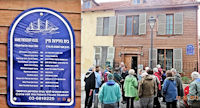 In 2013, CAARI visited the American Colony in Jaffa. This area was where a Christian
church group from Jonesport, Maine tried to establish a community in 1866.
By 1868 the community had failed and the surviving members returned to America.
The people from Maine had brought their own prefabricated wooden homes and farming
implements. The vacated buildings were purchased by German Lutherans and,
in 2013, the area housed a Lutheran church and a guest house run by the Lutherans.
In 2013, CAARI visited the American Colony in Jaffa. This area was where a Christian
church group from Jonesport, Maine tried to establish a community in 1866.
By 1868 the community had failed and the surviving members returned to America.
The people from Maine had brought their own prefabricated wooden homes and farming
implements. The vacated buildings were purchased by German Lutherans and,
in 2013, the area housed a Lutheran church and a guest house run by the Lutherans. At the guest house, we were provided with an extremely interesting talk about the history of the American Colony and we saw photographs dating from the late 1800’s that were discovered in London on glass slide plates. Some of the original houses in the American Colony had been restored and one, named the Maine Friendship House, had been purchased and restored by an American couple. It served as both their residence and a museum. CAARI toured the house, watched a video about the community and the restoration work that had already taken place. Outside Tel Aviv and Jerusalem: ALEH Negev-Nahalat Eran Rehabilitation Village: 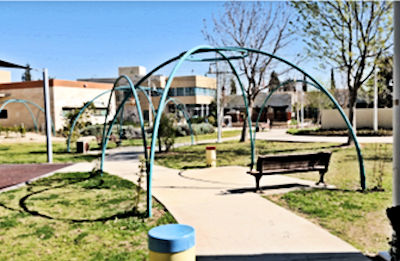 The ALEH Negev-Nahalat Eran Rehabilitation Village was a fascinating touring site. Located in the city
of Ofakim in the Negev Region of southern Israel, ALEH Negev was a multifaceted facility that
provided young and old with multiple disabilities the opportunity to live a rich and productive life
within a safe environment. More than three decades ago, the Rehabilitation Village was started by
Major General (Ret.) Doron Almog, an Israeli military hero whose severely disabled son,
Eran,
was ALEH Negev’s first resident. Eran died in his early 20’s and the facility was named in his
memory.
The ALEH Negev-Nahalat Eran Rehabilitation Village was a fascinating touring site. Located in the city
of Ofakim in the Negev Region of southern Israel, ALEH Negev was a multifaceted facility that
provided young and old with multiple disabilities the opportunity to live a rich and productive life
within a safe environment. More than three decades ago, the Rehabilitation Village was started by
Major General (Ret.) Doron Almog, an Israeli military hero whose severely disabled son,
Eran,
was ALEH Negev’s first resident. Eran died in his early 20’s and the facility was named in his
memory. The Rehabilitation Village contained: Assisted-Living Apartment Units, a Vocational Workshop Center, High Dependency Hospital Center, Hydrotherapy Pool, Safari Petting Zoo, Horseback Riding Track, Dental Clinic specially adapted for people with disabilities, and Therapeutic Gardens. It serviced all residents of the Negev area, including the Bedouin community there. ALEH Negev also provided jobs to hundreds of area residents in a variety of fields, including education, rehabilitation, maintenance, administration, medicine, supportive care and more. Sderot: 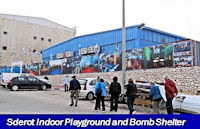 CAARI frequently visited the town of which sits adjacent to the northeast corner of the Gaza
Strip.
Sderot was well-known in the western media because it was often subjected to missile and mortar attacks
from the Gaza strip. As a result, all buildings in Sderot had “safe rooms” to provide protection
against these attacks. All bus stops on the streets of Sderot also had small bomb shelters. Warning
times for missiles launched from the Gaza Strip were only 15 to 20 seconds. CAARI visits to Sderot
usually included a short walk up a hill, viewing the border fence, and looking into the Strip and to
Gaza City in the distance. Coming back from the hill, we would go to the Sderot Indoor Playground
that was built with American JNF funding – hence its nickname, the JNF Sderot Blue Box.
Because of the critical need – Sderot was hit with 2,000 rockets in May of 2008 - it was built in just
10 months with funds from JNF America, opening its doors in March 2009. The playground was designed
to provide protection for children from rockets fired into Sderot from the Gaza Strip. The $5 million
facility was constructed in an old textile warehouse and reinforced with 300 tons of steel. Play areas
double as bomb shelters, ensuring that all occupants can quickly reach safety in the event of a
“code red” rocket alert.
CAARI frequently visited the town of which sits adjacent to the northeast corner of the Gaza
Strip.
Sderot was well-known in the western media because it was often subjected to missile and mortar attacks
from the Gaza strip. As a result, all buildings in Sderot had “safe rooms” to provide protection
against these attacks. All bus stops on the streets of Sderot also had small bomb shelters. Warning
times for missiles launched from the Gaza Strip were only 15 to 20 seconds. CAARI visits to Sderot
usually included a short walk up a hill, viewing the border fence, and looking into the Strip and to
Gaza City in the distance. Coming back from the hill, we would go to the Sderot Indoor Playground
that was built with American JNF funding – hence its nickname, the JNF Sderot Blue Box.
Because of the critical need – Sderot was hit with 2,000 rockets in May of 2008 - it was built in just
10 months with funds from JNF America, opening its doors in March 2009. The playground was designed
to provide protection for children from rockets fired into Sderot from the Gaza Strip. The $5 million
facility was constructed in an old textile warehouse and reinforced with 300 tons of steel. Play areas
double as bomb shelters, ensuring that all occupants can quickly reach safety in the event of a
“code red” rocket alert. Makhtesh Ramon: 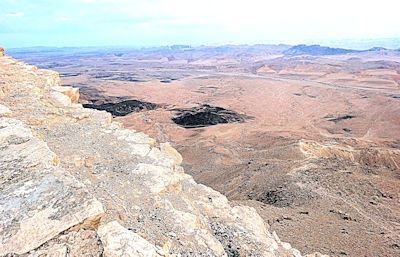 One of the most amazing touring locations in Israel was the Makhtesh Ramon. A makhtesh was a
geological landform considered unique to the Negev Desert of Israel. It had steep walls of
resistant rock surrounding a deep closed valley which was usually drained by a single wadi. The
valleys had limited vegetation and soil, containing a variety of different colored rocks and
diverse vegetation and wildlife. Makhtesh Ramon was the best known and largest makhtesh. CAARI
tours of the Makhtesh Ramon were made in 4x4 SUVs that allowed us to go off-road.
One of the most amazing touring locations in Israel was the Makhtesh Ramon. A makhtesh was a
geological landform considered unique to the Negev Desert of Israel. It had steep walls of
resistant rock surrounding a deep closed valley which was usually drained by a single wadi. The
valleys had limited vegetation and soil, containing a variety of different colored rocks and
diverse vegetation and wildlife. Makhtesh Ramon was the best known and largest makhtesh. CAARI
tours of the Makhtesh Ramon were made in 4x4 SUVs that allowed us to go off-road. The Makhtesh Ramon was 1,500 feet deep and encompassed a vast diversity of rocks having fantastic colors and forms. High and impressive mountains rose at the borders of the crater. Ha-Minsara (The Carpentry Shop) was a low hill in the central part of the crater with rather strange-looking black prismatic rocks that look like scrap pieces of wood from a carpenter’s workshop strewn about. Ein Saharonim, to the north of ha-Minsara, was the lowest spot in the crater and contained the crater’s only natural water source. On a hill on the other side of the parking lot at Ein Saharonim stood the ruins of a large stone structure, Khan Saharonim which was on the ancient spice trail, a trade route used by the Nabateans 2,000 years ago. Traders and their camels spent the night at the inn before continuing on to the port of Gaza. Mitzpe Ramon: 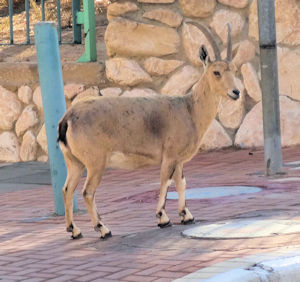 Mitzpe Ramon was a small, but growing, town that was situated on the northern ridge of
Makhtesh Ramon,
at an elevation of 3,300 feet. The town had a Yeshiva (Religious school), a Chabad, an industrial
area, and the Makhtesh Ramon Visitors Center. Makhtesh Ramon catered to tourists
and members of the IDF from a number of military facilities in the area. One interesting
feature of the town that I enjoyed were the wild Ibex that roamed the streets
and would take food from one’s hand.
Mitzpe Ramon was a small, but growing, town that was situated on the northern ridge of
Makhtesh Ramon,
at an elevation of 3,300 feet. The town had a Yeshiva (Religious school), a Chabad, an industrial
area, and the Makhtesh Ramon Visitors Center. Makhtesh Ramon catered to tourists
and members of the IDF from a number of military facilities in the area. One interesting
feature of the town that I enjoyed were the wild Ibex that roamed the streets
and would take food from one’s hand. Nitsana: 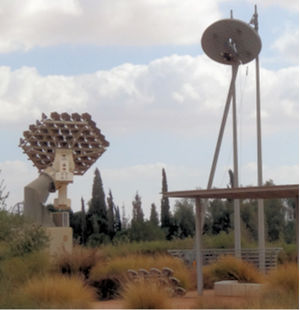 Nitsana, which CAARI visited in 2017, was located in the Western Negev Desert,
less than 2-miles
from the Egyptian border. It was an educational youth village and communal settlement.
Nitsana was founded by the Nabateans in the 3rd century BCE. The modern village of
Nitsana was founded in 1987. The main aim was to educate Israeli and Diaspora youth about
the settlement potential
of the desert. The village served as an absorption center and Hebrew language school for young
immigrants. In addition, it offered various educational programs for Diaspora youth and is
also a research center for environmental studies. Various seminars taught the importance of the
Negev Desert, ecology and protection of the environment, water sources, conservation, recycling
and environmental sustainability. A solar park taught about the need to create clean renewable
energy.
Nitsana, which CAARI visited in 2017, was located in the Western Negev Desert,
less than 2-miles
from the Egyptian border. It was an educational youth village and communal settlement.
Nitsana was founded by the Nabateans in the 3rd century BCE. The modern village of
Nitsana was founded in 1987. The main aim was to educate Israeli and Diaspora youth about
the settlement potential
of the desert. The village served as an absorption center and Hebrew language school for young
immigrants. In addition, it offered various educational programs for Diaspora youth and is
also a research center for environmental studies. Various seminars taught the importance of the
Negev Desert, ecology and protection of the environment, water sources, conservation, recycling
and environmental sustainability. A solar park taught about the need to create clean renewable
energy. Ramat Negev Desert Agricultural Research Institute: 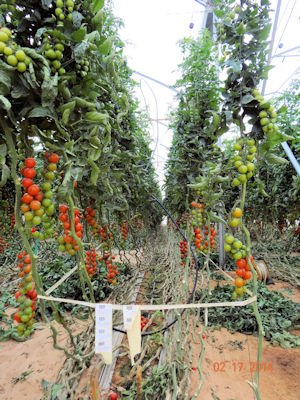 This agricultural research center was located in the northwest Negev near the
Egyptian border. It was established
about 50 years ago as part of the project of setting up regional research and development centers
throughout the country. The main purpose of this Research Center was to encourage the development
of agriculture in the Negev, taking advantage of the desert’s natural resources. There, the
Center’s varied activities were explained and shown to CAARI. This was an applied research facility
so researchers spent some time working at the Center and the rest of the time instructing the
farmers in their region. Knowledge accumulated in the Center was transferred directly to the
farmers, free of charge, and problems that arose were immediately fed back to the Center. Israeli
expertise in applied agricultural research was well known and respected worldwide – this was
evidenced by the fact that farmers from Africa and elsewhere came to the Research Center to
learn about what was developed there.
This agricultural research center was located in the northwest Negev near the
Egyptian border. It was established
about 50 years ago as part of the project of setting up regional research and development centers
throughout the country. The main purpose of this Research Center was to encourage the development
of agriculture in the Negev, taking advantage of the desert’s natural resources. There, the
Center’s varied activities were explained and shown to CAARI. This was an applied research facility
so researchers spent some time working at the Center and the rest of the time instructing the
farmers in their region. Knowledge accumulated in the Center was transferred directly to the
farmers, free of charge, and problems that arose were immediately fed back to the Center. Israeli
expertise in applied agricultural research was well known and respected worldwide – this was
evidenced by the fact that farmers from Africa and elsewhere came to the Research Center to
learn about what was developed there. Ovdat:  The ancient Nabatean city of Ovdat was north of the
The ancient Nabatean city of Ovdat was north of the Sde Boker:  Sde Boker was a kibbutz in the northern
Sde Boker was a kibbutz in the northern Tsin Valley: 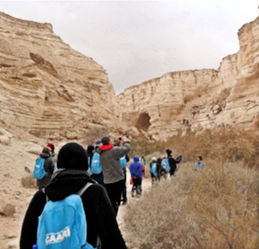 In 2017, starting in Sde Boker, CAARI hiked 3 miles through the Tsin Valley (also
spelled Zin Valley). The scenery was breathtaking and we saw several Ibex
and other wildlife during the hike.
In addition to the Ibex, we came across the Tsin River, a waterfall, stagnant
pools of water,
and a variety of plants and trees that grew in the arid valley. We concluded our hike with a
near vertical climb to reach the rim of the canyon. Metal steps and handrails had been carefully
drilled into the bedrock walls at strategic points allowing us to properly place our hands and
feet on the steep climb up and out of the canyon.
In 2017, starting in Sde Boker, CAARI hiked 3 miles through the Tsin Valley (also
spelled Zin Valley). The scenery was breathtaking and we saw several Ibex
and other wildlife during the hike.
In addition to the Ibex, we came across the Tsin River, a waterfall, stagnant
pools of water,
and a variety of plants and trees that grew in the arid valley. We concluded our hike with a
near vertical climb to reach the rim of the canyon. Metal steps and handrails had been carefully
drilled into the bedrock walls at strategic points allowing us to properly place our hands and
feet on the steep climb up and out of the canyon. Dead Sea: 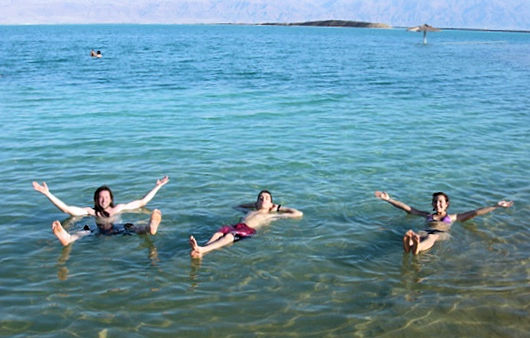 The Dead Sea was the lowest point on earth. It was drying up and may
disappear if no corrective action is taken. We stayed at a hotel right adjacent to the inland sea
with the saltiest water in the world, allowing CAARI members to float in the saline waters or swim
in the hotel’s fresh water pool. There have been talks between Israel and Jordan concerning
the possibility of bringing in water from the Red sea via a canal to prevent the drying up
of the Dead Sea.
The Dead Sea was the lowest point on earth. It was drying up and may
disappear if no corrective action is taken. We stayed at a hotel right adjacent to the inland sea
with the saltiest water in the world, allowing CAARI members to float in the saline waters or swim
in the hotel’s fresh water pool. There have been talks between Israel and Jordan concerning
the possibility of bringing in water from the Red sea via a canal to prevent the drying up
of the Dead Sea. Ein Gedi: 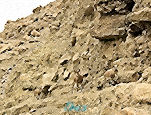 Ein Gedi, just west of the Dead Sea, was one of my favorite places to visit in
Israel with CAARI.
There was a hike up a twisting path with waterfalls, springs, Ibex, Hyrax, colored birds, varied
foliage, and limestone caves along the way. The views back down to the Dead Sea and to Jordan
on the eastern edge of the Dead Sea were fantastic.
Ein Gedi, just west of the Dead Sea, was one of my favorite places to visit in
Israel with CAARI.
There was a hike up a twisting path with waterfalls, springs, Ibex, Hyrax, colored birds, varied
foliage, and limestone caves along the way. The views back down to the Dead Sea and to Jordan
on the eastern edge of the Dead Sea were fantastic. Masada: 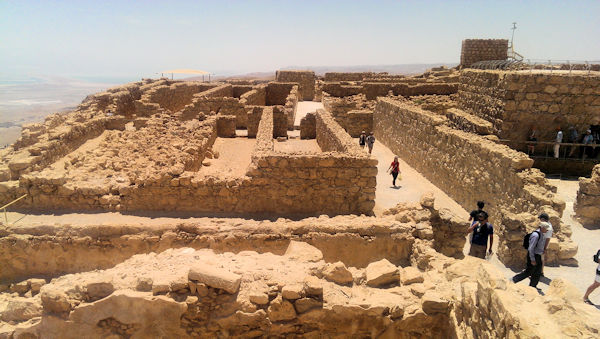 No visits to Israel are ever complete without a visit to Masada and CAARI frequently took it's
participants there. I chose the cable car route to the Masada plateau rather than the arduous
hike up the Snake Path. The views of the fortress, Herod’s palace, the Dead Sea,
the Judean hills, and of neighboring Jordan were magnificent.
No visits to Israel are ever complete without a visit to Masada and CAARI frequently took it's
participants there. I chose the cable car route to the Masada plateau rather than the arduous
hike up the Snake Path. The views of the fortress, Herod’s palace, the Dead Sea,
the Judean hills, and of neighboring Jordan were magnificent. Glass Art Museum: 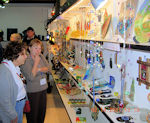 I very much enjoyed my visit with CAARI to the Glass Art Museum in Arad. Arad was to the
southwest of the Dead Sea. Gideon Friedman a superb glass artist,
who ran the museum escorted us and described his
unique and beautiful glass art, as well as works of glass art that 50 other artisans had provided
to the museum. Arad itself was of archaeological importance and we saw marked-off dig sites
along the road into Arad.
I very much enjoyed my visit with CAARI to the Glass Art Museum in Arad. Arad was to the
southwest of the Dead Sea. Gideon Friedman a superb glass artist,
who ran the museum escorted us and described his
unique and beautiful glass art, as well as works of glass art that 50 other artisans had provided
to the museum. Arad itself was of archaeological importance and we saw marked-off dig sites
along the road into Arad. Dimona: 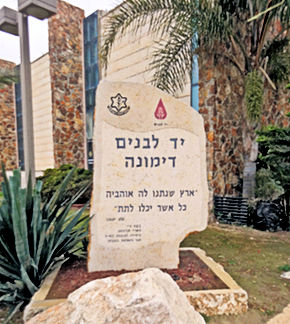 In 2017 CAARI visited the city of Dimona and had lunch with its dynamic mayor, Benny Biton.
Dimona lay in the Negev Desert, 22 miles to the west of the Dead Sea. Dimona was
one of the development towns created in the 1950s under the leadership of Prime Minister David
Ben Gurion and was settled mostly by new immigrants from Northern Africa. When Israel’s
nuclear program started during the late 1950s, a location not far from the city was chosen for
the Negev Nuclear Research Center because of its relative isolation in the desert and
the availability of housing for its workers. In 2017, Dimona was the third largest city and was
projected to triple in size by 2025.
In 2017 CAARI visited the city of Dimona and had lunch with its dynamic mayor, Benny Biton.
Dimona lay in the Negev Desert, 22 miles to the west of the Dead Sea. Dimona was
one of the development towns created in the 1950s under the leadership of Prime Minister David
Ben Gurion and was settled mostly by new immigrants from Northern Africa. When Israel’s
nuclear program started during the late 1950s, a location not far from the city was chosen for
the Negev Nuclear Research Center because of its relative isolation in the desert and
the availability of housing for its workers. In 2017, Dimona was the third largest city and was
projected to triple in size by 2025. Our tour of the city highlighted its diversity - a 7,500-strong Indian Jewish community, a 3,000 strong Black Hebrew community, an ultra-Orthodox community, immigrants from the former Soviet Union, and an expanding community of secular Jews. All get along. No matter where we went in Dimona, the atmosphere was dynamic with new construction taking place everywhere. CAARI’s visit to Dimona was extremely enlightening. Rosh Pina: 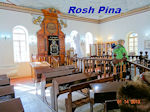 Rosh Pina lay a bit north of the Kinneret. In Rosh Pina, CAARI watched a film describing
the history of the town,
which, like Zichron Ya’akov, owed its existence to the generosity of
Baron Edmond deRothschild.
We visited the building in which Baron Rothschilds’ clerks worked, visited the original synagogue of
Rosh Pina, and had lunch in a local eatery. Lunch consisted of a family-style, all-you-can-eat,
multi-course meal that was really exceptional. The strudel and bold coffee that completed the meal
were among the best I have had. Rosh Pina was an exceedingly pleasant, but very hilly
community.
Rosh Pina lay a bit north of the Kinneret. In Rosh Pina, CAARI watched a film describing
the history of the town,
which, like Zichron Ya’akov, owed its existence to the generosity of
Baron Edmond deRothschild.
We visited the building in which Baron Rothschilds’ clerks worked, visited the original synagogue of
Rosh Pina, and had lunch in a local eatery. Lunch consisted of a family-style, all-you-can-eat,
multi-course meal that was really exceptional. The strudel and bold coffee that completed the meal
were among the best I have had. Rosh Pina was an exceedingly pleasant, but very hilly
community. Yad Hannah Sewage Treatment Plant: 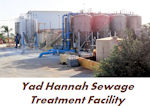 Kibbutz Yad Hannah was on Route 6, the main norht-south toll road just west of the
Arab town of Tulkarm in Samaria, and just west of the
Samaria/Israel border. The security fence separating Samaria and Israel was sometimes a barbed wire
fence and sometimes a concrete wall, which depended upon from where Arab snipers had been firing into
Israel in the past. CAARI visited the sewage treatment plant that was built to treat the sewage
emanating from Arab Samaria and which was polluting the Alexander River and the area around
Netanya.
Kibbutz Yad Hannah was on Route 6, the main norht-south toll road just west of the
Arab town of Tulkarm in Samaria, and just west of the
Samaria/Israel border. The security fence separating Samaria and Israel was sometimes a barbed wire
fence and sometimes a concrete wall, which depended upon from where Arab snipers had been firing into
Israel in the past. CAARI visited the sewage treatment plant that was built to treat the sewage
emanating from Arab Samaria and which was polluting the Alexander River and the area around
Netanya. We were shown around the sewage treatment plant and had the plant’s operation explained to us. We were told that Germany had sent money to the Palestinian Authority (PA) to build the infrastructure needed for water treatment in the area under its control. But nothing was done and the money was gone. As a result, the drinking water and the electricity in Tulkarm and in the rest of Samaria were supplied by Israel. 9/11 Memorial: 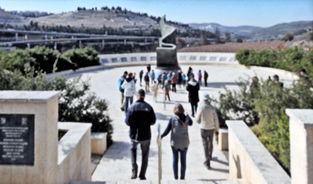 The 9/11 Memorial lay northwest of Jerusalem at the end of a narrow and winding road in the
Judean foothills. Interestingly,
The 9/11 Memorial lay northwest of Jerusalem at the end of a narrow and winding road in the
Judean foothills. Interestingly, Kennedy Memorial: 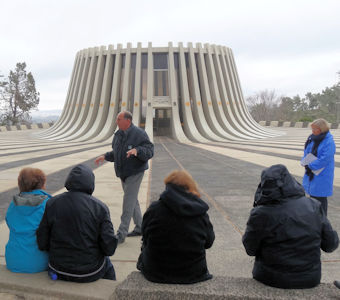 The Kennedy Memorial, or Yad Kennedy was located in the Aminadav Forest, near the
Hadassah Medical Center in Ein Kerem. It was visited by CAARI more than once.
The Memorial was 60 ft. high and its shape echoed that of a felled tree trunk, symbolic of a
life cut short. 51 slender white columns that comprised the Memorial were representative of
the 50 U.S. states plus the District of Columbia. At the center of the memorial burned an eternal
flame.
The Kennedy Memorial, or Yad Kennedy was located in the Aminadav Forest, near the
Hadassah Medical Center in Ein Kerem. It was visited by CAARI more than once.
The Memorial was 60 ft. high and its shape echoed that of a felled tree trunk, symbolic of a
life cut short. 51 slender white columns that comprised the Memorial were representative of
the 50 U.S. states plus the District of Columbia. At the center of the memorial burned an eternal
flame. Biblical Zoo: 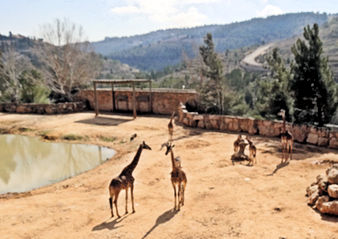 The Biblical Zoo was in the Malha Valley, 4.3 mi southwest of the center of Jerusalem.
It covered 62 acres of stunning terrain and had a large man-made lake, complete with waterfalls
and side pools, surrounded by spacious lawns and shaded areas. The park included a wildlife
savannah with free-roaming animals and a visitor’s train that provided transportation throughout
the park with several stations along the route. CAARI’s 2017 program included an excellent walking
tour of the grounds. The Jerusalem Bible Zoo was one of the better ones that I have
visited.
The Biblical Zoo was in the Malha Valley, 4.3 mi southwest of the center of Jerusalem.
It covered 62 acres of stunning terrain and had a large man-made lake, complete with waterfalls
and side pools, surrounded by spacious lawns and shaded areas. The park included a wildlife
savannah with free-roaming animals and a visitor’s train that provided transportation throughout
the park with several stations along the route. CAARI’s 2017 program included an excellent walking
tour of the grounds. The Jerusalem Bible Zoo was one of the better ones that I have
visited. Mount Gilboa: 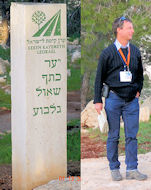 During my 2013 stay in Israel with CAARI, we visited Mount Gilboa. Mount Gilboa rose
about 2,000 ft. above the Jezreel Valley. To the east, one could see into
Jordan. Just to the south lay Jenin and the Palestinian “West
Bank”. Below was the fertile Jezreel Valley. Mt. Gilboa, along with much of Israel,
had been reforested by JNF
During my 2013 stay in Israel with CAARI, we visited Mount Gilboa. Mount Gilboa rose
about 2,000 ft. above the Jezreel Valley. To the east, one could see into
Jordan. Just to the south lay Jenin and the Palestinian “West
Bank”. Below was the fertile Jezreel Valley. Mt. Gilboa, along with much of Israel,
had been reforested by JNF Some 3,000 years ago, the Israelites were defeated by the Philistines on Mount Gilboa. Israel’s first king, Saul, was mortally wounded and took his own life there. In a eulogy for King Saul and his son, Jonathon, the soon-to-be king, David, cursed the Mount Gilboa battlefield with the words, “Let there be no dew or rain upon you.” In spite of the curse, JNF had caused the battlefield to sprout new greenery. We drove northwest along the crest of Mount Gilboa, stopping at scenic overlooks to take in the spectacular scenery. Kibbutz Negba: 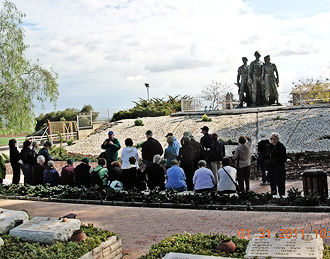 On my first trip to Israel with CAARI in 2011, we visited Kibbutz Negba where Meir
Mindel, the kibbutz historian served as our guide. The kibbutz was founded in 1939 as a
“tower and stockade settlement” and was erected in a single night. In 6 days of
fighting during
the War of Independence, the vastly outnumbered defenders of the kibbutz halted the Egyptian
army’s drive north – the only kibbutz in the south of Israel to withstand the Egyptian advance.
It was one of the major turning points of the war. We visited the graves of several of the
defenders, viewed a large sculpture memorializing the heroes of Kibbutz Negba, saw some relics
of the fighting and toured the kibbutz on our bus.
On my first trip to Israel with CAARI in 2011, we visited Kibbutz Negba where Meir
Mindel, the kibbutz historian served as our guide. The kibbutz was founded in 1939 as a
“tower and stockade settlement” and was erected in a single night. In 6 days of
fighting during
the War of Independence, the vastly outnumbered defenders of the kibbutz halted the Egyptian
army’s drive north – the only kibbutz in the south of Israel to withstand the Egyptian advance.
It was one of the major turning points of the war. We visited the graves of several of the
defenders, viewed a large sculpture memorializing the heroes of Kibbutz Negba, saw some relics
of the fighting and toured the kibbutz on our bus. Yad Mordechai Kibbutz: 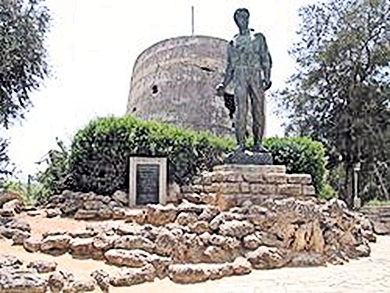 The Yad Mordechai Kibbutz was founded in the 1930s by Hashomer Hatzair members
from Poland and was not far from Kibbutz Negba. The community moved to an
area near Ashkelon in 1943 and named it in honor of Mordechai Anielewicz,
who was killed, leading the Warsaw Ghetto uprising.
Kibbutz Negba was the first kibbutz in the south attacked by the Egyptian army in 1948 and was overrun after
6 days of fighting. In 2011, CAARI visited the battlefield memorial to the kibbutz
defenders.
The Yad Mordechai Kibbutz was founded in the 1930s by Hashomer Hatzair members
from Poland and was not far from Kibbutz Negba. The community moved to an
area near Ashkelon in 1943 and named it in honor of Mordechai Anielewicz,
who was killed, leading the Warsaw Ghetto uprising.
Kibbutz Negba was the first kibbutz in the south attacked by the Egyptian army in 1948 and was overrun after
6 days of fighting. In 2011, CAARI visited the battlefield memorial to the kibbutz
defenders. Kibbutz Nizzanim:  In 2012, CAARI visited Kibbutz Nizzanim in northeast Negev. The kibbutz was established
after the JNF purchased a 400-acre plot of land and a large house in 1942. The first
residents were immigrants, some Holocaust survivors, and it later absorbed more immigrants
from Poland and Romania. Nizzanim was captured by the Egyptian army during the 1948
Arab-Israeli war, but was recaptured by Israeli forces at the end of the conflict,
after which the settlement was re-established south of the original location.
In 2012, CAARI visited Kibbutz Nizzanim in northeast Negev. The kibbutz was established
after the JNF purchased a 400-acre plot of land and a large house in 1942. The first
residents were immigrants, some Holocaust survivors, and it later absorbed more immigrants
from Poland and Romania. Nizzanim was captured by the Egyptian army during the 1948
Arab-Israeli war, but was recaptured by Israeli forces at the end of the conflict,
after which the settlement was re-established south of the original location. In the Battle of Nizzanim, Miriam Ben-Ari was one of 10 women who had remained to help defend Nizzanim alongside the 130 men there. The wounded commander and Ben-Ari, tried to negotiate with the Egyptians, but the commander was shot by an Egyptian officer. In response, Ben-Ari shot the Egyptian officer responsible and she was killed on the spot. The site was later turned into a memorial to Israel’s women soldiers, with the Women of Valor Monument serving as a memorial for all female warriors killed in action in Israel's wars, especially the three in Nizzanim. Haluziot Communities: 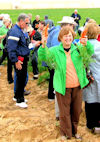 The Haluziot Communities in the northern Negev were established to house Israeli
families that had originally settled in the Sinai, following Israel’s victory in the
6-day War of 1967. They had relocated to the Gush Khatif bloc of the Gaza Strip
when Israel returned the Sinai Peninsula to Egypt as part of the Israel-Egypt Peace Treaty
of 1979. They remained there until all Israeli settlements were ordered out of the Strip
in August 2005. When I visited the Haluziot Communities with CAARI in 2012, they were new,
with some being only 6 months old at the time. But, they were already proving to be a
success. All were in a state of construction and growth. During our visit, we could see
large areas of desert sand, as well as well-tended fields of green as far as the eye could
see where large juicy carrots were being grown. We got a chance to pick and taste the
organically grown carrots from one of the fields. Driving through the community, we saw
many new buildings, a playground, and other elements of the community infrastructure,
many of which were still under construction. Security was tight, seeing as the Haluziot
Communities were right on the borders with Gaza and Egypt.
The Haluziot Communities in the northern Negev were established to house Israeli
families that had originally settled in the Sinai, following Israel’s victory in the
6-day War of 1967. They had relocated to the Gush Khatif bloc of the Gaza Strip
when Israel returned the Sinai Peninsula to Egypt as part of the Israel-Egypt Peace Treaty
of 1979. They remained there until all Israeli settlements were ordered out of the Strip
in August 2005. When I visited the Haluziot Communities with CAARI in 2012, they were new,
with some being only 6 months old at the time. But, they were already proving to be a
success. All were in a state of construction and growth. During our visit, we could see
large areas of desert sand, as well as well-tended fields of green as far as the eye could
see where large juicy carrots were being grown. We got a chance to pick and taste the
organically grown carrots from one of the fields. Driving through the community, we saw
many new buildings, a playground, and other elements of the community infrastructure,
many of which were still under construction. Security was tight, seeing as the Haluziot
Communities were right on the borders with Gaza and Egypt. Atlit: 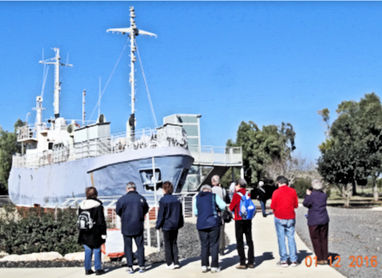 Beginning In 1939, Britain severely restricted Jewish immigration into Palestine.
Legal immigrants were detained at Atlit, just south of Haifa, before being given
papers allowing them entry into Palestine. As the situation for Jews worsened during
and immediately following World War II, thousands fled to Palestine. The British
used Atlit as a detention camp for the Holocaust survivors who made it Palestine and
were apprehended. In 2016, our CAARI group had a guided tour of the restored detention
camp, which included some excellent audio-visual presentations. It was a very interesting
visit and one that I would recommend to all visitors to Israel.
Beginning In 1939, Britain severely restricted Jewish immigration into Palestine.
Legal immigrants were detained at Atlit, just south of Haifa, before being given
papers allowing them entry into Palestine. As the situation for Jews worsened during
and immediately following World War II, thousands fled to Palestine. The British
used Atlit as a detention camp for the Holocaust survivors who made it Palestine and
were apprehended. In 2016, our CAARI group had a guided tour of the restored detention
camp, which included some excellent audio-visual presentations. It was a very interesting
visit and one that I would recommend to all visitors to Israel. Israel Guide Dog Center for the Blind: 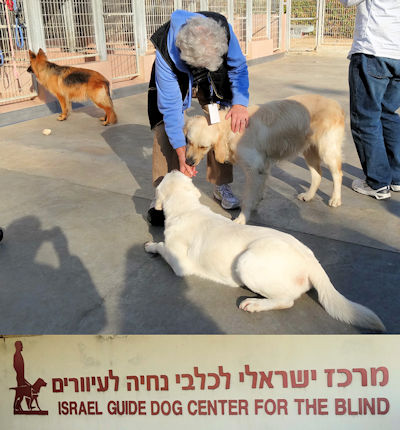 The Israel Guide Dog Center for the Blind began operations on January 1, 1991 and was located
just twenty minutes south of Tel Aviv and just west of Rehovot
in Beit Oved. In 2014,
CAARI toured the Center with the staff explaining the training process and guiding us through
the state-of-the-art facilities. We got a chance to say hello to some of the dogs undergoing
training.
The Israel Guide Dog Center for the Blind began operations on January 1, 1991 and was located
just twenty minutes south of Tel Aviv and just west of Rehovot
in Beit Oved. In 2014,
CAARI toured the Center with the staff explaining the training process and guiding us through
the state-of-the-art facilities. We got a chance to say hello to some of the dogs undergoing
training. Tiberias: 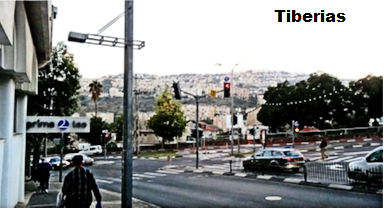 Tiberias, on the shores of the Sea of Galilee, was regarded by Jews and Christians as a
holy city. CAARI stayed there for 5 nights in 2016. Tiberias’s 20,000 residents were
overwhelmingly Jewish with a large percentage being orthodox Jews. The orthodox and
secular segments of the population got along well. From Tiberias’s Old City and the
promenade, there was a central boardwalk that stretched up to the downtown which was a lively
commercial center, with varied restaurants, cafes, pubs, ice cream parlors and souvenir
shops. The fishing industry of Tiberias was highly developed and dozens of fishing boats
headed onto the lake every morning, returning later in the day with fresh fish for sale at
the fish market. Alongside Christian holy sites in and near Tiberias, there were the burial
sites of Jewish sages, including the tombs of Rabbi Akiva, Rabbi Yochanan
Ben-Zakai, Rabbi Meir Baal HaNess, and the great philosopher and
sage Maimonides.
Tiberias, on the shores of the Sea of Galilee, was regarded by Jews and Christians as a
holy city. CAARI stayed there for 5 nights in 2016. Tiberias’s 20,000 residents were
overwhelmingly Jewish with a large percentage being orthodox Jews. The orthodox and
secular segments of the population got along well. From Tiberias’s Old City and the
promenade, there was a central boardwalk that stretched up to the downtown which was a lively
commercial center, with varied restaurants, cafes, pubs, ice cream parlors and souvenir
shops. The fishing industry of Tiberias was highly developed and dozens of fishing boats
headed onto the lake every morning, returning later in the day with fresh fish for sale at
the fish market. Alongside Christian holy sites in and near Tiberias, there were the burial
sites of Jewish sages, including the tombs of Rabbi Akiva, Rabbi Yochanan
Ben-Zakai, Rabbi Meir Baal HaNess, and the great philosopher and
sage Maimonides. Ginosar: 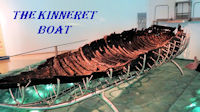 Kibbutz Ginosar was on the Kinneret (Sea of Galilee) Which, at 700-feet below
sea level, was the lowest body of fresh-water on the earth. In Ginosar, CAARI visited
the Yigal Allon Centre where the 2,000 year old “Kinneret Boat”
or “Jesus Boat”
that was brought up from the mud of the Kinneret in 1986 was housed. I viewed the boat
and walked to the dock that marked the location where the Jesus Boat was discovered
when the level of the Kinneret had dropped during the long drought that exposed the boat.
Kibbutz Ginosar was on the Kinneret (Sea of Galilee) Which, at 700-feet below
sea level, was the lowest body of fresh-water on the earth. In Ginosar, CAARI visited
the Yigal Allon Centre where the 2,000 year old “Kinneret Boat”
or “Jesus Boat”
that was brought up from the mud of the Kinneret in 1986 was housed. I viewed the boat
and walked to the dock that marked the location where the Jesus Boat was discovered
when the level of the Kinneret had dropped during the long drought that exposed the boat. The Golan: 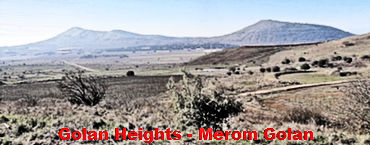 CAARI had frequently visited the Golan region of Israel. It abutted Syria and
frequently gunfire from the Syrian civil war could be heard. The northern Golan had many
hills and mountains, mostly of volcanic origin and the fields were strewn with numerous
rocks and boulders. Stone foundations of numerous old and ancient buildings dotted the
countryside. There was a considerable amount of agriculture there - apples, cherries,
kiwis and other produce.
CAARI had frequently visited the Golan region of Israel. It abutted Syria and
frequently gunfire from the Syrian civil war could be heard. The northern Golan had many
hills and mountains, mostly of volcanic origin and the fields were strewn with numerous
rocks and boulders. Stone foundations of numerous old and ancient buildings dotted the
countryside. There was a considerable amount of agriculture there - apples, cherries,
kiwis and other produce. In 2016, CAARI had a Jeep tour through the Quneitra Valley overlooking Syria. The ride up and back to our viewing location was not for the faint of heart – the route was mostly unpaved, rutted, strewn with rocks and some of the inclines were unbelievably steep. During the ride, we passed an Israeli Centurion tank that was put out of action in the fierce fighting between Syria and Israel in the 1973 Yom Kippur War. A number of these destroyed tanks had been left where they were disabled as a memorial to the many Israeli soldiers killed in the Yom Kippur War. Katzrin & Gamla: 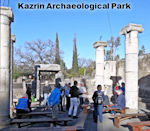 CAARI visited the Katzrin and Gamla archaeological sites in the Upper Galilee region of Israel.
In Katzrin, an ancient village and a synagogue had been reconstructed and opened to the public
as a "Talmudic Village" set in a national park. The Golan Antiquities Museum,
which we visited,
housed archeological findings from the region. Gamla was a nearby Jewish town that unsuccessfully
fought the Romans in the 1st century. Gamla existed around the time of the Maccabees
on a steep hill shaped like a camel’s hump, hence its name, which derives from the Hebrew
word for camel – Gamal. Josephus Flavius provided a detailed written description
of the Roman siege and conquest of Gamla
in 67 A.D. According to Josephus, some 4,000 inhabitants were slaughtered, while 5,000, trying
to escape down the steep northern slope, were either trampled to death, fell or perhaps
threw themselves down a ravine.
CAARI visited the Katzrin and Gamla archaeological sites in the Upper Galilee region of Israel.
In Katzrin, an ancient village and a synagogue had been reconstructed and opened to the public
as a "Talmudic Village" set in a national park. The Golan Antiquities Museum,
which we visited,
housed archeological findings from the region. Gamla was a nearby Jewish town that unsuccessfully
fought the Romans in the 1st century. Gamla existed around the time of the Maccabees
on a steep hill shaped like a camel’s hump, hence its name, which derives from the Hebrew
word for camel – Gamal. Josephus Flavius provided a detailed written description
of the Roman siege and conquest of Gamla
in 67 A.D. According to Josephus, some 4,000 inhabitants were slaughtered, while 5,000, trying
to escape down the steep northern slope, were either trampled to death, fell or perhaps
threw themselves down a ravine. Tel Chai: 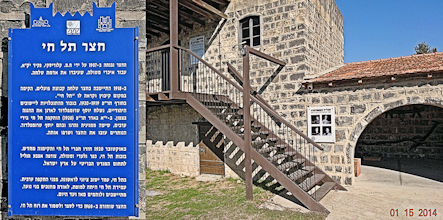 At Tel Chai, we were treated to a guided tour with spirited descriptions of the events
that had made the courtyard at Tel Chai famous in Israeli history.
At Tel Chai, we were treated to a guided tour with spirited descriptions of the events
that had made the courtyard at Tel Chai famous in Israeli history. During the 1st Aliyah period from about 1870 to 1900, Russian immigrants arrived in order to escape the pogroms of Czarist Russia. The 2nd wave arrived during 1900 - 1920, again, primarily as the result of Russian pogroms. These early Zionists settled the land and mainly turned to farming. Bands of Arabs harassed and attacked them from time to time, necessitating the formation of a Jewish self-defense organization, named the Shomerim (guardians). The Battle of Tel Chai was fought in March 1920 between Arabs and Jewish settlers who had been trained as Shomerim. As a result of the fighting, six Jews and five Arabs were killed. Joseph Trumpeldor, the commander of Jewish defenders of Tel Chai, was among those killed. The event was seen in Israel as the first armed resistance by a Jewish settlement to Arab marauders. Following the attack, Jews returned to Tel Chai, Kfar Giladi, and Metula. Because of Jewish presence in these settlements, the San Remo Conference, convened by the League of Nations, later included the Hula Valley as far north as Metula in the British Mandate which then led to the inclusion of the Hula Valley in the State of Israel rather than in what became Lebanon. Joseph Trumpeldor had served as an officer in the Russian Army during the Russian-Japanese War of 1905, being one of the few Russian Jews to gain a commission under the Czar. He lost an arm during the fighting. He had also commanded a Jewish auxiliary unit fighting together with the British Army during the Gallipoli Campaign of the First World War. As such, he was a well experienced military man. In the fight at Tel Chai, Trumpeldor was shot and seriously wounded. Before dying, he uttered the famous words, "No matter, it is good to die for our country". 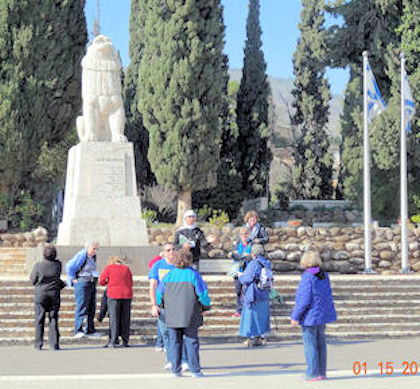 The eight Jews killed at Tel Chai (two were killed in a
previous probing attack in January 1920) were buried in two common graves in nearby
Kfar Giladi. Trumpeldor’s last words appear on the Lion Monument at the
Shomerim Cemetery
in Kfar Giladi, along with the names of the eight who died at Tel Chai. The city of
Kiryat Shemona, literally Town of the Eight was named after them.
The Shomerim was the first Jewish defense
organization in what was then called Palestine. From the Shomerim came the Haganah and the
Palmach which were the forerunners of today’s Israel Defense Forces (IDF).
The eight Jews killed at Tel Chai (two were killed in a
previous probing attack in January 1920) were buried in two common graves in nearby
Kfar Giladi. Trumpeldor’s last words appear on the Lion Monument at the
Shomerim Cemetery
in Kfar Giladi, along with the names of the eight who died at Tel Chai. The city of
Kiryat Shemona, literally Town of the Eight was named after them.
The Shomerim was the first Jewish defense
organization in what was then called Palestine. From the Shomerim came the Haganah and the
Palmach which were the forerunners of today’s Israel Defense Forces (IDF). Metula:  I twice visited Metula - the northernmost city in Israel. Modern Metula was founded in
June 1896. Most of the founders were immigrants from Russia. Metula was situated on the
very northern edge of Israel right on the Israel-Lebanon border. The Good Fence was
close by the Canada Center in Metula. It was a border crossing between
Israel and Lebanon that allowed the people of southern Lebanon to find jobs in
northern Israel, access health services, attend school in Israel, and transport
goods across the border. It was closed after Arab terrorists began committing attacks in
Northern Israel. CAARI was escorted on a tour of the Canada Center in Metula - an impressive
sports and recreational facility that included an ice hockey rink - built with the
generous help of Canadian Jewry.
I twice visited Metula - the northernmost city in Israel. Modern Metula was founded in
June 1896. Most of the founders were immigrants from Russia. Metula was situated on the
very northern edge of Israel right on the Israel-Lebanon border. The Good Fence was
close by the Canada Center in Metula. It was a border crossing between
Israel and Lebanon that allowed the people of southern Lebanon to find jobs in
northern Israel, access health services, attend school in Israel, and transport
goods across the border. It was closed after Arab terrorists began committing attacks in
Northern Israel. CAARI was escorted on a tour of the Canada Center in Metula - an impressive
sports and recreational facility that included an ice hockey rink - built with the
generous help of Canadian Jewry. Safed: 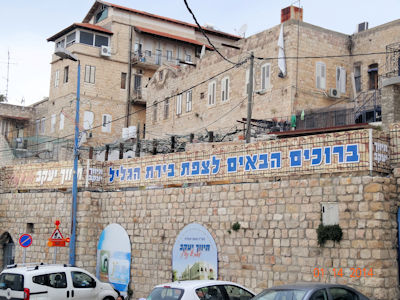 CAARI frequently included visits to Safed in its programs. The ancient city of Safed was a rather
small town, 3,200 feet above sea level in the mountains of the Upper Galilee.
According to the great mystics of the past, Safed was to play an important role in the
final redemption – one said that the Messiah would come from Safed on his way to Jerusalem
and another said that until the Third Temple was built, the Shechinah
(God's Manifest Presence) rested above Safed. The city flourished in the 16th century,
when many famous Jewish religious scholars and mystics moved to Safed following
the Spanish Expulsion and the Inquisition. Safed then became the
spiritual center of the Jewish world, where Kabbalah (Jewish mysticism) reached
the peak of its influence. Safed was one of the 4 holy cities in Israel, together with
Jerusalem, Hebron and Tiberias. The old part of town consisted
of narrow cobblestone alleys, revealing artists' galleries, medieval synagogues, private
homes and small guest houses.
CAARI frequently included visits to Safed in its programs. The ancient city of Safed was a rather
small town, 3,200 feet above sea level in the mountains of the Upper Galilee.
According to the great mystics of the past, Safed was to play an important role in the
final redemption – one said that the Messiah would come from Safed on his way to Jerusalem
and another said that until the Third Temple was built, the Shechinah
(God's Manifest Presence) rested above Safed. The city flourished in the 16th century,
when many famous Jewish religious scholars and mystics moved to Safed following
the Spanish Expulsion and the Inquisition. Safed then became the
spiritual center of the Jewish world, where Kabbalah (Jewish mysticism) reached
the peak of its influence. Safed was one of the 4 holy cities in Israel, together with
Jerusalem, Hebron and Tiberias. The old part of town consisted
of narrow cobblestone alleys, revealing artists' galleries, medieval synagogues, private
homes and small guest houses. I visited the old Synagogues there, shopped for Magen David’s (Stars of David) and a shofar (ram’s horn) for my grandchildren, wandered its ancient and fascinating streets, and enjoyed eating in its various small restaurants. Safed was a great place to relax, away from the hustle and bustle of Israel’s big cities. Hula Nature Reserve: 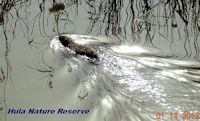 More than 60 years ago, the Hula Valley was drained to get rid of the swamps
that were there. Since then, it had become obvious that the draining adversely impacted
the ecology of the valley, which was a major stopping point for birds on their twice-a-year
transits between Europe and Africa. The Hula Valley in the Galilee was being re-flooded
to return it to its earlier status when visited by CAARI in 2013. A small portion of the
Hula Valley was retained as the Hula Valley Nature Reserve for people to visit.
More than 60 years ago, the Hula Valley was drained to get rid of the swamps
that were there. Since then, it had become obvious that the draining adversely impacted
the ecology of the valley, which was a major stopping point for birds on their twice-a-year
transits between Europe and Africa. The Hula Valley in the Galilee was being re-flooded
to return it to its earlier status when visited by CAARI in 2013. A small portion of the
Hula Valley was retained as the Hula Valley Nature Reserve for people to visit. CAARI started its visit to the Reserve by watching an immersive 3-D movie that described the Reserve. From the observation sites on the nature trail, we could clearly see the snow-covered Mount Hermon at the northeast corner of the Golan Heights, several species of birds, water buffaloes and a furry animal which I took to be a muskrat. Agamon Hula: 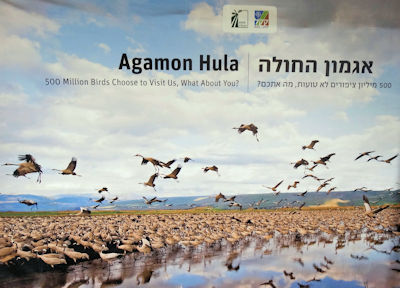 CARRI’s visits to Agamon Hula typically included riding around the nature preserve in
a special “bird hide” pulled by a tractor that enabled us to reach the roosting areas
of the migrating cranes and other birds that stopped there on their annual migrations to
and from Europe and Asia to Africa. Agamon Hula was located in the southern part of the
Hula Valley and had become the second home for millions of migrating birds in the
autumn and spring. At the times of CAARI visits, there were tens of thousands of
cranes at Agamon Hula, as well as numerous other birds and mammals. An ornithologist
described the various birds and their characteristics to us as we drove though
the reserve.
CARRI’s visits to Agamon Hula typically included riding around the nature preserve in
a special “bird hide” pulled by a tractor that enabled us to reach the roosting areas
of the migrating cranes and other birds that stopped there on their annual migrations to
and from Europe and Asia to Africa. Agamon Hula was located in the southern part of the
Hula Valley and had become the second home for millions of migrating birds in the
autumn and spring. At the times of CAARI visits, there were tens of thousands of
cranes at Agamon Hula, as well as numerous other birds and mammals. An ornithologist
described the various birds and their characteristics to us as we drove though
the reserve. Beit She’an:  Beit She’an, the largest archaeological dig in Israel was located in the Jezreel
Valley. It was one of the most ancient cities in Israel and was just 3 miles west of
the Jordan River. The extensive ruins at Beit She’an were in excellent condition.
Archaeological activity had been dormant in Beit She’an for the past decade or so.
Walking though Beit She’an and examining the remnants of its ancient glory was an exciting
and informative experience.
Beit She’an, the largest archaeological dig in Israel was located in the Jezreel
Valley. It was one of the most ancient cities in Israel and was just 3 miles west of
the Jordan River. The extensive ruins at Beit She’an were in excellent condition.
Archaeological activity had been dormant in Beit She’an for the past decade or so.
Walking though Beit She’an and examining the remnants of its ancient glory was an exciting
and informative experience. Gan Garoo: 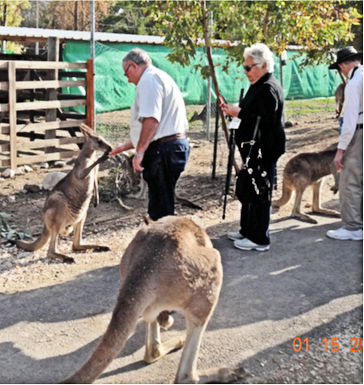 Gan Garoo was a park with animals and vegetation from Australia. The park
name comes from the Hebrew name for garden “gan” and the last two syllables of
kangaroo. Gan Garoo was located at Kibbutz Nir David in the Jezreel
Valley not far from Beit She’an. At the park, there were kangaroos,
emus, parrots, bats, Australian sheep, and koalas.
In 2016, CAARI took a guided tour of the park, which started with a visit to an area
in which several wombats hung from the ceiling. In an aviary, we fed the parrots
there who would sit on our heads or shoulders while feeding. Touching and feeding the
kangaroos was allowed in designated areas and several kangaroos came up to be fed
by hand and petted.
Gan Garoo was a park with animals and vegetation from Australia. The park
name comes from the Hebrew name for garden “gan” and the last two syllables of
kangaroo. Gan Garoo was located at Kibbutz Nir David in the Jezreel
Valley not far from Beit She’an. At the park, there were kangaroos,
emus, parrots, bats, Australian sheep, and koalas.
In 2016, CAARI took a guided tour of the park, which started with a visit to an area
in which several wombats hung from the ceiling. In an aviary, we fed the parrots
there who would sit on our heads or shoulders while feeding. Touching and feeding the
kangaroos was allowed in designated areas and several kangaroos came up to be fed
by hand and petted. Utopia Orchid Park: 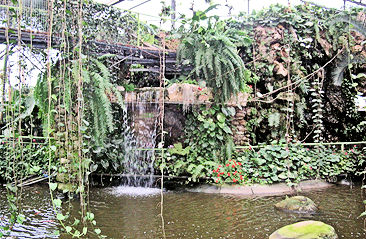 CAARI visited the Utopia Orchid Park in 2011. The park was located in Kibbutz Bahan,
northeast of Netanya. The tropical rain forest environment was fascinating with
thousands of orchids from around the world, various tropical plants, birds, animals, fish
and bug eating plants.
CAARI visited the Utopia Orchid Park in 2011. The park was located in Kibbutz Bahan,
northeast of Netanya. The tropical rain forest environment was fascinating with
thousands of orchids from around the world, various tropical plants, birds, animals, fish
and bug eating plants. Kfar Tikva and the Tulip Winery:  The Tulip Winery and Kfar Tikva (Village of Hope) were located southeast of
Haifa at the western end of the Jezreel Valley adjacent to the town of
Kiryat Tivon. The town
was a very pretty and upscale suburban town. The nearby
Tulip Winery integrated the production of quality wines with social responsibility
and was located on a mountainside in Kfar Tikva. Kfar Tikvaa was small pastoral settlement whose
population consisted of people with special needs. 50% of the winery’s profits went to
support Kfar Tikva and the winery also provided jobs its residents.
Most members of Kfar Tikva lived in the village itself and the remainder lived in apartments
scattered around the town of Kiryat Tivon. Those in Kiryat Tivon were integrated into the
local community. Most of the residents lived independently in their homes while some
required partial or full supervision. People with special needs in Israel received support
from the government until the age of 21. Kfar Tikva filled the need for these people
after they reached the age of 21. In 2016, CAARI had a tour of the village and the winery,
at which we sampled the winery's products.
The Tulip Winery and Kfar Tikva (Village of Hope) were located southeast of
Haifa at the western end of the Jezreel Valley adjacent to the town of
Kiryat Tivon. The town
was a very pretty and upscale suburban town. The nearby
Tulip Winery integrated the production of quality wines with social responsibility
and was located on a mountainside in Kfar Tikva. Kfar Tikvaa was small pastoral settlement whose
population consisted of people with special needs. 50% of the winery’s profits went to
support Kfar Tikva and the winery also provided jobs its residents.
Most members of Kfar Tikva lived in the village itself and the remainder lived in apartments
scattered around the town of Kiryat Tivon. Those in Kiryat Tivon were integrated into the
local community. Most of the residents lived independently in their homes while some
required partial or full supervision. People with special needs in Israel received support
from the government until the age of 21. Kfar Tikva filled the need for these people
after they reached the age of 21. In 2016, CAARI had a tour of the village and the winery,
at which we sampled the winery's products. Galil Mountain Winery: 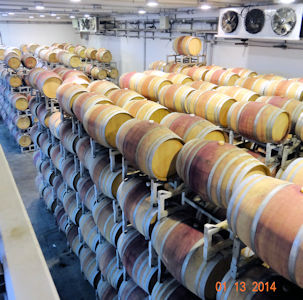 The Galil Mountain Winery was in Kibbutz Yiron, near the Lebanon border. It was a modern,
medium size Israeli winery. Our visit to the winery included a tour, a detailed explanation of
wine making, an excellent lunch, and wound up with a wine tasting session. All wines produced at
the winery were kosher and dry. Many excellent wines came from Israel, with some wineries, like
the Galil Mountain Winery in Israel's north and others, like the Yatir Winery,
in Israel's south.
The Galil Mountain Winery was in Kibbutz Yiron, near the Lebanon border. It was a modern,
medium size Israeli winery. Our visit to the winery included a tour, a detailed explanation of
wine making, an excellent lunch, and wound up with a wine tasting session. All wines produced at
the winery were kosher and dry. Many excellent wines came from Israel, with some wineries, like
the Galil Mountain Winery in Israel's north and others, like the Yatir Winery,
in Israel's south. Yatir Winery: 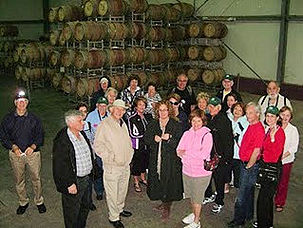 The Yatir winery was located in Arad, just southwest
of the Dead Sea. It was a boutique winery that produced limited quantities of strictly kosher,
high quality red and white wines. After being shown how they produce their wines, CAARI
enjoyed sampling some of the winery’s excellent products. Arad was a famous wine producing
region of Israel in Biblical times.
The Yatir winery was located in Arad, just southwest
of the Dead Sea. It was a boutique winery that produced limited quantities of strictly kosher,
high quality red and white wines. After being shown how they produce their wines, CAARI
enjoyed sampling some of the winery’s excellent products. Arad was a famous wine producing
region of Israel in Biblical times. Carmel Winery: 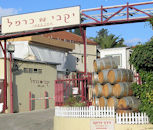 in 1885 Baron de Rothschild helped to establish the first winery in Israel,
the Carmel Winery, together with a bottling factory. Carmel Winery in Zichron Ya’akov
remained as a highly successful enterprise and the facility there included the huge wine cellars
that were carved into the mountain over a century ago. At the winery, CAARI was greeted with a
talk and video presentation about the history of the winery and the modern history of wine
making in Israel. Then we toured the old wine cellar that was built over a hundred years
ago and saw the many oak wine casks lining the walls of the cellar. Finally, we joined in a
bit of wine tasting in the wine cellar, accompanied by an explanation of the types of wine
produced by the winery.
in 1885 Baron de Rothschild helped to establish the first winery in Israel,
the Carmel Winery, together with a bottling factory. Carmel Winery in Zichron Ya’akov
remained as a highly successful enterprise and the facility there included the huge wine cellars
that were carved into the mountain over a century ago. At the winery, CAARI was greeted with a
talk and video presentation about the history of the winery and the modern history of wine
making in Israel. Then we toured the old wine cellar that was built over a hundred years
ago and saw the many oak wine casks lining the walls of the cellar. Finally, we joined in a
bit of wine tasting in the wine cellar, accompanied by an explanation of the types of wine
produced by the winery. Old Gesher: 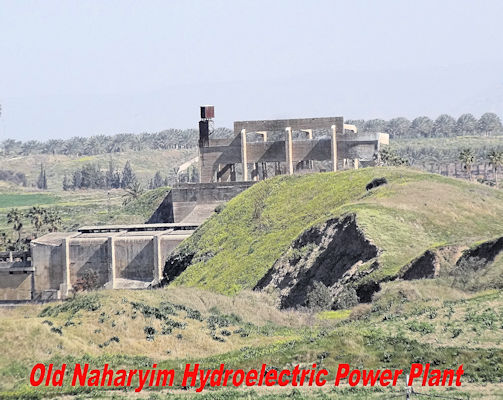 I visited old Gesher with CAARI in 2014. The original Gesher kibbutz was built on the
eastern side of the Jordan River, making it the only kibbutz on that side of the river.
After the 1948 War of Independence, the kibbutz was moved a short distance to
the west side of the river where it has remained. Gesher means bridge in Hebrew and,
at the site of Kibbutz Gesher, there were three bridges that spanned the Jordan River -
one built prior to the Crusades (before 1200), one built by the Ottoman Turks in 1904,
and one built by the British in 1925. There were also the ruins of an ancient wayside
inn from the 14th century here.
I visited old Gesher with CAARI in 2014. The original Gesher kibbutz was built on the
eastern side of the Jordan River, making it the only kibbutz on that side of the river.
After the 1948 War of Independence, the kibbutz was moved a short distance to
the west side of the river where it has remained. Gesher means bridge in Hebrew and,
at the site of Kibbutz Gesher, there were three bridges that spanned the Jordan River -
one built prior to the Crusades (before 1200), one built by the Ottoman Turks in 1904,
and one built by the British in 1925. There were also the ruins of an ancient wayside
inn from the 14th century here. The Naharayim Power Plant at Gesher was built on the eastern side of the Jordan River adjacent to Kibbutz Gesher. It began functioning in 1932 and ceased operation in 1948. The old hydroelectric power plant - built by Pinchas Rotenberg, dubbed "the Old Man from Naharayim" - was built near the junction of the Jordan and Yarmouk Rivers, hence the name Naharayim, meaning “two rivers” in Hebrew. When it went on-line, the plant supplied 90% of all electrical power in the British Mandate of Palestine. On our visit to Old Gesher, we were shown a recreation of the old power plant and watched a light and sound show that gave the visitor a feeling for the power plant that once was. From the kibbutz, we passed through a gate in the border fence and entered land that was under control of Jordan. We toured the original underground shelter of Kibbutz Gesher that was used as the central command room during the battles of the War of Independence and we viewed a movie in the old dining room building that told the story of the area's first Jewish settlements, from the early 1900's to the battles of the War of Independence. A visit to Old Gesher is well worthwhile. The exhibits, audio-visual presentations and the guided tour were all very well done. Center for Special Studies in Memory of the Fallen of Israel's Intelligence Community: 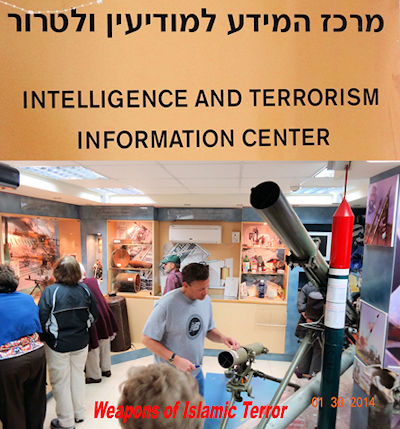 The Center for Special Studies in Memory of the Fallen of Israel's Intelligence Community
(Also known by its shortened name of the Center for Special Studies) was an Israeli think
tank established in 2001 by a former IDF intelligence officer. It was an Israeli-based
independent research group with close ties to the Israel Defense Forces and the
American Jewish Congress (AJC). It had been described as the "public face of Israeli
intelligence" and as a "pipeline" for the release of information that Israeli
military intelligence did not want to be directly associated with.
The Center for Special Studies in Memory of the Fallen of Israel's Intelligence Community
(Also known by its shortened name of the Center for Special Studies) was an Israeli think
tank established in 2001 by a former IDF intelligence officer. It was an Israeli-based
independent research group with close ties to the Israel Defense Forces and the
American Jewish Congress (AJC). It had been described as the "public face of Israeli
intelligence" and as a "pipeline" for the release of information that Israeli
military intelligence did not want to be directly associated with. The center was located in Ramat Hasharon, a suburb just north of Tel Aviv’s Yarkon River and southeast of Herzliya. Surrounded by a library, an auditorium and an amphitheater, the center of the memorial consisted of a labyrinth of sandstone walls divided into five shaded alcoves, each representing a period in the history of Israel`s intelligence operations. The names of the spies who died in each period were etched into the stone walls. No ranks or agency affiliations were mentioned. Immediately nearby were many of Israel’s intelligence facilities. CAARI received a guided tour of the Center, viewed films describing Israel’s intelligence activities and the various aspects of Israel’s intelligence operations. The Center also housed a synagogue, a contemplation area, and exhibit rooms containing weapons, documents, and anti-Semitic and anti-Israel propaganda material captured from the PLO, Hamas, Hezbollah and a number of other Muslim and Arab terrorist organizations. We viewed captured explosives, rockets, and documents. The Arab/terrorist propaganda contained unbelievable distortions of history and facts in their attempts to vilify and demonize Jews, Christians, Israel and the United States. Our tour guides, all former members of the Israeli intelligence community, emphasized one unique aspect of Israeli intelligence – it was not only responsible for protecting Israel’s security, but it was also responsible for protecting and aiding all Jews around the world. Beit Hagedudim: 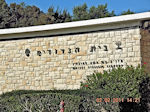 Beit Hagedudim, near Netanya, was the Museum of the Jewish Brigade.
The Beit Hagedudim told the story of Jewish soldiers who volunteered to served in the
British army during the two world wars. In 1932, the veterans from the Jewish Legion of
World War I established the Avi Chayil Moshav (Avi Chayil means “my father
was a soldier”) where the museum is located. In 1961, the museum was dedicated to
the Jewish Legion of World War I and Jewish Brigade of World War II.
Beit Hagedudim, near Netanya, was the Museum of the Jewish Brigade.
The Beit Hagedudim told the story of Jewish soldiers who volunteered to served in the
British army during the two world wars. In 1932, the veterans from the Jewish Legion of
World War I established the Avi Chayil Moshav (Avi Chayil means “my father
was a soldier”) where the museum is located. In 1961, the museum was dedicated to
the Jewish Legion of World War I and Jewish Brigade of World War II. The Jewish Legion was started by the famous Zev Jabotinski and Joseph Trumpeldor. Most of the founders of the modern State of Israel were either veterans of the Jewish Brigade or their fathers were. Members of the Jewish Legion and Jewish Brigade received military training from the British which proved to be essential for Israel winning its War of Independence in 1948. I visited the museum with CAARI in 2014. Kibbutz Sedot Yam: 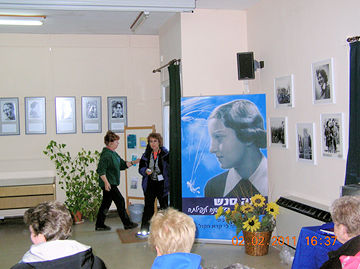 Kibbutz Sedot Yam was on the Mediterranean seacoast on southern border of
Caesarea. Located there was the Hannah Senesh Museum. Senesh, a poet, lived
at the kibbutz after she came to Israel from her native Hungary.
After parachuting into Hungary during WWII, she was killed at age 23 by the pro-Nazi
Hungarians. Hannah Senesh was revered in Israel as a heroine who gave her life for the
Jewish people and Israel. Post-war, her remains were interred on Mt. Herzl in Jerusalem.
CARRI visited the kibbutz and museum in 2011.
Kibbutz Sedot Yam was on the Mediterranean seacoast on southern border of
Caesarea. Located there was the Hannah Senesh Museum. Senesh, a poet, lived
at the kibbutz after she came to Israel from her native Hungary.
After parachuting into Hungary during WWII, she was killed at age 23 by the pro-Nazi
Hungarians. Hannah Senesh was revered in Israel as a heroine who gave her life for the
Jewish people and Israel. Post-war, her remains were interred on Mt. Herzl in Jerusalem.
CARRI visited the kibbutz and museum in 2011. Holon Design Museum: 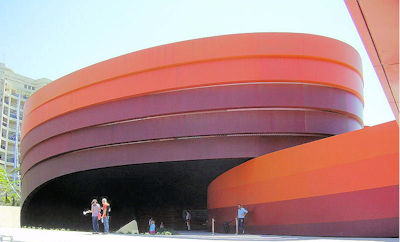 CAARI and I visited the Holon Design Museum twice over a seven-year span of time.
This was the first design museum in Israel and the modernistic design of the building was unique,
attention-getting and well worth a visit in and of itself. The displays in the museum continually
changed, but the ones I saw tended to be very artsy. The museum itself was housed in a
sweeping edifice created by Ron Arad. The building was made up of red, brown, and
orange bands of weathering steel (Cor-Ten). Inside were two staggered levels of galleries
with changing exhibits.
CAARI and I visited the Holon Design Museum twice over a seven-year span of time.
This was the first design museum in Israel and the modernistic design of the building was unique,
attention-getting and well worth a visit in and of itself. The displays in the museum continually
changed, but the ones I saw tended to be very artsy. The museum itself was housed in a
sweeping edifice created by Ron Arad. The building was made up of red, brown, and
orange bands of weathering steel (Cor-Ten). Inside were two staggered levels of galleries
with changing exhibits. Israeli Children's Museum: 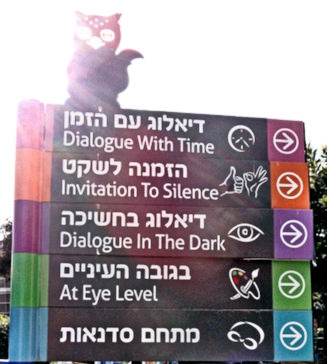 The Israeli Children's Museum was located in Holon, just south of
Tel Aviv–Jaffa. It was an educational and cultural institution providing
experiences far different than any other Israeli museum. Children were encouraged to touch
the displays, feel the materials and even be part of the exhibits. The Museum Trails were
experiential journeys, taking children on an imaginary adventures with added educational value.
There were five different trails available, geared to different age groups, for kids aged 2½
to 11. Each of the trails was a story, in which the child was an active character.
The Israeli Children's Museum was located in Holon, just south of
Tel Aviv–Jaffa. It was an educational and cultural institution providing
experiences far different than any other Israeli museum. Children were encouraged to touch
the displays, feel the materials and even be part of the exhibits. The Museum Trails were
experiential journeys, taking children on an imaginary adventures with added educational value.
There were five different trails available, geared to different age groups, for kids aged 2½
to 11. Each of the trails was a story, in which the child was an active character. Dialogue in the Dark provided visitors with an insight into the world of the blind. The guides were themselves either visually impaired or completely blind. I, along with the rest of our CAARI group, went through the pitch-black trail, equipped only with a cane to experience the world in complete darkness. Invitation to Silence was an unusual communication journey guided by the deaf. At Eye Level – “Begova Haeynaim”, very young children, 3 – 7, got acquainted with theater, music and art. IDC Herzliya: 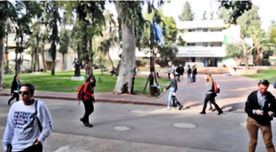 The Interdisciplinary Center, abbreviated IDC, was located in Herzliya,
a short 6-mile drive north of Tel Aviv. It was a private, not-for-profit, and
nonsectarian, research college, founded in 1994. In 2014 IDC was ranked the most
successful academic start-up institution outside of the United States, ranking 1st
in Israel and 21st in the world. In 2016, IDC had 7,000 students, with 75% being
on a Hebrew track (courses are taught in Hebrew) and the other 25% on an
English track (courses are taught in English). Preferential treatment was given to
Israeli soldiers and former Israeli soldiers. In its 2016 visit to IDC, CAARI was
treated to talks by 3 Ethiopian-Israeli women who were students at IDC. The parents
of all 3 women immigrated to Israel from Ethiopia, some walking for hundreds or thousands
of miles to reach safety. They all came from large families. In general, their parents
were poor and uneducated and unused to modern life. All expressed their gratitude to Israel,
their objective of repaying Israel for its hospitality and their desire to eliminate
barriers to women and blacks. In all 3 cases, serving in the IDF was a very important
part of their maturation and learning. Our CAARI group was impressed and touched.
The Interdisciplinary Center, abbreviated IDC, was located in Herzliya,
a short 6-mile drive north of Tel Aviv. It was a private, not-for-profit, and
nonsectarian, research college, founded in 1994. In 2014 IDC was ranked the most
successful academic start-up institution outside of the United States, ranking 1st
in Israel and 21st in the world. In 2016, IDC had 7,000 students, with 75% being
on a Hebrew track (courses are taught in Hebrew) and the other 25% on an
English track (courses are taught in English). Preferential treatment was given to
Israeli soldiers and former Israeli soldiers. In its 2016 visit to IDC, CAARI was
treated to talks by 3 Ethiopian-Israeli women who were students at IDC. The parents
of all 3 women immigrated to Israel from Ethiopia, some walking for hundreds or thousands
of miles to reach safety. They all came from large families. In general, their parents
were poor and uneducated and unused to modern life. All expressed their gratitude to Israel,
their objective of repaying Israel for its hospitality and their desire to eliminate
barriers to women and blacks. In all 3 cases, serving in the IDF was a very important
part of their maturation and learning. Our CAARI group was impressed and touched. Baha’i Gardens: 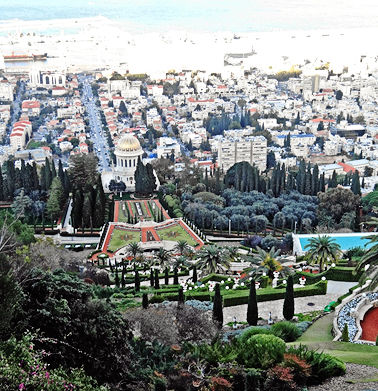 In Haifa, CAARI visited the world famous Baha’i Gardens, which were located
on Carmel Hill and which ran from Yeffe Nof Street down to the start of
Ben Gurion Avenue. At Yeffe Nof, we had a magnificent view of the Gardens,
the Shrine of the Bab, Haifa, Haifa Harbor, and just about all of northern Israel,
along with a bit of southern Lebanon.
In Haifa, CAARI visited the world famous Baha’i Gardens, which were located
on Carmel Hill and which ran from Yeffe Nof Street down to the start of
Ben Gurion Avenue. At Yeffe Nof, we had a magnificent view of the Gardens,
the Shrine of the Bab, Haifa, Haifa Harbor, and just about all of northern Israel,
along with a bit of southern Lebanon. Built in 1953, the gold-domed Shrine of the Bab in the gardens was one of the most visited landmarks in Israel. The Shrine contained the tomb of Siyyad Ali Muhammed – the Bab – a Muslim from Persia who proclaimed the coming of a “Promised One” in 1844. In 1850, he was executed in Iran for heresy. In 1909, the Bab’s disciples brought his remains to Haifa. Hecht Archaeological Museum:  CAARI visited the outstanding Hecht Archaeological Museum at Haifa University
on Mt. Carmel more than once. On one visit to the museum, Kurt Raveh showed
us the Ma’agan Michael, a 2,400 year-old ship, that was recovered off the
shores of Israel several years ago and he explained how it was built, used and recovered.
CAARI visited the outstanding Hecht Archaeological Museum at Haifa University
on Mt. Carmel more than once. On one visit to the museum, Kurt Raveh showed
us the Ma’agan Michael, a 2,400 year-old ship, that was recovered off the
shores of Israel several years ago and he explained how it was built, used and recovered. Ghetto Fighters’ House Museum: 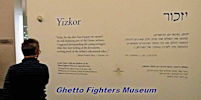 The Beit Lohamai Haghetaot Ghetto Fighters’ House Museum was north of
Haifa, on a kibbutz between the coastal cities of Akko and
Nahariya. The Ghetto Fighters’ House Museum was established in 1949 by
Holocaust survivors, fighters from the Warsaw Ghetto and partisans, who
settled in the Western Galilee. It was the first museum in the world to
commemorate the Holocaust and the heritage of Jewish resistance. At the museum there
was a children’s wing, Yad LaYeled (Memorial to the child), which presented
the Holocaust in a form suitable for children. At the museum site there was an
ancient aqueduct and an outdoor amphitheater. CAARI viewed a short film and toured
the exhibits, which included audio, film, and written testimonies by Holocaust survivors,
photos, art and other items from the Holocaust era.
The Beit Lohamai Haghetaot Ghetto Fighters’ House Museum was north of
Haifa, on a kibbutz between the coastal cities of Akko and
Nahariya. The Ghetto Fighters’ House Museum was established in 1949 by
Holocaust survivors, fighters from the Warsaw Ghetto and partisans, who
settled in the Western Galilee. It was the first museum in the world to
commemorate the Holocaust and the heritage of Jewish resistance. At the museum there
was a children’s wing, Yad LaYeled (Memorial to the child), which presented
the Holocaust in a form suitable for children. At the museum site there was an
ancient aqueduct and an outdoor amphitheater. CAARI viewed a short film and toured
the exhibits, which included audio, film, and written testimonies by Holocaust survivors,
photos, art and other items from the Holocaust era. Ayalon Institute: 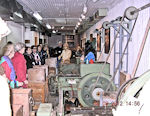 The Ayalon Institute, or as it was also known, the Clandestine Bullet Factory,
was located on the northern outskirts of Rehovot, near the Weizmann Institute.
In 1945, the Haganah concluded that at the end of the British Mandate
a struggle would ensue between the Jews and Arabs of the land. A decision was made to
establish a secret plant to manufacture bullets. In just 3 weeks, the factory was
completed and it was code-named the Maganda Ayalon Institute. It was on Kibbutzim Hill,
which got its name from the groups of pioneers that trained there on how to live and
work on a kibbutz.
The Ayalon Institute, or as it was also known, the Clandestine Bullet Factory,
was located on the northern outskirts of Rehovot, near the Weizmann Institute.
In 1945, the Haganah concluded that at the end of the British Mandate
a struggle would ensue between the Jews and Arabs of the land. A decision was made to
establish a secret plant to manufacture bullets. In just 3 weeks, the factory was
completed and it was code-named the Maganda Ayalon Institute. It was on Kibbutzim Hill,
which got its name from the groups of pioneers that trained there on how to live and
work on a kibbutz. Above ground, the Factory appeared to be no more than a bakery and a laundry, but 24 feet below ground there was the largest bullet factory in the country at that time. From 1946 to 1948, some 45 people worked at manufacturing 2.25 million 9-mm bullets for the Sten sub-machine gun. The bullet making machinery was made in Germany, purchased in Poland in 1938, shipped to Beirut, Lebanon, and from there smuggled into Israel in 1942. The equipment was hidden until 1945, when the 12 bullet-making machines were installed. CAARI toured the site more than once, watching a short film about the Bullet Factory, passing through the laundry building, walking over the area which covered the Factory, through the bakery building and then down a narrow iron spiral stairway in the bakery to see the underground bullet manufacturing area. Chaim Weizmann Institute: 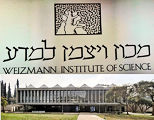 The Chaim Weizmann Institute was in Rehovot, about 20 miles southeast of
Tel Aviv. The Weizmann Institute was a world-class basic research institution
that offered only graduate degrees - master’s, doctoral and post-doctoral.
At the visitors’ center, CAARI went through two very high-tech interactive display rooms
where the purpose and activities of the institute were explained. From the visitors’
center we proceeded to a science park, located on the Weizmann Institute campus. The
park was interactive and allowed people, young and old, to learn about science in a
hands-on and enjoyable manner. This was an extremely well thought-out science park
and any child would love to spend a few hours there – think of it as an outdoor
Boston Museum of Science.
The Chaim Weizmann Institute was in Rehovot, about 20 miles southeast of
Tel Aviv. The Weizmann Institute was a world-class basic research institution
that offered only graduate degrees - master’s, doctoral and post-doctoral.
At the visitors’ center, CAARI went through two very high-tech interactive display rooms
where the purpose and activities of the institute were explained. From the visitors’
center we proceeded to a science park, located on the Weizmann Institute campus. The
park was interactive and allowed people, young and old, to learn about science in a
hands-on and enjoyable manner. This was an extremely well thought-out science park
and any child would love to spend a few hours there – think of it as an outdoor
Boston Museum of Science. Weizmann House: 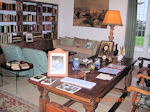 The Weizmann House was located on the grounds of the Weizmann Institute of Sciences
in Rehovot, some 12 to 15 miles southeast of Tel Aviv. CAARI toured the
Weismann House and a bit of the grounds. The Weizmann House was a beautiful and grand building,
which was designed by the Jewish architect Erich Mendelsohn, and was recognized
as a masterpiece. Chaim Weizmann took residence there in 1937 and the house
functioned as the official residence of the President of Israel from 1949 to 1952.
The house was adapted into a museum in 1978.
The Weizmann House was located on the grounds of the Weizmann Institute of Sciences
in Rehovot, some 12 to 15 miles southeast of Tel Aviv. CAARI toured the
Weismann House and a bit of the grounds. The Weizmann House was a beautiful and grand building,
which was designed by the Jewish architect Erich Mendelsohn, and was recognized
as a masterpiece. Chaim Weizmann took residence there in 1937 and the house
functioned as the official residence of the President of Israel from 1949 to 1952.
The house was adapted into a museum in 1978. The gardens on the grounds of the home were the resting place for Chaim and Vera Weizmann. A limited-edition Lincoln limousine was presented to Israeli President Weizmann by the Ford Motor Company. Only 18 of this model were produced, one of them being given to then president Harry Truman. The limousine was restored and was on display on the Weizmann House grounds. Babylonian Jewry Heritage Center: 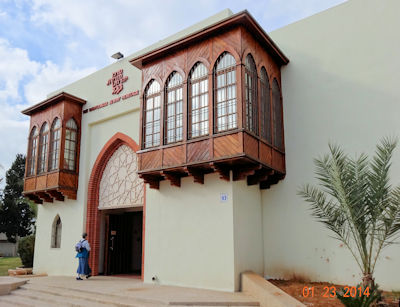 In 2014, CAARI explored the Babylonian Jewry Heritage Center (BJHC) in Or Yehuda,
about 6 miles southeast of Tel Aviv. The museum was both a research institute
and a museum. It had strong ties with Jews of Iraqi origin, both in Israel and in the
Diaspora, and was in the process of compiling an extensive genealogical database of
families originating in Iraq. The Jewish presence in Babylonia dated back more
than 2,500 years to the expulsion of the Jews from the ancient kingdoms of Judah and
Israel and the destruction of the 1st Temple in 586 BC. From that date on, Jews
were present in Babylonia (now Iraq) until late in the 20th century. The Israeli
government airlifted over 120,000 Iraqi Jews during Operations Ezra and
Nechemia, from 1950-1952. By 2014, Iraq was “Juden-frei”.
In 2014, CAARI explored the Babylonian Jewry Heritage Center (BJHC) in Or Yehuda,
about 6 miles southeast of Tel Aviv. The museum was both a research institute
and a museum. It had strong ties with Jews of Iraqi origin, both in Israel and in the
Diaspora, and was in the process of compiling an extensive genealogical database of
families originating in Iraq. The Jewish presence in Babylonia dated back more
than 2,500 years to the expulsion of the Jews from the ancient kingdoms of Judah and
Israel and the destruction of the 1st Temple in 586 BC. From that date on, Jews
were present in Babylonia (now Iraq) until late in the 20th century. The Israeli
government airlifted over 120,000 Iraqi Jews during Operations Ezra and
Nechemia, from 1950-1952. By 2014, Iraq was “Juden-frei”. The museum exhibited many items brought from Iraq to Israel, including several very beautiful Torah scrolls. The BJHC wasn’t a large mainstream Israeli museum. But, if you have the time, it is a joy to visit and it keeps alive the story of another Jewish community that no longer exists because it became another victim of virulent anti-Semitism. A Better Place:  In 2011, CAARI took me to what was then a very exciting Israeli hi-tech start-up company,
the Better Place electric car company in Ramat Ha’Sharon. There, I was told about
the unique features of the company’s business and engineering concepts and allowed to
drive one of its electric cars around a test track. The story of the company’s formation
was given in the best-selling book “Start Up Nation”. The major feature of the
A Better Place concept was to swap out depleted car batteries at service stations in
5 minutes or less, rather than the hours of battery recharging required by the
conventional method. Unfortunately, the company failed in 2013 because of poor
leadership.
In 2011, CAARI took me to what was then a very exciting Israeli hi-tech start-up company,
the Better Place electric car company in Ramat Ha’Sharon. There, I was told about
the unique features of the company’s business and engineering concepts and allowed to
drive one of its electric cars around a test track. The story of the company’s formation
was given in the best-selling book “Start Up Nation”. The major feature of the
A Better Place concept was to swap out depleted car batteries at service stations in
5 minutes or less, rather than the hours of battery recharging required by the
conventional method. Unfortunately, the company failed in 2013 because of poor
leadership. Ramat Hanadiv: 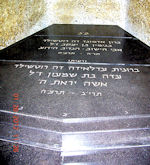 Ramat HaNadiv means Heights of the Benefactor in
Hebrew. It was a nature park and gardens at the southern end of Mount Carmel.
In addition to housing the tombs of Baron Edmond de Rothschild and his wife,
it had meticulously cultivated memorial gardens, a nature park and a visitors’
center. It was adjacent to a 2000-year-old archaeological site
called Mansur el Akeb. Beside visiting the tomb of the Unknown
Benefactor, strolling through the memorial gardens with views of Mediterranean
Sea off in the distance was a most pleasant experience.
Ramat HaNadiv means Heights of the Benefactor in
Hebrew. It was a nature park and gardens at the southern end of Mount Carmel.
In addition to housing the tombs of Baron Edmond de Rothschild and his wife,
it had meticulously cultivated memorial gardens, a nature park and a visitors’
center. It was adjacent to a 2000-year-old archaeological site
called Mansur el Akeb. Beside visiting the tomb of the Unknown
Benefactor, strolling through the memorial gardens with views of Mediterranean
Sea off in the distance was a most pleasant experience. Mansour el Akeb:  Mansour el Akeb was a partially reconstructed ruin of what was originally a vaulted
two-story structure. There were remains from the Second Temple (Roman) period, when
Mansur el Akeb formed part of the agricultural region of then prosperous Caesarea,
with olive oil and wine presses and a threshing floor that dated from the Byzantine
period (4th-7th century CE) and from the Middle Ages.
Mansour el Akeb was a partially reconstructed ruin of what was originally a vaulted
two-story structure. There were remains from the Second Temple (Roman) period, when
Mansur el Akeb formed part of the agricultural region of then prosperous Caesarea,
with olive oil and wine presses and a threshing floor that dated from the Byzantine
period (4th-7th century CE) and from the Middle Ages. CAARI hiked a trail to Mansur-El-Akeb that was part of the Israel Trail ("Shvil Yisrael"). The Israel National Trail was a hiking path that spans the entire length of Israel. Mansour el Akeb contained remnants of a Byzantine farmhouse built over ruins from the Second Temple period. It was within the Ramat HaNadiv Nature Reserve. The views from there, at the edge of the Carmel Mountains' southern slope were really breathtaking and a welcome reward for the short hike. Caesarea: 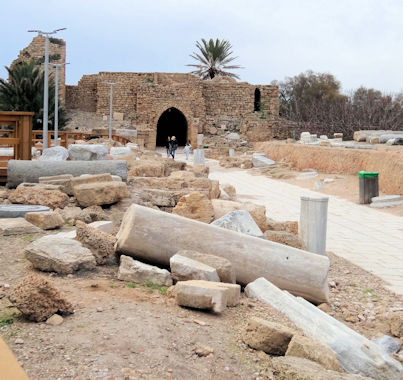 Caesarea was built by Herod the Great about 25–13 BCE as the port city
Caesarea Maritima. He created a man-made, deep-sea harbor there (a magnificent
engineering feat), constructed an aqueduct to bring water to the port city, and built
storerooms, markets, wide roads, baths, temples to Rome and Augustus, and imposing
public buildings. The ruins there were in excellent shape and the national park of
Caesarea Maritima was visited by CARRI on more than one occasion. CAARI’s visits to
Caesarea usually concluded with dinner at the Aresto Café where we would
enjoy a view of the sun setting over the Mediterranean Sea behind the
remnants of the Roman seaport while we were eating an excellent Israeli dinner.
Caesarea was built by Herod the Great about 25–13 BCE as the port city
Caesarea Maritima. He created a man-made, deep-sea harbor there (a magnificent
engineering feat), constructed an aqueduct to bring water to the port city, and built
storerooms, markets, wide roads, baths, temples to Rome and Augustus, and imposing
public buildings. The ruins there were in excellent shape and the national park of
Caesarea Maritima was visited by CARRI on more than one occasion. CAARI’s visits to
Caesarea usually concluded with dinner at the Aresto Café where we would
enjoy a view of the sun setting over the Mediterranean Sea behind the
remnants of the Roman seaport while we were eating an excellent Israeli dinner. Rishon Le Zion: 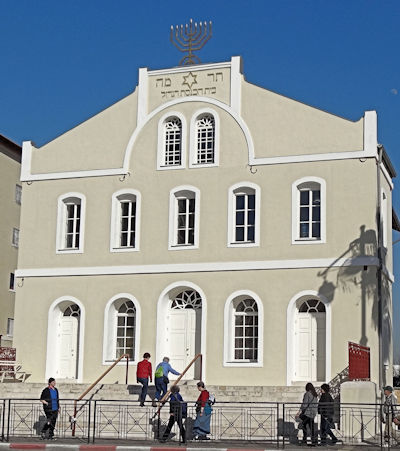 I visited Rishon Le Zion with CAARI a few times. Founded in 1882, it was the 4th
largest city in Israel in 2011. The city boasted a number of firsts and was aided
in its early survival and growth by Baron Edmond de Rothschild.
We toured the town’s museum, visited it’s old well, it’s first synagogue and the
world’s first school in which modern Hebrew was taught. Eliezer Ben-Yehuda,
known as the father of modern Hebrew, was a teacher in Rishon Le Zion. Israel’s
national anthem, Hatikvah, was first performed in Rishon Le Zion and
Israel’s flag was first flown there.
I visited Rishon Le Zion with CAARI a few times. Founded in 1882, it was the 4th
largest city in Israel in 2011. The city boasted a number of firsts and was aided
in its early survival and growth by Baron Edmond de Rothschild.
We toured the town’s museum, visited it’s old well, it’s first synagogue and the
world’s first school in which modern Hebrew was taught. Eliezer Ben-Yehuda,
known as the father of modern Hebrew, was a teacher in Rishon Le Zion. Israel’s
national anthem, Hatikvah, was first performed in Rishon Le Zion and
Israel’s flag was first flown there. Zichron Ya’akov: 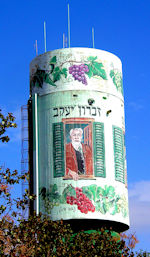 At Zichron Ya’akov, CAARI visited the Ohel Ya'akov (Tent of Jacob) Synagogue
(named after Baron Edmond de Rothschild's father), the Carmel Winery,
the NILI Museum, and the famous "Midrachov"— Founders Street, with
its picturesque setting and historic city center. On the Midrachov, there were restored
landmark houses, coffeehouses and boutique shops
selling locally-made crafts, jewelry, and antiques. The Midrachov was normally closed
to vehicles, so strolling it was safe and pleasant.
At Zichron Ya’akov, CAARI visited the Ohel Ya'akov (Tent of Jacob) Synagogue
(named after Baron Edmond de Rothschild's father), the Carmel Winery,
the NILI Museum, and the famous "Midrachov"— Founders Street, with
its picturesque setting and historic city center. On the Midrachov, there were restored
landmark houses, coffeehouses and boutique shops
selling locally-made crafts, jewelry, and antiques. The Midrachov was normally closed
to vehicles, so strolling it was safe and pleasant. NILI Museum: 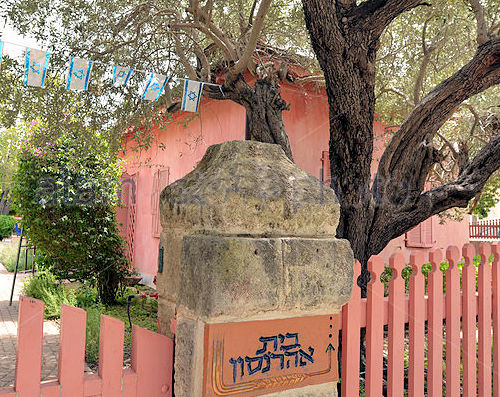 The NILI Museum was in the Aaronsohn Family Housing Compound in
Zichron Ya’akov. The NILI spy ring of
World War I was established in Zichron Ya’akov by members of the
Aaronsohn family and others to aid the British in their fight against the Ottoman
Turks who were allied with Germany. Sarah Aaronsohn, a member
of NILI was caught and tortured by the Turks. She was able to kill herself with a
pistol that had been hidden behind a secret panel in a door frame in the
Aaronsohn house bathroom. The Aaronsohn House–NILI Museum recreated the history of
this period.
The NILI Museum was in the Aaronsohn Family Housing Compound in
Zichron Ya’akov. The NILI spy ring of
World War I was established in Zichron Ya’akov by members of the
Aaronsohn family and others to aid the British in their fight against the Ottoman
Turks who were allied with Germany. Sarah Aaronsohn, a member
of NILI was caught and tortured by the Turks. She was able to kill herself with a
pistol that had been hidden behind a secret panel in a door frame in the
Aaronsohn house bathroom. The Aaronsohn House–NILI Museum recreated the history of
this period. Nahariya: 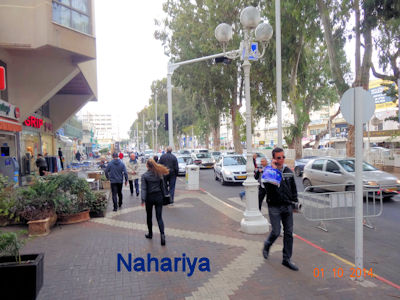 In 2014, I visited Nahariya with CAARI. The town lay less than 10 miles north of Acre
and was a resort town. Nahariya was Israel’s northernmost coastal city and a pioneer among the newer
settlements of the Western Galilee. Nahariya’s main thoroughfare, Sderot
HaGa’aton, crossed the city from east to west. Flowing through the center of the boulevard
was the Ga’aton River and during the rainy winter it was supposed to be a pleasure to
observe its waters rushing towards the sea. While we were in Nahariya, the river was only a
trickle. Along the length of this lively street were dozens of coffee houses, restaurants and
shops. We were in Nahariya in Winter, not the summer tourist season when the town bustles.
In 2014, I visited Nahariya with CAARI. The town lay less than 10 miles north of Acre
and was a resort town. Nahariya was Israel’s northernmost coastal city and a pioneer among the newer
settlements of the Western Galilee. Nahariya’s main thoroughfare, Sderot
HaGa’aton, crossed the city from east to west. Flowing through the center of the boulevard
was the Ga’aton River and during the rainy winter it was supposed to be a pleasure to
observe its waters rushing towards the sea. While we were in Nahariya, the river was only a
trickle. Along the length of this lively street were dozens of coffee houses, restaurants and
shops. We were in Nahariya in Winter, not the summer tourist season when the town bustles. Rosh HaNikra: 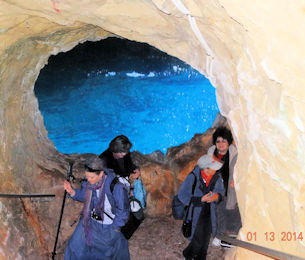 Rosh HaNikra was a geologic formation, located on the coast of the Mediterranean Sea
about 6 miles north of Nahariya on the border with Lebanon. It was a white chalk
cliff face which opened up into spectacular grottos.
Rosh HaNikra was a geologic formation, located on the coast of the Mediterranean Sea
about 6 miles north of Nahariya on the border with Lebanon. It was a white chalk
cliff face which opened up into spectacular grottos. Since Rosh Hanikra was right on the Israel-Lebanon border, there was a military presence there – soldiers and towers to monitor activity across the border and to warn of rocket attacks. Offshore were Israel patrol boats. The Rosh HaNikra grottos were cavernous tunnels formed by sea action on the soft chalk rock. In the past, the only access to them was from the sea and experienced divers were the only ones capable of visiting them. On CAARI’s visit, a cable car took us down to the grottos. The grottos were truly magnificent and should not be missed if one has the time in Israel. Acre (Akko): 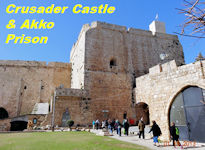 Akko or Acre was located at the northern extremity of Haifa Bay. The city was one of
the oldest continuously inhabited sites in the world. In crusader times it was the
headquarters of the Knights Hospitaller. Acre was the holiest city of the
Baha’i Faith. In 2014, its population was around 50,000, 72% Jewish and 28% Arab.
Akko or Acre was located at the northern extremity of Haifa Bay. The city was one of
the oldest continuously inhabited sites in the world. In crusader times it was the
headquarters of the Knights Hospitaller. Acre was the holiest city of the
Baha’i Faith. In 2014, its population was around 50,000, 72% Jewish and 28% Arab. In the 3rd and final Crusade, Akko was captured by Richard the Lion-Hearted of England and Philip II of France. Akko was the final stronghold of the Crusader states. The city surrendered to the Mamluks in a bloody siege in 1291 and was entirely destroyed, with the exception of a few religious edifices considered sacred by the Muslims. Beginning in 1922, the British Mandate government reconstructed Akko and its economic situation improved. Later, Akko's old fort was converted into a jail, where members of the Jewish underground were held and executed. Members of the Jewish underground organization, the Irgun, broke into the jail on 4 May 1947 and succeeded in releasing Jewish underground movement activists, as well as 200 Arab inmates. Captured by Israel on 17 May 1948, many Jewish neighborhoods were established at the northern and eastern parts of the city, and it became a development town, absorbing Jewish immigrants, largely Jews from Morocco. The old city of Akko remained largely Arab Muslim (including several Bedouin families), with Arab Christian neighborhoods in close proximity. The city, where the Baha’i Mansion of Bahjí was located, also attracted Baha’i worshippers. My visits to Akko with CAARI were mostly in the old fort area. We had tours of the old prison and would later meander through the Arab market (shuk) enjoying the exotic sights, sounds, smells, food and drink. Avtalyon: 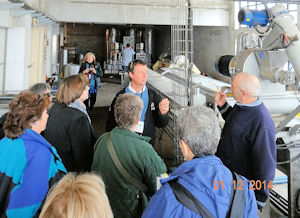 Avtalyon was about 35 miles due east of Haifa. The Avtalyon Olive Press
was the only olive oil company in the Galilee that was owned by a Jew –
Israeli-Arabs owned the rest. It was a boutique olive press enterprise that had been
making extra virgin olive oil from the local olives in the Galilee for 17 years previous to
CAARI's visit. The Olive Press was in a magnificent location with a fantastic view of
the surrounding hills, valleys, towns and olive tree orchards.
Avtalyon was about 35 miles due east of Haifa. The Avtalyon Olive Press
was the only olive oil company in the Galilee that was owned by a Jew –
Israeli-Arabs owned the rest. It was a boutique olive press enterprise that had been
making extra virgin olive oil from the local olives in the Galilee for 17 years previous to
CAARI's visit. The Olive Press was in a magnificent location with a fantastic view of
the surrounding hills, valleys, towns and olive tree orchards. The owner of the Avtalyon Olive Press described the olive oil business, the olive products, and many more interesting facts about olives - olive oil in particular. He told us that 90% of Israeli olive oil was produced in the southern Galilee; that 90% of the olive oil produced in the southern Galilee was produced by Arabs; and that 90% of the olive trees in the southern Galilee were owned by Arabs. Avtalyon was the main marketing center for olive oil in Israel. By the time we were done, we’d pretty much learned everything that one might want to know about olives. We also got a chance to sample some of the olive products there. Teva Ez Goat Farm:  In Moshav Ben Ami, a capitalistic style kibbutz (cooperative), which was
a few miles east of Nahariya, CAARI visited the Teva Ez Dairy,
a goat farm that produced a large variety of all-natural goat cheeses. We visited
the goat shed, fed the goats, milked some goats and ended up making cheese
from goat milk – ingredients: boiled milk, lemon juice, vinegar, and chopped chives.
We then got to sample the cheese – not at all bad.
In Moshav Ben Ami, a capitalistic style kibbutz (cooperative), which was
a few miles east of Nahariya, CAARI visited the Teva Ez Dairy,
a goat farm that produced a large variety of all-natural goat cheeses. We visited
the goat shed, fed the goats, milked some goats and ended up making cheese
from goat milk – ingredients: boiled milk, lemon juice, vinegar, and chopped chives.
We then got to sample the cheese – not at all bad. Buza Ice Cream Shop: 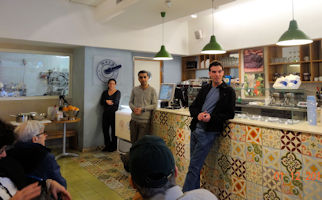 About 10 miles east of Nahariya, in Ma’alot-Tarshina, CAARI stopped
at the Buza Ice Cream Shop. In Arabic, Buza means ice cream. Buza was owned and operated
by Adam, a Jew from the nearby Kibbutz Tarshech, and Alaa,
an Arab Muslim who owned a restaurant a short distance away. Their ice cream shop produced
all-natural ice creams from local fruits, milk, and cream, along with other imported
high-quality ingredients that were not domestically produced. Adam obtained financing
for the shop from his kibbutz. At Buza, we made two batches of ice cream, chocolate and
red grapefruit. We then sampled the results, and had coffee, cappuccino and tea. We were
told that business relations between Jews and Arabs similar to this one were not uncommon
in this area of Israel.
About 10 miles east of Nahariya, in Ma’alot-Tarshina, CAARI stopped
at the Buza Ice Cream Shop. In Arabic, Buza means ice cream. Buza was owned and operated
by Adam, a Jew from the nearby Kibbutz Tarshech, and Alaa,
an Arab Muslim who owned a restaurant a short distance away. Their ice cream shop produced
all-natural ice creams from local fruits, milk, and cream, along with other imported
high-quality ingredients that were not domestically produced. Adam obtained financing
for the shop from his kibbutz. At Buza, we made two batches of ice cream, chocolate and
red grapefruit. We then sampled the results, and had coffee, cappuccino and tea. We were
told that business relations between Jews and Arabs similar to this one were not uncommon
in this area of Israel. Elite Chocolate Factory: 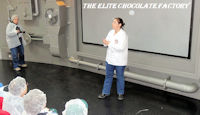 In 2013, CAARI toured the Elite Chocolate Factory near Nazareth. There, we received
a guided tour, had the history of Elite (owned by the Strauss family since 2004) explained
to us, and viewed a video that described how the Elite products were produced. This
factory was the largest chocolate factory in the Middle-East and was highly automated.
As we departed, we all received gift packages of Elite products.
In 2013, CAARI toured the Elite Chocolate Factory near Nazareth. There, we received
a guided tour, had the history of Elite (owned by the Strauss family since 2004) explained
to us, and viewed a video that described how the Elite products were produced. This
factory was the largest chocolate factory in the Middle-East and was highly automated.
As we departed, we all received gift packages of Elite products. De Karina Chocolate Factory: 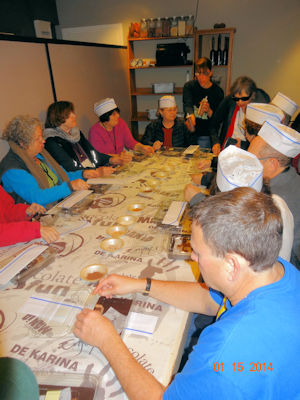 In 2014, CAARI traveled to Kibbutz Ein Zivan and the De Karina chocolate factory in
the eastern Galilee. The De Karina Chocolate Factory was established by
Karina Chaplinski, whose family members were chocolatiers for three generations.
Karina and her immediate family moved to Israel from Argentina in 2003.
In 2014, CAARI traveled to Kibbutz Ein Zivan and the De Karina chocolate factory in
the eastern Galilee. The De Karina Chocolate Factory was established by
Karina Chaplinski, whose family members were chocolatiers for three generations.
Karina and her immediate family moved to Israel from Argentina in 2003. At the chocolate factory, we received a short explanation about the world of chocolate and were given individual chocolate creation kits. Everyone created their own chocolate delicacies with melted colorful chocolate and with a variety of materials to decorate our masterpieces. After a short cooling of the chocolate, our creations were returned to eat or take with us. Beit Shemesh: 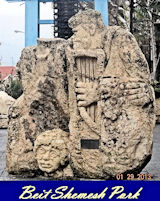 During my visits to Israel with CAARI, we visited the modern city of Beit Shemesh 2 or 3 times.
The city was started by Jewish immigrants from Rumania, Afghanistan and Iraq in 1950. Later,
Jews fleeing Moslem persecution in North Africa were settled there.
During my visits to Israel with CAARI, we visited the modern city of Beit Shemesh 2 or 3 times.
The city was started by Jewish immigrants from Rumania, Afghanistan and Iraq in 1950. Later,
Jews fleeing Moslem persecution in North Africa were settled there. In 2014, Beit Shemesh was an exploding city of over 100,000 people that included 5,000 Ethiopians, 35,000 ultra-orthodox (Haredi), and 5,000 Russians. The ultra-orthodox had created major problems because of their extremism, forcing some to move out. In 2014, the Supreme Court of Israel had found “a comprehensive, organized system” of fraud in the Beit Shemesh municipal elections perpetrated by the Haredim. Our drive around Beit Shemesh disclosed an enormous amount of new housing construction, with tens of thousands of new housing units being built. We stopped at the public Jabotinsky School to meet and hear from a former deputy mayor and the non-Haredi mayoral candidate. On another visit, we visited a public sculpture garden in memory of fallen members of the Israeli armored corps. The sculptures appeared to be ancient, but, in fact were made by a contemporary sculptor. Most were of biblical events, but some had a modern context, as evidenced by “sculptures” utilizing tank treads. Be’er Sheva River Park 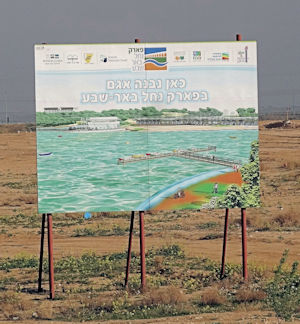 I visited this location several times with CAARI, following the park’s transition over the
years from a dump to a fantastic outdoor recreation area that had been wrested from the
northern Negev Desert.
I visited this location several times with CAARI, following the park’s transition over the
years from a dump to a fantastic outdoor recreation area that had been wrested from the
northern Negev Desert. Be’er Sheva was known as the Capital of the Negev or as the Gateway to the Negev. In 2014, it had more than 250,000 residents and was growing rapidly. Through it ran Nahal Be’er Sheva (Be’er Sheva River), a muddy trickle of water except on the few days a year when flash floods ran down its banks. Be’er Sheva River Park was a massive water, environment and economic development project that was transforming the riverfront into a 1,700-acre civic paradise. JNF succeeded in cleaning up the river that had been used as a dumping ground for decades. Five miles of landscaped promenade were being built on each shore. Engineers responsible for the San Antonio River Walk partnered with JNF to send water through the river bed year-round. Recycled city water was used for a 23-acre boating lake. The 750-acre Park, twice the size of New York’s Central Park, included gardens showcasing desert flora and fauna, 40,000 new trees, bicycle/walking/jogging paths, a sports center, a large lake, recreation areas, and a 12,000-seat amphitheater. Most water for the project came from recycled waste water carried down to Be’er Sheva from the Gush Dan Region near Tel Aviv. Abraham’s Well Museum: 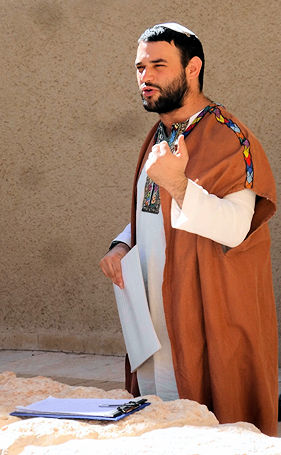 In Be’er Sheva, CAARI visited the Abraham’s Well Museum. The Abraham’s Well
Museum was located next to a bridge that spanned the Be'er Sheva River.
The museum was dedicated
to the story of Abraham and his relationship to Be’er Sheva. We were guided through the
displays to view a 3-D movie that told the story of Abraham and the well at Be’er Sheva
that the Bible tells us he dug there. Our guide was dressed as Abraham might have been
and his narrative was quite spirited. The movie was entertaining and, at its conclusion,
the movie screen lifted to expose a huge window with a view into an open area where
there was indeed a large well. Abraham’s Well???
In Be’er Sheva, CAARI visited the Abraham’s Well Museum. The Abraham’s Well
Museum was located next to a bridge that spanned the Be'er Sheva River.
The museum was dedicated
to the story of Abraham and his relationship to Be’er Sheva. We were guided through the
displays to view a 3-D movie that told the story of Abraham and the well at Be’er Sheva
that the Bible tells us he dug there. Our guide was dressed as Abraham might have been
and his narrative was quite spirited. The movie was entertaining and, at its conclusion,
the movie screen lifted to expose a huge window with a view into an open area where
there was indeed a large well. Abraham’s Well??? Israeli Air Force Museum: 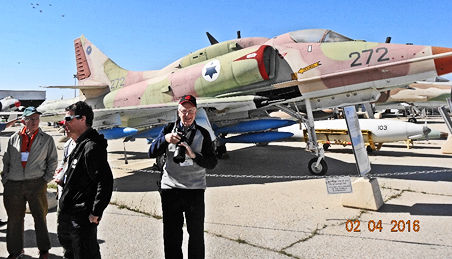 The Israeli Air Force Museum was in the open expanse of the northern Negev Desert at
the IAF’s Hatzerim Air Force Base, just outside of Be’er Sheva.
At the Israeli Air Force Museum, an IAF guide took CAARI through the exhibits, explaining
how the IAF developed in its early days, what it had become, and describing the various
aircraft on display. The museum was dedicated to preserving the history of the IAF
and showcased over 150 airplanes and much, much more. The large collection of airplanes
and helicopters were ones which had been used by the IAF. Prominently on display was the
Boeing 707 aircraft that was used as the mobile command center for the
Entebbe hostage rescue operation.
The Israeli Air Force Museum was in the open expanse of the northern Negev Desert at
the IAF’s Hatzerim Air Force Base, just outside of Be’er Sheva.
At the Israeli Air Force Museum, an IAF guide took CAARI through the exhibits, explaining
how the IAF developed in its early days, what it had become, and describing the various
aircraft on display. The museum was dedicated to preserving the history of the IAF
and showcased over 150 airplanes and much, much more. The large collection of airplanes
and helicopters were ones which had been used by the IAF. Prominently on display was the
Boeing 707 aircraft that was used as the mobile command center for the
Entebbe hostage rescue operation. Givot Bar: 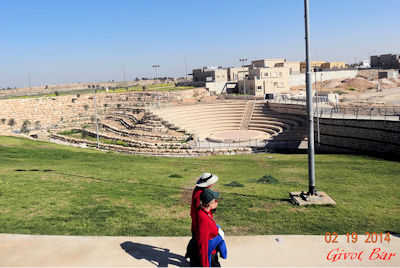 When CAARI visited Givot Bar, it was a new and growing gated Negev community
established by the OR Movement. The OR Movement was founded in 1999 by a
group of youths from Petach Tikva who, after completing their military service,
established Sansana, the first new community in the Negev since the early 1980’s.
OR’s mission was to encourage young Israelis and new immigrants to populate and
cultivate the Negev and Galilee regions of Israel.
When CAARI visited Givot Bar, it was a new and growing gated Negev community
established by the OR Movement. The OR Movement was founded in 1999 by a
group of youths from Petach Tikva who, after completing their military service,
established Sansana, the first new community in the Negev since the early 1980’s.
OR’s mission was to encourage young Israelis and new immigrants to populate and
cultivate the Negev and Galilee regions of Israel. Giv’ot Bar was adjacent to the larger Bedouin town of Rahat. Relations with the Bedouins and the town were reported as friendly and cooperative. Debby Rolnick from the OR Movement led us through Giv’ot Bar and explained the history of the OR Movement and the OR communities. On one visit, we were accompanied by the community’s young mayor and the head of security. Carmit: 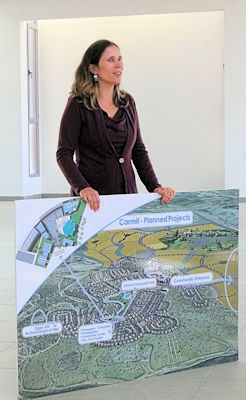 Carmit, a planned upscale community in an area near the JNF Lahav Forest
- the largest planted forest in Israel - was located at the edge of the West Bank,
near Hebron. A synagogue was opened in 2012 and homes were under construction
when CAARI visited in 2014. Plans were for 2600 families, or about 10,000 people, to move
into the community, with 1/3 from North America, 1/3 people who had lived in
Israel for 10 years or less, and 1/3 native born Israelis (Sabras).
Carmit, a planned upscale community in an area near the JNF Lahav Forest
- the largest planted forest in Israel - was located at the edge of the West Bank,
near Hebron. A synagogue was opened in 2012 and homes were under construction
when CAARI visited in 2014. Plans were for 2600 families, or about 10,000 people, to move
into the community, with 1/3 from North America, 1/3 people who had lived in
Israel for 10 years or less, and 1/3 native born Israelis (Sabras). When we visited Carmit in 2014, 350 families had already purchased plots in the community, and the infrastructure – streets, underground cabling and power lines, water, sewage, etc. were being installed. Route 6, a major north-south toll road in Israel, was being extended to Be’er Sheva, which would permit driving to Tel Aviv from Carmit in less than 1 hour. The scenery around Carmit was an interesting juxtaposition of lush green fields, minarets, a synagogue, construction equipment, sand and hills. Kibbutz Kramin:  Kibbutz Kramin, located in the northern Negev, about 8 miles east of
Be’er Sheva, overlooked the Lahav Forest and the kibbutz’s own vast
agricultural lands and vineyards. It was an area marked by the mix of Jewish kibbutzim
and towns and Bedouin townships. Geographically, it was where the southern
Hebron Hills met the Negev desert, and politically, it was on the Israeli side
of the Green Line, within a donkey ride of Palestinian villages and Jewish
settlements in Judea. On our drive to the kibbutz, we passed Bedouin
settlements and Arab villages, with houses powered by solar electric cells,
men standing out front, facing south toward Mecca and reciting their mid-day
prayers.
Kibbutz Kramin, located in the northern Negev, about 8 miles east of
Be’er Sheva, overlooked the Lahav Forest and the kibbutz’s own vast
agricultural lands and vineyards. It was an area marked by the mix of Jewish kibbutzim
and towns and Bedouin townships. Geographically, it was where the southern
Hebron Hills met the Negev desert, and politically, it was on the Israeli side
of the Green Line, within a donkey ride of Palestinian villages and Jewish
settlements in Judea. On our drive to the kibbutz, we passed Bedouin
settlements and Arab villages, with houses powered by solar electric cells,
men standing out front, facing south toward Mecca and reciting their mid-day
prayers. During CAARI’s 2014 visit, Debby Rolnick, from the kibbutz, talked to us and described how the kibbutz had been recently revitalized. Kibbutz Kramin was established in 1971 to be operated in a socialistic fashion. By 2005, the number of families in the kibbutz had decreased to 12 and they were told by the government that they needed to attract new families or the kibbutz would be closed. Shortly thereafter, 2 groups of college age couples agreed to join the kibbutz. One group of 2 new couples was interested in joining a kibbutz that focused on ecology. A second group was composed of both religious and secular couples that wanted a kibbutz that could demonstrate that secular and religious families, along with families interested in ecology, could live together. The Or Movement, helped settle the newcomers in Kramin. Since the rebirth of Kibbutz Kramin, old, new, ecology-minded, religious, and secular kibbutz members have shown that this disparate group can get along and live together. While there were still some agricultural activities at the kibbutz, most income was derived from the kibbutz’s bed-and-breakfast operation and the renting out of the kibbutz function hall. The organization of the kibbutz was no longer socialistic utopian as it was originally. Alexander Muss High School in Israel: 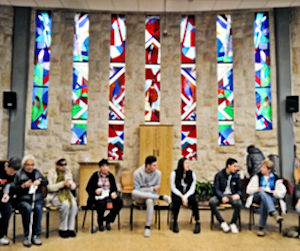 I twice visited The Alexander Muss High School in Israel (AMHSI) with CAARI.
AMHSI was founded in 1972 and was the only pluralist, non-denominational, fully accredited
international study-abroad program in Israel for high school students. On this program,
students spent a semester or more of the academic school year or summer in Israel during
their sophomore, junior or senior year of high school and they earned full high school
credit for their time there.
I twice visited The Alexander Muss High School in Israel (AMHSI) with CAARI.
AMHSI was founded in 1972 and was the only pluralist, non-denominational, fully accredited
international study-abroad program in Israel for high school students. On this program,
students spent a semester or more of the academic school year or summer in Israel during
their sophomore, junior or senior year of high school and they earned full high school
credit for their time there. The AMHSI Hod Hasharon campus was located in the Mosonson Youth Village, about 20 minutes north and east of Tel Aviv. It served as a home for about 1000 international students each year (mostly American) who lived and studied there. On each visit we met with new students and staff who briefed us on the school, the program, the students, etc. and then escorted us around the campus. The Alexander Muss High School in Israel provided a truly unique and excellent opportunity for high school students who had the incentive, attitude and aptitude to become immersed in a chance-of-a-lifetime experience in a very special foreign land. Herodium: 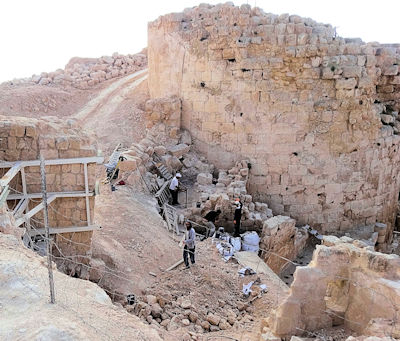 My CAARI visit to Herodium took place in 2014. Herodium was situated on a man-made hill.
The views of the surrounding countryside, fields, hills, villages, and towns from the summit
were magnificent. Herodium testified to the engineering and architectural brilliance of
Herod the Great, who had the fortress and other structures built. The ruins were
spectacular and the water system with its tunnels hewed out of solid rock was unbelievable.
We explored the mikvehs (ritual baths), the rebel-built synagogue and numerous
other rooms and structures.
My CAARI visit to Herodium took place in 2014. Herodium was situated on a man-made hill.
The views of the surrounding countryside, fields, hills, villages, and towns from the summit
were magnificent. Herodium testified to the engineering and architectural brilliance of
Herod the Great, who had the fortress and other structures built. The ruins were
spectacular and the water system with its tunnels hewed out of solid rock was unbelievable.
We explored the mikvehs (ritual baths), the rebel-built synagogue and numerous
other rooms and structures. We returned partway down the hill through the water tunnels. Near the tunnel exit, we got a chance to view what was believed to be Herod’s tomb. Herodium was another of the myriad must-see sights in Israel. Archaeological exploration and reconstruction continued at the site and one could expect to see more and more finds uncovered and added to this already-fantastic location. Kfar Etzion: 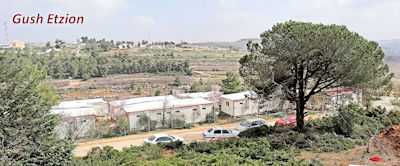 The Gush Etzion (Etzion Block) was a cluster of Israeli settlements in the
West Bank, located in the rugged Judean Mountains directly south and
slightly east of Jerusalem and Bethlehem. The core group included
4 Jewish agricultural villages that were destroyed by Jordan’s Arab Legion
during the 1948 Arab-Israeli War. The villages had previously been destroyed during the 1929
and 1936 Arab pogroms. The area was left outside the 1949 armistice lines. These settlements
were rebuilt after the 1967 6-Day War, along with new communities that had expanded the
area of the Etzion Block. As of 2011, the Gush Etzion consisted of 22 settlements and
had a population of 80,000. The Gush Etzion region contained picturesque rolling hills
adorned with grape arbors and olive groves and brimmed with biblical and modern history.
The Gush Etzion (Etzion Block) was a cluster of Israeli settlements in the
West Bank, located in the rugged Judean Mountains directly south and
slightly east of Jerusalem and Bethlehem. The core group included
4 Jewish agricultural villages that were destroyed by Jordan’s Arab Legion
during the 1948 Arab-Israeli War. The villages had previously been destroyed during the 1929
and 1936 Arab pogroms. The area was left outside the 1949 armistice lines. These settlements
were rebuilt after the 1967 6-Day War, along with new communities that had expanded the
area of the Etzion Block. As of 2011, the Gush Etzion consisted of 22 settlements and
had a population of 80,000. The Gush Etzion region contained picturesque rolling hills
adorned with grape arbors and olive groves and brimmed with biblical and modern history. Gush Etzion fell to the Jordanians on the day prior to the declaration of Israel’s independence. 250 captured defenders were murdered by the Jordanians. Their deaths are remembered by Israel’s Memorial Day, Yom Hazikaron, which was established on the day of their murders, one day before Yom HaAtzmaut, Israel’s Independence Day. Although Jews in Gush Etzion had to abandon their homes during Israel’s War of Independence, the inhabitants never forgot them, and over the years they would come to gaze from a distance at a huge, lone oak tree, the Alon Shvut - “oak of return” - which they could see on the horizon. This ancient oak became a treasured visitors' site. Gush Etzion was a “settlement”, meaning it was sanctioned, funded and supported by the Israeli government. As of 2014, there had been no new settlements in the previous 15-years, but, existing settlements had expanded. Kfar Etzion was a kibbutz. It was surrounded by a barbed-wire topped security fence and entrance was via a guarded entry-gate. On its 2014 visit, CAARI watched the moving audio-visual presentation at the visitor’s center and viewed the bunker in which the defenders held out until their final day. We then went up on the roof of the visitor’s center to get a good view of the kibbutz and the surrounding area. Kibbutz Nahsholim and DOR: 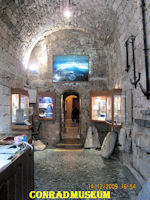 Kibbutz Nahsholim was a kibbutz and beach resort in northern Israel near Zikhron
Ya'akov. A glass bottle factory was founded by Baron Rothschild in 1891
but failed because the sand from the local beach was not of the proper quality.
In 2012, the building had been converted into the CONRAD Archaeological Museum
(Center for Nautical and Regional Archaeology at Dor). Kurt Raveh had founded
CONRAD and had recovered the items on display from the bottom of the Mediterranean
Sea, mostly at the old seaport of Dor.
Kibbutz Nahsholim was a kibbutz and beach resort in northern Israel near Zikhron
Ya'akov. A glass bottle factory was founded by Baron Rothschild in 1891
but failed because the sand from the local beach was not of the proper quality.
In 2012, the building had been converted into the CONRAD Archaeological Museum
(Center for Nautical and Regional Archaeology at Dor). Kurt Raveh had founded
CONRAD and had recovered the items on display from the bottom of the Mediterranean
Sea, mostly at the old seaport of Dor. 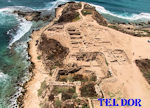 Founded 3,500 years ago, biblical Dor was once the
maritime capital of the Carmel coast. Tel Dor was an archeological site
lying on a small headland at the north side of a protected inlet at the Dor beach.
The documented history of the site began in the Late Bronze Age, around 2000 BCE,
and ended in the Crusader period.
CAARI explored Tel Dor and CONRAD under the guidance of Kurt Raveh.
Founded 3,500 years ago, biblical Dor was once the
maritime capital of the Carmel coast. Tel Dor was an archeological site
lying on a small headland at the north side of a protected inlet at the Dor beach.
The documented history of the site began in the Late Bronze Age, around 2000 BCE,
and ended in the Crusader period.
CAARI explored Tel Dor and CONRAD under the guidance of Kurt Raveh. Negev R&D Station: 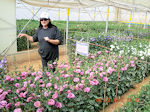 The Negev R&D Station was one of 8 in Israel, with this one focusing on covered agriculture,
i.e., agriculture that takes places under various types of shading nets. The research
carried out there was cutting-edge and involved many approaches for improving agricultural
yield, reducing water consumption, reducing the need for pesticides, reducing costs, etc.
The results were impressive, and, as a result, Israel had continued to be a leading
producer of fruits, nuts, vegetables and flowers. The results of the work performed there
were provided free to all agricultural and horticultural users. CAARI took a guided
tour of the Research Station and performed a bit of volunteer work by collecting and
packaging wheat samples from one of the hothouses for later analysis.
The Negev R&D Station was one of 8 in Israel, with this one focusing on covered agriculture,
i.e., agriculture that takes places under various types of shading nets. The research
carried out there was cutting-edge and involved many approaches for improving agricultural
yield, reducing water consumption, reducing the need for pesticides, reducing costs, etc.
The results were impressive, and, as a result, Israel had continued to be a leading
producer of fruits, nuts, vegetables and flowers. The results of the work performed there
were provided free to all agricultural and horticultural users. CAARI took a guided
tour of the Research Station and performed a bit of volunteer work by collecting and
packaging wheat samples from one of the hothouses for later analysis. Mitzpe Gevulot:  Mitzpe Gevulot was started in 1943, but was abandoned a short time later. The original
mud-walled buildings had remained as a sort of museum to show what life was like in the
years immediately prior to the establishment of the State of Israel. The walls and
buildings reminded me of the type of construction seen in buildings from the American
southwest that date back to the 18th and 19th centuries, even to those of the Hopi
Indians. CAARI finished its visit to Mitzpe Gevulot by planting some 20-plus
trees to help form a wind-break for the Mitzpe.
Mitzpe Gevulot was started in 1943, but was abandoned a short time later. The original
mud-walled buildings had remained as a sort of museum to show what life was like in the
years immediately prior to the establishment of the State of Israel. The walls and
buildings reminded me of the type of construction seen in buildings from the American
southwest that date back to the 18th and 19th centuries, even to those of the Hopi
Indians. CAARI finished its visit to Mitzpe Gevulot by planting some 20-plus
trees to help form a wind-break for the Mitzpe. Latrun: 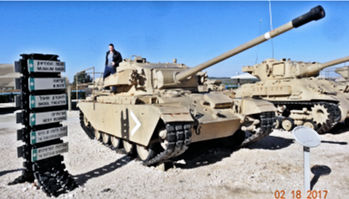 Located about half-way between Tel Aviv and Jerusalem was Latrun. This hilltop
town has had a unique position in the history of the country of Israel. It was the site of the
Biblical battles of Joshua Bin-Nun against the Amorite kings and where Judah the
Maccabee defeated the army of Antiochus. Located at latrun was Yad La-Shiryon,
Israel's official memorial site for fallen soldiers from the armored corps, as well as one of
the most diverse tank museums in the world. We were able to climb on the tanks and armored
vehicles, while a member of the IDF guided us through the site and explained the various
historical features of Yad La-Shiryon to us..
Located about half-way between Tel Aviv and Jerusalem was Latrun. This hilltop
town has had a unique position in the history of the country of Israel. It was the site of the
Biblical battles of Joshua Bin-Nun against the Amorite kings and where Judah the
Maccabee defeated the army of Antiochus. Located at latrun was Yad La-Shiryon,
Israel's official memorial site for fallen soldiers from the armored corps, as well as one of
the most diverse tank museums in the world. We were able to climb on the tanks and armored
vehicles, while a member of the IDF guided us through the site and explained the various
historical features of Yad La-Shiryon to us.. Yellin House and Motza Synagogue: 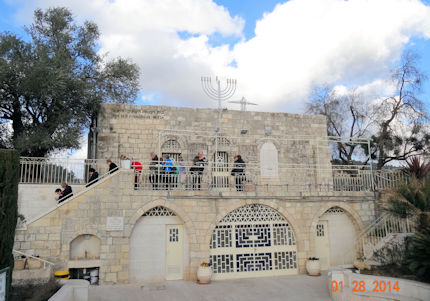 In 2014, CAARI provided a narrated tour, of the Yellin House and Motza Synagogue, located on
the northern side of the Jerusalem–Tel Aviv highway on the western edge of Jerusalem.
The history of the site was explained during our tour of the house, synagogue and grounds.
In 2014, CAARI provided a narrated tour, of the Yellin House and Motza Synagogue, located on
the northern side of the Jerusalem–Tel Aviv highway on the western edge of Jerusalem.
The history of the site was explained during our tour of the house, synagogue and grounds. In 1871, Yehoshua and Sarah Yellin built an inn for travelers en route between Tel Aviv and Jerusalem on the remains of a crusader building. A synagogue was built inside the inn in 1905. The Yellin House was behind the synagogue. In 1961, when the first families settled the lower area of the Motza neighborhood, the inn became the synagogue for the community. In 1973, the area next to the synagogue was excavated, and remains from the second temple period were found. Near the synagogue was a spring, which was believed to be the spring mentioned in the Book of Joshua. This was the border between the land of the tribe of Judah and that of the tribe of Benjamin. Sorek Cave: 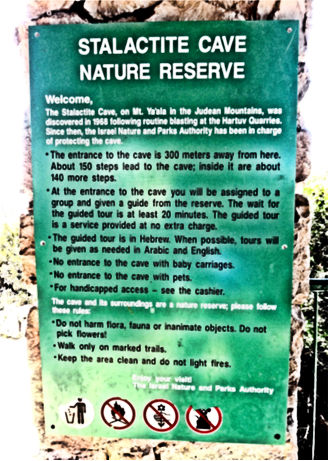 The Sorek Cave, also known as the Stalactite Cave was an example of “Natural Beauty”.
Located between Jerusalem and Beit Shemesh, in the western slopes of the
Judean Hills, the cave averaged about two hundred feet in both length and width
and totalled about an acre in area, making it Israel's largest cave.
The Sorek Cave, also known as the Stalactite Cave was an example of “Natural Beauty”.
Located between Jerusalem and Beit Shemesh, in the western slopes of the
Judean Hills, the cave averaged about two hundred feet in both length and width
and totalled about an acre in area, making it Israel's largest cave. The beautiful formations in the cave were made from years of dripping water. This cave provided a full representation of almost all types of stalagmites and stalactites found in larger caves worldwide. A 30-minute tour of the cave allowed CAARI to view formations that could be interpreted as depicting: a guardian angel, ice cream cones, Snow White and the Seven Dwarfs, a baboon, a marrying couple, a wedding cake, and Romeo and Juliet. In Jerusalem: CAARI always ends its annual program in Jerusalem. In the Holy City, CAARI arranged for numerous guided visits to a variety of interesting locations, as well as leaving adequate time for individual visits at one’s leisure. Some of the many sites in Jerusalem visited by CAARI were: Yad Vashem, Jerusalem Botanical Gardens, Menachem Begin Heritage Center, Mount of Olives, Jewish Quarter in the Old City, Mt. Scopus, Israel Museum, Yad LaKashish, Gazelle Valley, Machane Yehuda Market, Karaite Heritage Center, the Cardo, Hurva Synagogue, Western Wall Tunnel, the Kotel, The Great Synagogue, Tower of David Museum, First Railway Station, The German Colony, Mamilla Mall, the Citadel, and the Kishle. Mt. Scopus and the Mount of Olives: 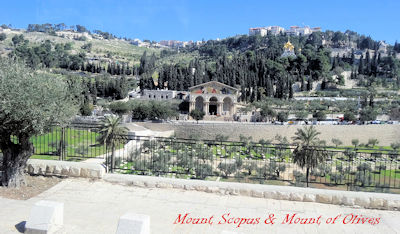 Mt. Scopus and the Mount of Olives were the perfect places from which to gain one’s first
views of Jerusalem. Both hills provided stunning views of the Old City and the
Temple Mount. Located on Mt. Scopus were the Hadassah Hospital and the
Hebrew University.
Mt. Scopus and the Mount of Olives were the perfect places from which to gain one’s first
views of Jerusalem. Both hills provided stunning views of the Old City and the
Temple Mount. Located on Mt. Scopus were the Hadassah Hospital and the
Hebrew University. Yad Vashem: 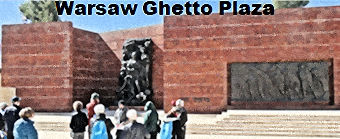 No trip to Israel and Jerusalem was complete without a visit to Yad, Vashem,
the Holocaust memorial and museum. CAARI went to Yad Vashem almost annually,
usually with a guided portion and then time to tour at one’s own leisure.
Yad Vashem cannot be described - it can only be experienced. It was not an easy experience.
No trip to Israel and Jerusalem was complete without a visit to Yad, Vashem,
the Holocaust memorial and museum. CAARI went to Yad Vashem almost annually,
usually with a guided portion and then time to tour at one’s own leisure.
Yad Vashem cannot be described - it can only be experienced. It was not an easy experience. Old City Walls: 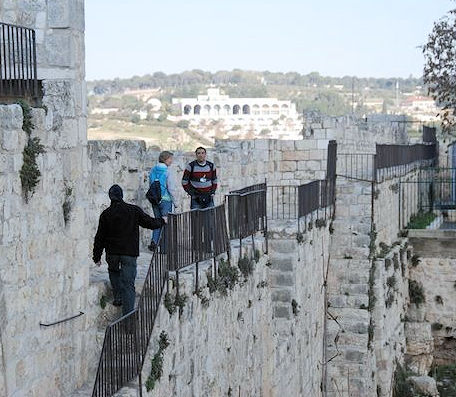 The 2.5 mile walk on top of the Old City Walls allowed me to get an up-close and personal
appreciation of the Old City and the areas just outside the Old City’s walls. The limestone walls date
back to the 16th century. Ottoman Sultan Suleiman the Magnificent ordered the
ramparts built after his father, Selim the Grim, brought Jerusalem under Turkish
rule in 1517.
The 2.5 mile walk on top of the Old City Walls allowed me to get an up-close and personal
appreciation of the Old City and the areas just outside the Old City’s walls. The limestone walls date
back to the 16th century. Ottoman Sultan Suleiman the Magnificent ordered the
ramparts built after his father, Selim the Grim, brought Jerusalem under Turkish
rule in 1517. The wall had eight open gates. The sealed historic gates comprised four that were at least partially preserved. Several other gates were discovered by archaeologists of which only traces remained. Tower of David Museum: 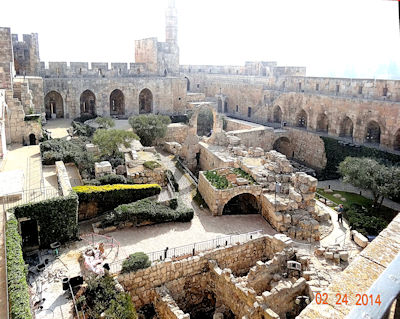 This Museum was set in the restored ancient citadel first constructed 2,000 years ago by
Herod the Great. The Museum traced Jerusalem’s 4,000-year eventful history through
state-of-the-art displays and exhibits. I visited the museum on several occasions with CAARI.
The uppermost level of the citadel had a spectacular 360-degree view of both the Old City and
New City of Jerusalem.
This Museum was set in the restored ancient citadel first constructed 2,000 years ago by
Herod the Great. The Museum traced Jerusalem’s 4,000-year eventful history through
state-of-the-art displays and exhibits. I visited the museum on several occasions with CAARI.
The uppermost level of the citadel had a spectacular 360-degree view of both the Old City and
New City of Jerusalem. Adjacent to the Tower of David was the site known as the “Kishle” which CARRI toured in 2017. The structure was erected in 1834 by Ibrahim Pasha who governed Palestine from Egypt. When the Ottoman Turks regained the area in 1841, the “Kishle” continued to serve as a military compound. During the period of the British mandate, it was used as a police station and prison. When visited by CAARI, the prison was separated from the police station and was an integral part of the Museum complex. Archaeological excavations unearthed remains from as early as the 6th century BCE and walls from the time of King Herod as well as evidence from the Middle Ages. Of particular importance was the discovery of a wall from the First Temple Period. The Night Spectacular: The Night Spectacular took place at the Tower of David Museum. The walls of the Citadel served as a screen for a laser light show which told the story of Jerusalem. The show used a sophisticated computer system, 20 projectors, 10 video players, 14 computers and 14 loudspeakers. It was a magnificent evening show. The Kotel: 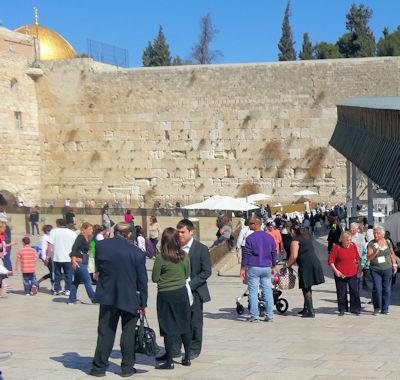 Every visit of mine to Jerusalem included a trip to the Kotel or Western Wall. There,
I’ve prayed, left notes in the wall or just stood and contemplated the long history of
Jerusalem, the Holy Land, and the Jewish People. The wall was originally erected as part
of the expansion of the Second Temple begun by Herod the Great, which
resulted in the encasement of the natural, steep hill known as the Temple Mount,
in a large rectangular structure topped by a huge flat platform, thus creating more space
for the Temple itself and its auxiliary buildings. The wall has been considered holy by
Jews because of its connection to the Temple Mount. Because of the Temple Mount entry
restrictions by the Muslim WAQF the Western Wall was the holiest place where
we Jews were permitted to pray.
Every visit of mine to Jerusalem included a trip to the Kotel or Western Wall. There,
I’ve prayed, left notes in the wall or just stood and contemplated the long history of
Jerusalem, the Holy Land, and the Jewish People. The wall was originally erected as part
of the expansion of the Second Temple begun by Herod the Great, which
resulted in the encasement of the natural, steep hill known as the Temple Mount,
in a large rectangular structure topped by a huge flat platform, thus creating more space
for the Temple itself and its auxiliary buildings. The wall has been considered holy by
Jews because of its connection to the Temple Mount. Because of the Temple Mount entry
restrictions by the Muslim WAQF the Western Wall was the holiest place where
we Jews were permitted to pray. The Western Wall Tunnel: 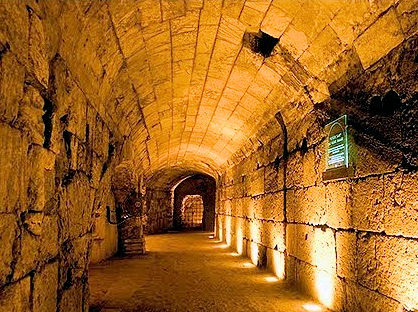 In 2011, I went with CAARI on an exploration of the Western Wall Tunnel, starting at the
Kotel and ending in the Muslim Quarter of the Old City at the
Via Dolorosa. The massive stone work, the ancient water works, and the tunneling
itself were almost unbelievable, considering the state of technology when construction
took place over 2,000 years ago. The Western Wall Tunnel was an underground tunnel exposing
the full length of the Western Wall. The tunnel was adjacent to the Western Wall
and was located under buildings of the Old City of Jerusalem. While the open-air portion
of the Western Wall was approximately 200 ft long, the majority of its original length was hidden
underground. The tunnel allowed access to an additional 1,591 ft of the wall.
In 2011, I went with CAARI on an exploration of the Western Wall Tunnel, starting at the
Kotel and ending in the Muslim Quarter of the Old City at the
Via Dolorosa. The massive stone work, the ancient water works, and the tunneling
itself were almost unbelievable, considering the state of technology when construction
took place over 2,000 years ago. The Western Wall Tunnel was an underground tunnel exposing
the full length of the Western Wall. The tunnel was adjacent to the Western Wall
and was located under buildings of the Old City of Jerusalem. While the open-air portion
of the Western Wall was approximately 200 ft long, the majority of its original length was hidden
underground. The tunnel allowed access to an additional 1,591 ft of the wall.Hurva Synagogue: 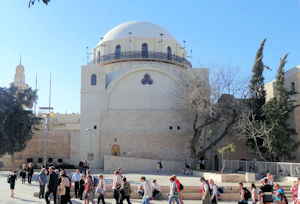 I visited the Hurva Synagogue more than once with CAARI. The synagogue dated back to the
13th century and the predecessor to the current structure was built and destroyed several
times over the centuries – the last destruction being when the Jordanians blew it up after
they occupied the Old City in 1948. The modern Hurva Synagogue was rebuilt and rededicated in
2010.
I visited the Hurva Synagogue more than once with CAARI. The synagogue dated back to the
13th century and the predecessor to the current structure was built and destroyed several
times over the centuries – the last destruction being when the Jordanians blew it up after
they occupied the Old City in 1948. The modern Hurva Synagogue was rebuilt and rededicated in
2010. Wohl Archaeological Museum: 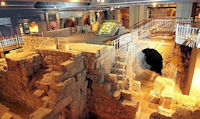 I went with CAARI on a tour of the Wohl Archaeological Museum. The museum was the archaeological
remains of 6 homes from the Second Temple Period. In Temple times, this part of the
city was home to wealthy priestly families. Homes were built on the hill overlooking the
Temple Mount, with the roof of each home at the basement level of the house above it, so
that every house enjoyed a spectacular view of the Temple. Many of the uncovered items there
were in pristine condition and this was another must-see place.
I went with CAARI on a tour of the Wohl Archaeological Museum. The museum was the archaeological
remains of 6 homes from the Second Temple Period. In Temple times, this part of the
city was home to wealthy priestly families. Homes were built on the hill overlooking the
Temple Mount, with the roof of each home at the basement level of the house above it, so
that every house enjoyed a spectacular view of the Temple. Many of the uncovered items there
were in pristine condition and this was another must-see place. Mamilla Mall: 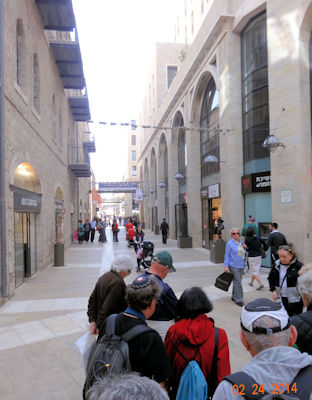 Every visit to Jerusalem has involved a walk through the outdoor upscale Mamilla Mall
which led into the Old City through the Jaffa Gate.
The mall consisted of a 2,000-foot
pedestrian promenade lined by 140 stores, restaurants, and cafes, and office space on
upper floors. The mall sat atop a multi-story parking garage for 1,600 cars and buses,
and a bus terminal. The mall incorporated the facades of 19th-century buildings from
the original Mamilla Street, as well as the original structures of the Convent of St.
Vincent de Paul, the Stern House, and the Clark House.
Mamilla Mall was a great place at which to people-watch, have a cup of coffee, eat,
and shop.
Every visit to Jerusalem has involved a walk through the outdoor upscale Mamilla Mall
which led into the Old City through the Jaffa Gate.
The mall consisted of a 2,000-foot
pedestrian promenade lined by 140 stores, restaurants, and cafes, and office space on
upper floors. The mall sat atop a multi-story parking garage for 1,600 cars and buses,
and a bus terminal. The mall incorporated the facades of 19th-century buildings from
the original Mamilla Street, as well as the original structures of the Convent of St.
Vincent de Paul, the Stern House, and the Clark House.
Mamilla Mall was a great place at which to people-watch, have a cup of coffee, eat,
and shop. Machane Yehuda Market: 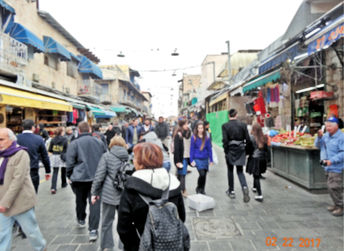 Machane Yehuda was popular with locals and tourists alike. When I visited it, it had
more than 250 vendors selling fresh fruits and vegetables, baked goods, fish, meat and
cheeses, nuts, seeds, and spices, wines and liquors, clothing and shoes; housewares,
textiles, Judaica and more.
Machane Yehuda was popular with locals and tourists alike. When I visited it, it had
more than 250 vendors selling fresh fruits and vegetables, baked goods, fish, meat and
cheeses, nuts, seeds, and spices, wines and liquors, clothing and shoes; housewares,
textiles, Judaica and more. Jerusalemites viewed the Machane Yehuda Market as a place that represented them, symbolized them, and gave them a unique identity in a larger Israeli social context. In and around the market were falafel, shawarma, kibbeh, kebab, shashlik, kanafeh, baklava, halva, zalabiya and Jerusalem mixed grill stands, juice bars, cafes, and restaurants. The color and bustle of the marketplace was accentuated by vendors who yelled out their prices to the passersby. Artists’ Colony: 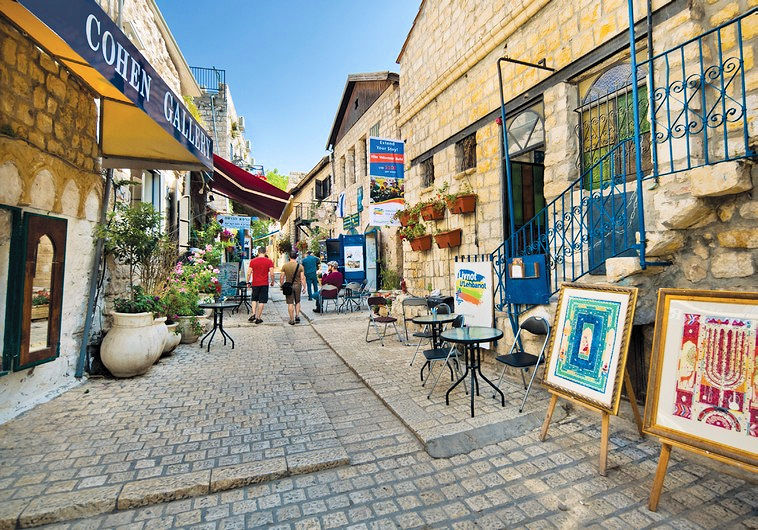 The Artists’ Colony is near the Jaffa Gate, just outside the Old City. Prior to 1967,
it lay between the Jordanian controlled Old City and Israeli western Jerusalem.
Jordanian snipers shot at anyone in this no-man’s land and it decayed. After Israel wrested
the Old City of Jerusalem from the Jordanian forces in the
1967 War, the area was turned into an artists’ colony. The area was later saved from
real-estate developers and was a pleasant shopping area when CAARI visited it.
The Artists’ Colony is near the Jaffa Gate, just outside the Old City. Prior to 1967,
it lay between the Jordanian controlled Old City and Israeli western Jerusalem.
Jordanian snipers shot at anyone in this no-man’s land and it decayed. After Israel wrested
the Old City of Jerusalem from the Jordanian forces in the
1967 War, the area was turned into an artists’ colony. The area was later saved from
real-estate developers and was a pleasant shopping area when CAARI visited it. Mt. Herzl: 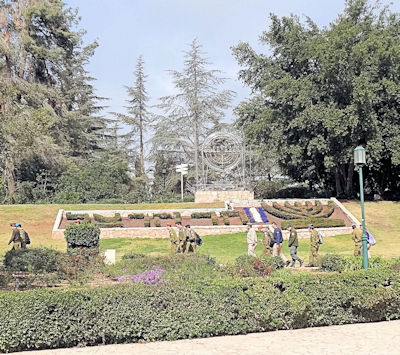 I twice visited Mt. Herzl with CAARI. Located on the west side of Jerusalem, nearly all
of Israel’s presidents, prime ministers and chairs of the Knesset are buried there. In
a separate part of Mt. Herzl is Jerusalem’s military cemetery, with many monuments nearby.
Theodore Herzl's tomb lies atop the hill. Israel's war dead are also buried there.
Mt. Herzl is so amazing because buried there or memorialized there are so many of the
people who were responsible for the rebirth of the Jewish nation.
I twice visited Mt. Herzl with CAARI. Located on the west side of Jerusalem, nearly all
of Israel’s presidents, prime ministers and chairs of the Knesset are buried there. In
a separate part of Mt. Herzl is Jerusalem’s military cemetery, with many monuments nearby.
Theodore Herzl's tomb lies atop the hill. Israel's war dead are also buried there.
Mt. Herzl is so amazing because buried there or memorialized there are so many of the
people who were responsible for the rebirth of the Jewish nation. Yad LaKashish: 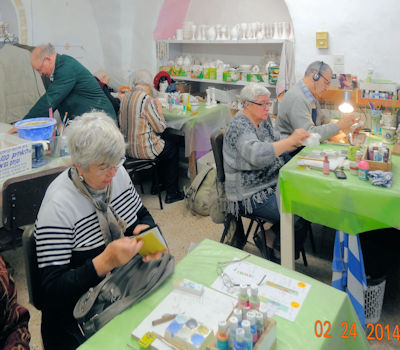 I’ve visited Yad LaKashish (Lifeline for the Aged) with CAARI several times.
Yad LaKashish was started in 1962 and provided a place where some 350 low income
seniors came to create hand-made Judaica and craft items, which were then sold in the
Yad LaKashish gift shop. They even created their own paper from recycled paper.
These senior citizens received a stipend, breakfast, lunch and passes that entitled
them to use the municipal bus system free of charge for working mornings during
the workweek.
I’ve visited Yad LaKashish (Lifeline for the Aged) with CAARI several times.
Yad LaKashish was started in 1962 and provided a place where some 350 low income
seniors came to create hand-made Judaica and craft items, which were then sold in the
Yad LaKashish gift shop. They even created their own paper from recycled paper.
These senior citizens received a stipend, breakfast, lunch and passes that entitled
them to use the municipal bus system free of charge for working mornings during
the workweek. We toured the workshops and met with the people working there. The skills exhibited were quite surprising and the prices were more than reasonable – a great place to purchase gifts for the people back home. Museum of Underground Prisoners: 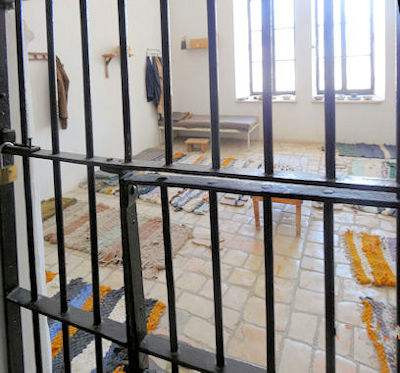 Not far from Yad LaKashish was the Museum of Underground Prisoners. This museum commemorated
the activity of the Jewish underground —
Haganah, Irgun and Lehi — during the period leading up the
establishment of the State of Israel. The museum contained a memorial room for the
13 members of the three underground groups who were hanged during the British mandate.
CAARI watched a short introductory film and then toured the prison with an Israeli guide.
Not far from Yad LaKashish was the Museum of Underground Prisoners. This museum commemorated
the activity of the Jewish underground —
Haganah, Irgun and Lehi — during the period leading up the
establishment of the State of Israel. The museum contained a memorial room for the
13 members of the three underground groups who were hanged during the British mandate.
CAARI watched a short introductory film and then toured the prison with an Israeli guide. The German Colony: 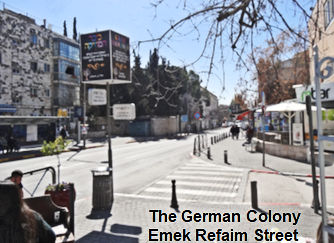 Trips to Jerusalem usually included visits to the German Colony which was a neighborhood,
established in the 2nd half of the 19th century by members of the German Temple Society.
In the 21st century, the German Colony became an upscale neighborhood with trendy shops, excellent
restaurants and several cafes. Since the end of the 20th century, the neighborhood has
undergone a process of gentrification. Efforts were being made to restore old landmark
buildings and incorporate some of their architectural features in new construction.
Numerous cafes, bars, restaurants, and boutiques opened in the neighborhood,
and many affluent families moved there, pushing up the price of real estate.
The German Colony had a large English-speaking population.Its main street,
Emek Refaim was a very pleasant place at which to stroll, shop and eat.
Trips to Jerusalem usually included visits to the German Colony which was a neighborhood,
established in the 2nd half of the 19th century by members of the German Temple Society.
In the 21st century, the German Colony became an upscale neighborhood with trendy shops, excellent
restaurants and several cafes. Since the end of the 20th century, the neighborhood has
undergone a process of gentrification. Efforts were being made to restore old landmark
buildings and incorporate some of their architectural features in new construction.
Numerous cafes, bars, restaurants, and boutiques opened in the neighborhood,
and many affluent families moved there, pushing up the price of real estate.
The German Colony had a large English-speaking population.Its main street,
Emek Refaim was a very pleasant place at which to stroll, shop and eat. The First Station 1892: 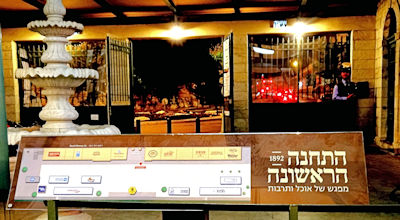 The resurrected old Jerusalem train Station, now called “The First Station 1892” functioned
as a meeting point for the public to enjoy the wealth of cultural and culinary experiences
offered there. The old train tracks were partially covered by a long deck creating a
pedestrian mall that housed eateries, a tourist information office, pub and marketplace.
It was adjacent to the German Colony section of Jerusalem.
The resurrected old Jerusalem train Station, now called “The First Station 1892” functioned
as a meeting point for the public to enjoy the wealth of cultural and culinary experiences
offered there. The old train tracks were partially covered by a long deck creating a
pedestrian mall that housed eateries, a tourist information office, pub and marketplace.
It was adjacent to the German Colony section of Jerusalem. Menachem Begin Heritage Center: 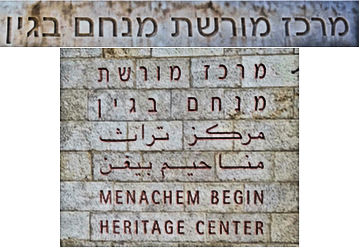 I was at the Menachem Begin Heritage Center twice with CAARI. There, prearranged guided tours of
the multi-media displays described the life and times of Menachem Begin from his birth
in Poland until his death in Israel in 1992. The Menachem Begin Heritage Center was the
official national memorial of Menachem Begin. The Center was located on the
western slope of the Hinnom Valley, overlooking Mount Zion and the
Old City of Jerusalem. It included several departments: A museum , archives,
a library and a research center.
I was at the Menachem Begin Heritage Center twice with CAARI. There, prearranged guided tours of
the multi-media displays described the life and times of Menachem Begin from his birth
in Poland until his death in Israel in 1992. The Menachem Begin Heritage Center was the
official national memorial of Menachem Begin. The Center was located on the
western slope of the Hinnom Valley, overlooking Mount Zion and the
Old City of Jerusalem. It included several departments: A museum , archives,
a library and a research center. Jerusalem Botanical Gardens: 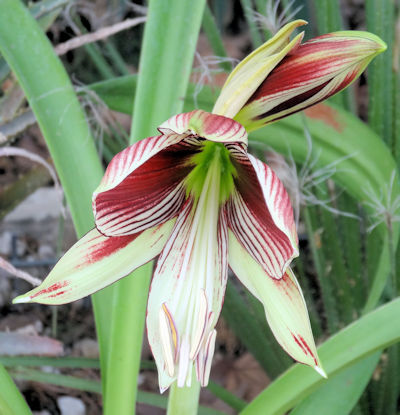 The Jerusalem Botanical Gardens were located in the heart of Jerusalem in the Neve She’an
area. It covered over 60 acres and had plants from all over the world. On one visit, we are
given a guided tour of the botanical gardens by Michael Avishai, who helped to found
the Botanical Gardens back in 1962. The Jerusalem Botanical Gardens served as an education and
research center and had its diverse collection of plants from around the world displayed
geographically. The Jerusalem Botanical Gardens attracted people from all backgrounds for
educational, scientific, cultural and recreational activities related to botany, horticulture,
agriculture and environmental protection. The Gardens’ staff also worked to influence public policy
in those fields. The Jerusalem Botanical Gardens were a real gem and it was
worth spending at least half a day there.
The Jerusalem Botanical Gardens were located in the heart of Jerusalem in the Neve She’an
area. It covered over 60 acres and had plants from all over the world. On one visit, we are
given a guided tour of the botanical gardens by Michael Avishai, who helped to found
the Botanical Gardens back in 1962. The Jerusalem Botanical Gardens served as an education and
research center and had its diverse collection of plants from around the world displayed
geographically. The Jerusalem Botanical Gardens attracted people from all backgrounds for
educational, scientific, cultural and recreational activities related to botany, horticulture,
agriculture and environmental protection. The Gardens’ staff also worked to influence public policy
in those fields. The Jerusalem Botanical Gardens were a real gem and it was
worth spending at least half a day there. Gazelle Valley: 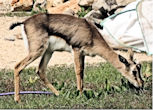 Gazelle Valley was a nature reserve for a herd of gazelles which has managed to survive within
the city limits of Jerusalem. Gazelle Valley was named for a herd of about 15 gazelles there.
Real estate developers had sought building rights in the area, but the Society for the
Protection of Nature in Israel (SPNI) and local activists fought to preserve the
natural surroundings. After lengthy court battles, the Jerusalem Municipality turned the area
into a public park and nature reserve. In 2017, CAARI spent some 2-hours in the park on a
guided tour that culminated in the planting of trees.
Gazelle Valley was a nature reserve for a herd of gazelles which has managed to survive within
the city limits of Jerusalem. Gazelle Valley was named for a herd of about 15 gazelles there.
Real estate developers had sought building rights in the area, but the Society for the
Protection of Nature in Israel (SPNI) and local activists fought to preserve the
natural surroundings. After lengthy court battles, the Jerusalem Municipality turned the area
into a public park and nature reserve. In 2017, CAARI spent some 2-hours in the park on a
guided tour that culminated in the planting of trees. Israel Museum: 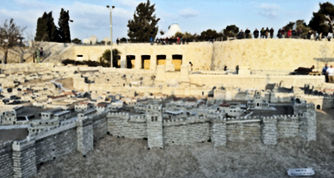 The Israel Museum was a world class gem and was the largest cultural institution in Israel,
occupying a 20-acre campus. CAARI frequently visited the museum with its large number of
indoor and outdoor displays and exhibits. Often, CAARI held it’s going-away dinner in the
Museum’s excellent restaurant. Within the museum complex were the Shrine of the Book
which housed the Dead Sea Scrolls and a very large detailed model of Jerusalem at
around the time of the Second Temple. The Israel Museum is a must-see.
The Israel Museum was a world class gem and was the largest cultural institution in Israel,
occupying a 20-acre campus. CAARI frequently visited the museum with its large number of
indoor and outdoor displays and exhibits. Often, CAARI held it’s going-away dinner in the
Museum’s excellent restaurant. Within the museum complex were the Shrine of the Book
which housed the Dead Sea Scrolls and a very large detailed model of Jerusalem at
around the time of the Second Temple. The Israel Museum is a must-see. Hadassah Hospital at Ein Keren: 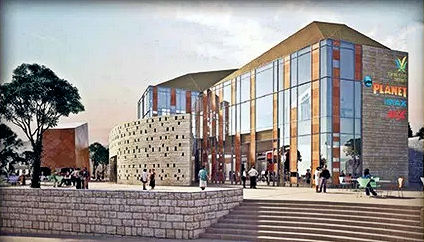 High on a remote hill on the southwestern edge of Jerusalem, CAARI visited the
Hadassah Hospital at Ein Keren, where I had the chance to view the world-famous 12 Chagall
Windows. In addition, we toured the modern hospital with its more than 22 buildings,
an underground medical facility, designed to survive a nuclear, biological or chemical attack,
and its array of shops and restaurants. The hospital was nominated for a Nobel prize in
2009 for outstanding medical care for all patients without regard to race, religion or
nationality.
High on a remote hill on the southwestern edge of Jerusalem, CAARI visited the
Hadassah Hospital at Ein Keren, where I had the chance to view the world-famous 12 Chagall
Windows. In addition, we toured the modern hospital with its more than 22 buildings,
an underground medical facility, designed to survive a nuclear, biological or chemical attack,
and its array of shops and restaurants. The hospital was nominated for a Nobel prize in
2009 for outstanding medical care for all patients without regard to race, religion or
nationality. Hebrew Union College: 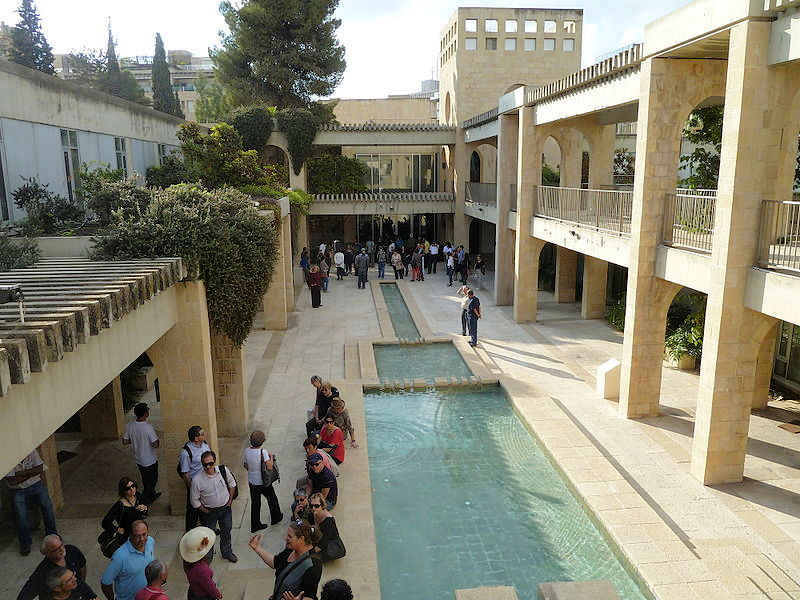 In 2011, CAARI visited the Hebrew Union College, the world headquarters for
reform or progressive Judaism, located almost next to the well-known King
David Hotel. There, we listened to the history and status of the Reform Movement,
particularly with respect to Israel. Established in 1963 as a post-doctoral center of
archaeological and biblical studies, the Hebrew Union College in Jerusalem campus had
grown since 1971 to serve as the center of Israel experience for stateside students,
including the Year-In-Israel Program. It prepared Israeli students for leadership.
In 2011, CAARI visited the Hebrew Union College, the world headquarters for
reform or progressive Judaism, located almost next to the well-known King
David Hotel. There, we listened to the history and status of the Reform Movement,
particularly with respect to Israel. Established in 1963 as a post-doctoral center of
archaeological and biblical studies, the Hebrew Union College in Jerusalem campus had
grown since 1971 to serve as the center of Israel experience for stateside students,
including the Year-In-Israel Program. It prepared Israeli students for leadership. Emek Tzurim National Park: 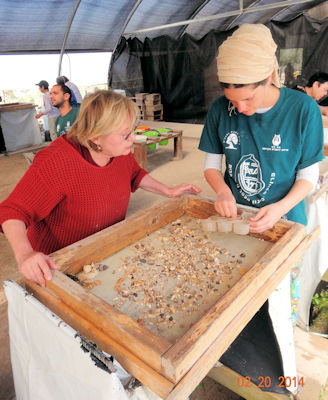 The Emek Tzurim National Park was at the
foot of Mt. Scopus in Jerusalem. In 2014, CAARI visited the Temple Mount
Sifting Project there. About 10 years previous, the Moslem WAQF, which was
in charge of affairs on the Temple Mount, did some illegal digging and construction
in the area known as Solomon’s Stable. They illegally disposed of material they had
dug up in a dump. Israel recovered the illegally discarded material and had been sifting
though it ever since, uncovering many items of historical and biblical significance.
The Emek Tzurim National Park was at the
foot of Mt. Scopus in Jerusalem. In 2014, CAARI visited the Temple Mount
Sifting Project there. About 10 years previous, the Moslem WAQF, which was
in charge of affairs on the Temple Mount, did some illegal digging and construction
in the area known as Solomon’s Stable. They illegally disposed of material they had
dug up in a dump. Israel recovered the illegally discarded material and had been sifting
though it ever since, uncovering many items of historical and biblical significance. Our CAARI group joined in the sifting and recovery work, finding several items of possible significance. Over the years, CAARI has been able to provide a large number of highly respected, relevant and extremely interesting speakers. Included in this Speakers’ Forum have been the following: Michael Ben Ari: 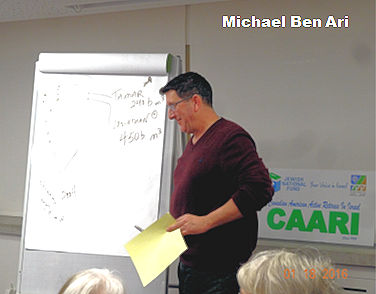 Michael Ben Ari was a graduate of Brandeis University and Tel Aviv University and he headed
up an international financial services company. He spoke, on 2 occasions, about “Israel’s
Energy”. His talks were highly relevant, considering the revolution in Israel's energy
situation as a result of the huge oil and gas finds off the shores of Israel. As usual in
Israel, politics, religion and social concerns were tending to muddle the development of
these oil and gas resources at the time of his talks.
Michael Ben Ari was a graduate of Brandeis University and Tel Aviv University and he headed
up an international financial services company. He spoke, on 2 occasions, about “Israel’s
Energy”. His talks were highly relevant, considering the revolution in Israel's energy
situation as a result of the huge oil and gas finds off the shores of Israel. As usual in
Israel, politics, religion and social concerns were tending to muddle the development of
these oil and gas resources at the time of his talks. Meri Eisen:  Meri Eisen was a speaker who had addressed CAARI more than once. Eisen was a retired
colonel in the IDF with a background in political science. She had been an official
government spokesperson charged with explaining and clarifying Israel’s positions on
topics that impacted its international standing. After leaving the military, Miri served
as the Israeli Prime Minister's international media advisor from the second Lebanon war
until the end of 2007. She also served in the Israeli intelligence community, and was then
working extensively with the media, student groups and diplomats. Meri Esien’s talks focused on
the military-political situation facing Israel.
Meri Eisen was a speaker who had addressed CAARI more than once. Eisen was a retired
colonel in the IDF with a background in political science. She had been an official
government spokesperson charged with explaining and clarifying Israel’s positions on
topics that impacted its international standing. After leaving the military, Miri served
as the Israeli Prime Minister's international media advisor from the second Lebanon war
until the end of 2007. She also served in the Israeli intelligence community, and was then
working extensively with the media, student groups and diplomats. Meri Esien’s talks focused on
the military-political situation facing Israel. Ehud Yaari: 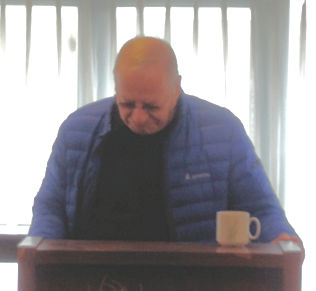 Ehud Yaari was an Israeli journalist, author, television personality and political commentator.
His credentials included being: an assistant to the Coordinator of Government Activities in
the Territories, the Arab affairs correspondent for the newspaper Davar and Israel Army Radio,
a commentator on Middle Eastern affairs on Israel’s television Channel 1, a fellow at the
Washington Institute for Near East Policy, a columnist for The Jerusalem Post, a commentator
on Arab affairs on Israel’s Channel 2 television, and in 2008, a senior fellow of the
Adelson Institute for Strategic Studies of the Shalem Center.
Ehud Yaari was an Israeli journalist, author, television personality and political commentator.
His credentials included being: an assistant to the Coordinator of Government Activities in
the Territories, the Arab affairs correspondent for the newspaper Davar and Israel Army Radio,
a commentator on Middle Eastern affairs on Israel’s television Channel 1, a fellow at the
Washington Institute for Near East Policy, a columnist for The Jerusalem Post, a commentator
on Arab affairs on Israel’s Channel 2 television, and in 2008, a senior fellow of the
Adelson Institute for Strategic Studies of the Shalem Center. In 2017, Yaari gave CAARI a highly insightful presentation on his views of Israel’s domestic and foreign situation and followed up on his presentation by taking questions. Noah Greenberg: 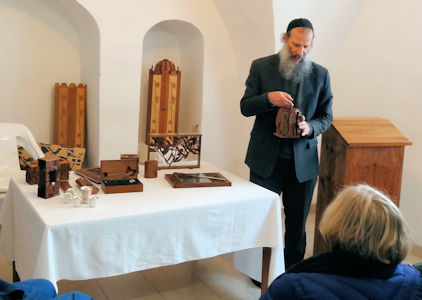 Noah Greenberg was a master carpenter living in Safed who produced a small prayer table and
book rest called a “shtender” for use in synagogues or homes. At his home, Noah Greenberg
enchanted CAARI with a running description and exhibition of an amazing and complex shtender
that he had designed, created and marketed. He showed us the many unique and
highly artistic pieces that are built into his amazing piece of woodworking artistry. A
Shtender was used when praying and studying, being a simple wooden lectern with
a top that slants so that a book can lean, facing the reader, to make it easier to read.
Noah Greenberg was a master carpenter living in Safed who produced a small prayer table and
book rest called a “shtender” for use in synagogues or homes. At his home, Noah Greenberg
enchanted CAARI with a running description and exhibition of an amazing and complex shtender
that he had designed, created and marketed. He showed us the many unique and
highly artistic pieces that are built into his amazing piece of woodworking artistry. A
Shtender was used when praying and studying, being a simple wooden lectern with
a top that slants so that a book can lean, facing the reader, to make it easier to read. Greenberg’s shtender contained all the objects that would represent Judaism's major holidays, life-cycle events and religious commandments - each object nested neatly into the shtender. These objects included a tefillin box (box for phylacteries), tzedakah (charity) box, esrog (citron) box for the Succoth holiday, Seder plate for Passover, Challah board for the Sabbath bread, Kiddush (sacramental wine) set, candlesticks for the Sabbath lights, a holder for the lulav that is used during the Succoth holiday, and a device for counting the omer, the days between Passover and Shavuot. Each object was carved with designs in the motif of the plants and trees of the Land of Israel, including the Seven Species of the Land. Tzammenet Lavie Daphna: 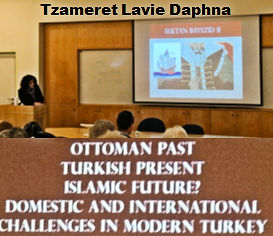 In 2016, Tzammenet Lavie Daphna presented a lecture to CAARI at IDC Herzliya. She
reviewed the history of Turkey and modern Turkey’s treatment of Jews and its relations
with Israel, beginning with the Ottoman Empire. Jews had long resided in Turkey but many
had left after the imposition of new taxes in 1949 and a “pogrom” in 1955. The recent
move of Turkey from secularism toward an Islamic leaning government has further soured
Turkey’s relations with Jews and Israel. Discrimination against Jews started in 2010
during Recep Tayyip Erdogan’s time as prime minister.
In 2016, Tzammenet Lavie Daphna presented a lecture to CAARI at IDC Herzliya. She
reviewed the history of Turkey and modern Turkey’s treatment of Jews and its relations
with Israel, beginning with the Ottoman Empire. Jews had long resided in Turkey but many
had left after the imposition of new taxes in 1949 and a “pogrom” in 1955. The recent
move of Turkey from secularism toward an Islamic leaning government has further soured
Turkey’s relations with Jews and Israel. Discrimination against Jews started in 2010
during Recep Tayyip Erdogan’s time as prime minister. Kurt Raveh: 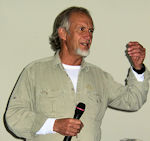 Kurt Raveh was a frequent speaker and guide for CAARI throughout the years.
Not Jewish, Kurt Raveh came to Israel from Holland, first as tourist, then as a
volunteer during the 1973 Yom Kippur War. He later married an Israeli, raised a
family and has never left Israel.
Kurt Raveh was a frequent speaker and guide for CAARI throughout the years.
Not Jewish, Kurt Raveh came to Israel from Holland, first as tourist, then as a
volunteer during the 1973 Yom Kippur War. He later married an Israeli, raised a
family and has never left Israel. Raveh, in 1986, was one of the archeologists that recovered the famous “Jesus Boat” from the bottom of the Kinneret which is now on display at the Yigal Allon Museum in Ginosar at the Sea of Galilee. Another ancient ship Raveh helped to recover, the Ma’agan Michael, is now housed in the Hecht Archaeological Museum. In addition, he has participated in the discovery of another 30 or more shipwrecks along the Mediterranean Coast of Israel. Raveh’s underwater searches have not been restricted to the seas in or around Israel. He was arrested for exploring the ancient sewers and water systems under the Temple Mount in Jerusalem and has explored water holes in the Judean Desert. Tamar Tal: 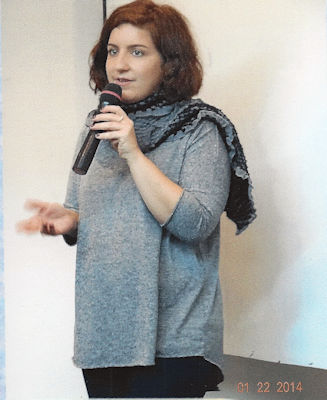 Tamar Tal was an Israeli film maker. In 2014, we watched her film “Life in Stills” and
listened to her tell about making the film. The film won the Israeli Oscar for Best Documentary
and Best First Film in 2012 and more than 20 international awards. It was screened in more than 100
film festivals around the world, including the 2013 Boston Jewish Film Festival. Following
the film and her presentation, she answered questions from our CAARI group.
Tamar Tal was an Israeli film maker. In 2014, we watched her film “Life in Stills” and
listened to her tell about making the film. The film won the Israeli Oscar for Best Documentary
and Best First Film in 2012 and more than 20 international awards. It was screened in more than 100
film festivals around the world, including the 2013 Boston Jewish Film Festival. Following
the film and her presentation, she answered questions from our CAARI group. “Life in Stills” documented the relationship between Miriam Weissenstein and her grandson, Ben, and related the story of their photography business and their studio, Photohouse, in Tel Aviv. It told about Miriam’s late husband Rudi’s life work in photographing and documenting the history of Israel, and of the city of Tel Aviv in particular. The film was humorous and poignant at the same time. Photohouse was still in operation in 2014 in Tel Aviv, under the management of Miriam’s grandson, Ben. Amotz Asa-El: 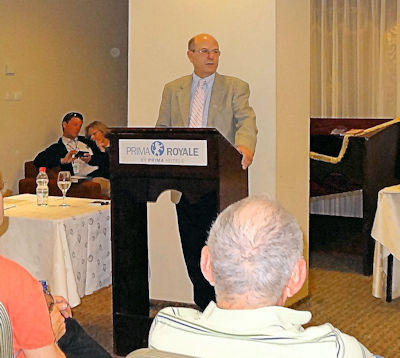 Amotz Asa-El was Executive Editor of the Jerusalem Post, a well-respected journalist since
the 1980’s, a leading commentator on Israeli,
Middle Eastern and Jewish affairs, Middle East commentator for the Wall Street Journal's
Market Watch, and the Jerusalem Post's senior columnist. Prior to joining the Jerusalem Post,
Asa-El was a foreign correspondent for the San Francisco Chronicle, and the foreign editor
of the Hebrew-language Financial Daily Telegraph. Asa-El led the launch of McGraw/Hill's
Hebrew edition of BusinessWeek. He was a frequent commentator of Middle Eastern affairs
on Reuters, the BBC, CNN, and IBA English News.
Amotz Asa-El was Executive Editor of the Jerusalem Post, a well-respected journalist since
the 1980’s, a leading commentator on Israeli,
Middle Eastern and Jewish affairs, Middle East commentator for the Wall Street Journal's
Market Watch, and the Jerusalem Post's senior columnist. Prior to joining the Jerusalem Post,
Asa-El was a foreign correspondent for the San Francisco Chronicle, and the foreign editor
of the Hebrew-language Financial Daily Telegraph. Asa-El led the launch of McGraw/Hill's
Hebrew edition of BusinessWeek. He was a frequent commentator of Middle Eastern affairs
on Reuters, the BBC, CNN, and IBA English News. In 2011, Asa EL was CAARI’s guest speaker in Jerusalem and presented a talk titled “The changing Middle East”. In 2014, Asa-El talked to CAARI about the chaos taking place in the Middle East. With regard to the Ukraine and Israel, he said that the situation then was quite serious and that there were still about 70,000 Jews remaining there who might consider immigrating to Israel because of the then current unrest. He spoke about Iraq, Syria and Lebanon and noted that many Israelis, viewed the Obama administration as naïve, gullible, short sighted and undependable. He mentioned that Israel had taken the position that it was too small to influence affairs in the Mid-East world and decided to take a hands-off position and let affairs work themselves out with little-to-no Israeli interference. Major Jonathon Konricous: 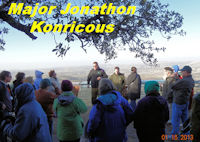 Major Konricous of the IDF addressed CAARI twice, once on the Israel-Lebanon border in 2013
and again on the Israel-Syria border. In 2013, CAARI received a briefing from then
Major Konricous on Mount Adir, right on the border between northern Israel
and southern Lebanon, near where Hezbollah terrorists had kidnapped 2 IDF soldiers in
2006 to start the 2nd Lebanon War. In 2014, we received a lengthy, comprehensive and
excellent briefing from Major Konricous on the volatile situation that existed in Syria,
particularly along the border between Syria and Israel in the Golan Heights area. The
mission of Major Konricous and his IDF unit was to gather intelligence on activities along
the border with Syria and to maintain liaison with UNDOF, the United Nations Disengagement
Observer Force to minimize conflict with the Syrian government forces and the Syrian rebels.
His mission also included the responsibility of gathering intelligence that would allow
Israel to be prepared for the future threats that were likely to arise. These days, many
of the official news releases on the unrest on Israel’s borders are coming from now Colonel
Jonathon Konricous.
Major Konricous of the IDF addressed CAARI twice, once on the Israel-Lebanon border in 2013
and again on the Israel-Syria border. In 2013, CAARI received a briefing from then
Major Konricous on Mount Adir, right on the border between northern Israel
and southern Lebanon, near where Hezbollah terrorists had kidnapped 2 IDF soldiers in
2006 to start the 2nd Lebanon War. In 2014, we received a lengthy, comprehensive and
excellent briefing from Major Konricous on the volatile situation that existed in Syria,
particularly along the border between Syria and Israel in the Golan Heights area. The
mission of Major Konricous and his IDF unit was to gather intelligence on activities along
the border with Syria and to maintain liaison with UNDOF, the United Nations Disengagement
Observer Force to minimize conflict with the Syrian government forces and the Syrian rebels.
His mission also included the responsibility of gathering intelligence that would allow
Israel to be prepared for the future threats that were likely to arise. These days, many
of the official news releases on the unrest on Israel’s borders are coming from now Colonel
Jonathon Konricous. Dr. Barak Efraim: 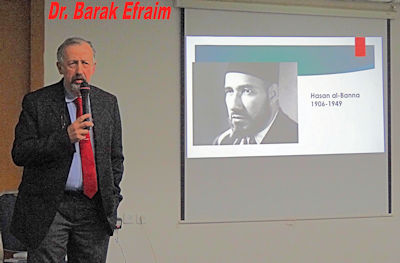 Dr. Barak Efraim from Bar Ilan University in Tel Aviv presented a talk to CAARI,
titled “Moslem Brotherhood in Egypt.” In his presentation, he explained how the
Moslem Brotherhood was founded and grew in Egypt; how its philosophy and goals evolved;
and what it stood for. The Moslem Brotherhood advocated violent struggle to achieve its goal
of Islamization and the universal adoption of Shari’a law. The terrorist organization,
Hamas, was a Moslem Brotherhood organization, and branches of the brotherhood
existed in Jordan and Syria.
Dr. Barak Efraim from Bar Ilan University in Tel Aviv presented a talk to CAARI,
titled “Moslem Brotherhood in Egypt.” In his presentation, he explained how the
Moslem Brotherhood was founded and grew in Egypt; how its philosophy and goals evolved;
and what it stood for. The Moslem Brotherhood advocated violent struggle to achieve its goal
of Islamization and the universal adoption of Shari’a law. The terrorist organization,
Hamas, was a Moslem Brotherhood organization, and branches of the brotherhood
existed in Jordan and Syria. Gill Hoffman: 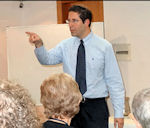 In 2013, Gill Hoffman talked to CAARI about the Israeli Elections that were coming up.
Gil Hoffman was the chief political correspondent and analyst for the Jerusalem Post.
Well-connected to Israeli and Palestinian political leaders, Hoffman had interviewed Prime Minister
Ehud Olmert, former prime ministers Sharon, Peres, Barak and Netanyahu and every major figure
across the Israeli political spectrum. He had been interviewed by top media outlets on
6 continents and was a regular analyst on CNN, BBC al Jazeera and other foreign news
outlets.
In 2013, Gill Hoffman talked to CAARI about the Israeli Elections that were coming up.
Gil Hoffman was the chief political correspondent and analyst for the Jerusalem Post.
Well-connected to Israeli and Palestinian political leaders, Hoffman had interviewed Prime Minister
Ehud Olmert, former prime ministers Sharon, Peres, Barak and Netanyahu and every major figure
across the Israeli political spectrum. He had been interviewed by top media outlets on
6 continents and was a regular analyst on CNN, BBC al Jazeera and other foreign news
outlets. In his talk, Hoffman identified one of the major differences between U.S. and Israeli elections – the U.S. election campaign was 3-years long while Israel’s was only 3-months long. He noted that one potential advantage for Bibi Netanyahu in the impending election was provided by U.S. President Obama’s apparent hostility toward Netanyahu and Israel. Israeli’s seemed to want a leader who would stand up to Obama and Netanyahu fit that image. Ben Sales: 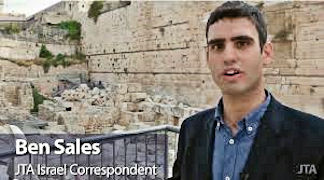 Ben Sales was the Israel correspondent on “Israel News” for the Jewish Telegraph Agency (JTA),
where he reported on Israeli politics, culture, society and economics, in addition to
covering Palestinian and regional affairs. Sales was a graduate of Washington University
in St. Louis and the Columbia University Journalism School. He was the editor-in-chief of
New Voices, the national Jewish student magazine.
Ben Sales was the Israel correspondent on “Israel News” for the Jewish Telegraph Agency (JTA),
where he reported on Israeli politics, culture, society and economics, in addition to
covering Palestinian and regional affairs. Sales was a graduate of Washington University
in St. Louis and the Columbia University Journalism School. He was the editor-in-chief of
New Voices, the national Jewish student magazine. Sales explained that Israel was a highly divergent country with its citizens enjoying the sport of arguing. On the religious front, he noted that “the times they are a’changing,” – but ever so slowly. According to Sales, both Israelis and Palestinians were skeptical that the Obama/Kerry American driven search for a Palestinian-Israeli peace plan would succeed. He also stated that Israelis were skeptical of the ultimate success of the American and European interim agreement with Iran. Abbie Rosner: 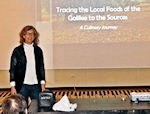 One of Abbie Rosner's presentations to CAARI, was titled “Foods of the Galilee”. Abbie Rosner
lived in the Galilee region of Israel since the late 1980s. She had written about the
multi-cultural culinary landscape of the Galilee for Gastronomica, Wine
Spectator and Lilith magazines. She led culinary tours in the Galilee
and authored the book, “Breaking Bread in Galilee: A Culinary Journey into the Promised
Land”, a few of which my wife purchased and had autographed as gifts for our friends.
Rosner’s presentations covered wild and cultivated indigenous edible plants and herbs that
grew in the Galilee and how they were gathered and prepared by the Arab and
Druze people living there.
One of Abbie Rosner's presentations to CAARI, was titled “Foods of the Galilee”. Abbie Rosner
lived in the Galilee region of Israel since the late 1980s. She had written about the
multi-cultural culinary landscape of the Galilee for Gastronomica, Wine
Spectator and Lilith magazines. She led culinary tours in the Galilee
and authored the book, “Breaking Bread in Galilee: A Culinary Journey into the Promised
Land”, a few of which my wife purchased and had autographed as gifts for our friends.
Rosner’s presentations covered wild and cultivated indigenous edible plants and herbs that
grew in the Galilee and how they were gathered and prepared by the Arab and
Druze people living there. Nisan Cohen: 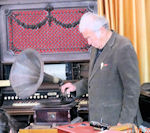 Nisan Cohen owned the NISCO Music Box Museum in the En Hod kibbutz of artists.
Cohen came from New York to Israel a few decades ago. He explained the history of the music
box to us and played several of them. These music boxes ranged in age from 70 years to more
than 150 years. All were in playing condition, some having been restored by Nisan.
In addition to demonstrating the antique music boxes, Nisan told stories and jokes in the
vein of an old borscht belt (the Catskill Mountain Jewish resorts in upper New State)
Yiddish comic. His presentation was highly informative and extremely entertaining.
Nisan Cohen owned the NISCO Music Box Museum in the En Hod kibbutz of artists.
Cohen came from New York to Israel a few decades ago. He explained the history of the music
box to us and played several of them. These music boxes ranged in age from 70 years to more
than 150 years. All were in playing condition, some having been restored by Nisan.
In addition to demonstrating the antique music boxes, Nisan told stories and jokes in the
vein of an old borscht belt (the Catskill Mountain Jewish resorts in upper New State)
Yiddish comic. His presentation was highly informative and extremely entertaining. Professor Yael Katzir: 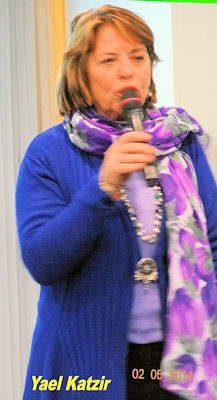 Professor Yael Katzir talked to CAARI about various documentary films she had made or
was making. One, titled, “2 Heroic Jewish Women” was made about Vitka
Kovner and Surika Braverman, who fought with the Vilna Forest Partisans
in Poland and Russia during the Second World War. In addition, we were shown a clip from
the film.
Professor Yael Katzir talked to CAARI about various documentary films she had made or
was making. One, titled, “2 Heroic Jewish Women” was made about Vitka
Kovner and Surika Braverman, who fought with the Vilna Forest Partisans
in Poland and Russia during the Second World War. In addition, we were shown a clip from
the film. Professor Katzir was born and raised in Tel Aviv. She completed the mandatory military service in the Israel Defense Force with the rank of lieutenant. Yael received her B.A. in English Literature and General History and her M.A. in Modern History at Jerusalem's Hebrew University. She went on to earn her teaching certification from Tel Aviv University and continued her studies at UCLA in Medieval History and then received her PhD from Hebrew University, specializing in the Crusades with a focus on "Papal Attitudes Toward Jerusalem in the 12th Century". Yael then received her MSC at the Boston College School of Communications in “Film Broadcasting.” Gadi Wexler: 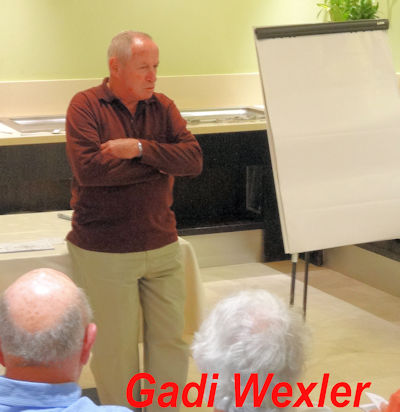 Gadi Wexler presented a talk to CAARI on “Jerusalem After 1967”. He had been a
guide in Israel for over 40 years, served as a director of a field school of the Society
for the Protection of Nature, was a part-time member of faculty in the Geography Department
of the Hebrew University of Jerusalem, and taught training-guides courses for the
Ministry of Tourism. He had worked for over 25 years at the Ben-Zvi Institute for the
Land of Israel Studies and had a masters' degree in geography and history from the
Hebrew University.
Gadi Wexler presented a talk to CAARI on “Jerusalem After 1967”. He had been a
guide in Israel for over 40 years, served as a director of a field school of the Society
for the Protection of Nature, was a part-time member of faculty in the Geography Department
of the Hebrew University of Jerusalem, and taught training-guides courses for the
Ministry of Tourism. He had worked for over 25 years at the Ben-Zvi Institute for the
Land of Israel Studies and had a masters' degree in geography and history from the
Hebrew University. Katrine Verrier Frechette: 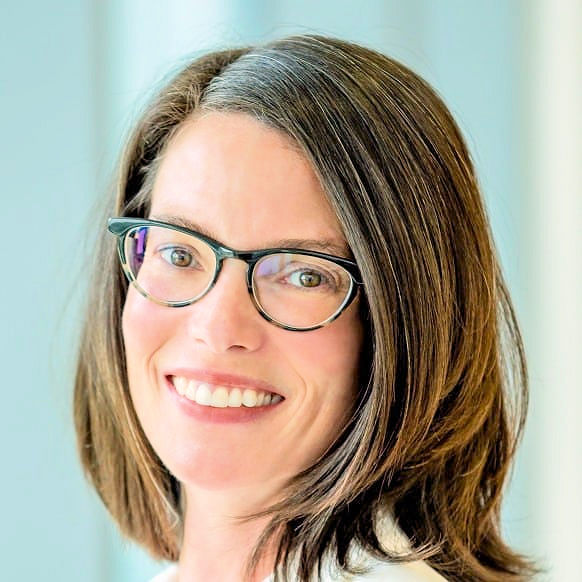 Katrine Verrier Frechette was a guest speaker on two of my CAARI visits to Israel.
She was from the Canadian embassy and had served in several other mid-east countries
for the Canadian Foreign Service office. She was Head of Mission and Representative
of Canada to the Palestinian Authority in Ramallah and previously served as Deputy
Head of Mission at the Embassy of Canada in Tel Aviv. At her CAARI presentations, Frechette
discussed the many cooperative programs between Canada and Israel and told us about
some of the activities of Canada in the Middle East.
Katrine Verrier Frechette was a guest speaker on two of my CAARI visits to Israel.
She was from the Canadian embassy and had served in several other mid-east countries
for the Canadian Foreign Service office. She was Head of Mission and Representative
of Canada to the Palestinian Authority in Ramallah and previously served as Deputy
Head of Mission at the Embassy of Canada in Tel Aviv. At her CAARI presentations, Frechette
discussed the many cooperative programs between Canada and Israel and told us about
some of the activities of Canada in the Middle East. Professor Mordechai Kedar: 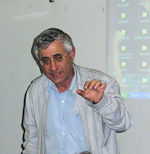 In 2012, I attended a CAARI presentation by Professor Mordechai Kedar from the Center for
Mid-Eastern Studies at Bar-Ilan University where he studied and taught Arabic literature
and Arab-Israeli relations. His topic was the Arab/Muslim culture which determined events in
the Middle East and throughout the world. He focused on Arab/Muslim relations with Israel and
the United States.
In 2012, I attended a CAARI presentation by Professor Mordechai Kedar from the Center for
Mid-Eastern Studies at Bar-Ilan University where he studied and taught Arabic literature
and Arab-Israeli relations. His topic was the Arab/Muslim culture which determined events in
the Middle East and throughout the world. He focused on Arab/Muslim relations with Israel and
the United States. Mike Ben-Ami: 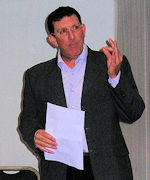 Mike Ben-Ami (Greenfield, prior to his aliyah to Israel several years ago) spoke to CAARI on
the subject of the Israeli economy. He noted that important factors responsible for Israel’s
economic growth included foreign investments and the immigration of well-educated Russians
in the 1990’s. As of 2012, contributing to Israel’s economic growth were: the high tech
industry; science and research; military hardware export; Dead Sea chemicals; and pharmaceuticals.
He rightly predicted that Israel’s off-shore natural gas deposits would completely change
Israel.
Mike Ben-Ami (Greenfield, prior to his aliyah to Israel several years ago) spoke to CAARI on
the subject of the Israeli economy. He noted that important factors responsible for Israel’s
economic growth included foreign investments and the immigration of well-educated Russians
in the 1990’s. As of 2012, contributing to Israel’s economic growth were: the high tech
industry; science and research; military hardware export; Dead Sea chemicals; and pharmaceuticals.
He rightly predicted that Israel’s off-shore natural gas deposits would completely change
Israel. Isaak Tavior: 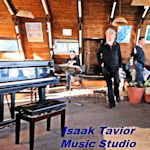 As part of the 2013 CAARI program, we met Isaak Tavior. He lived in a hill-top house
and studio near Moshav Shefer. The views from his hill-top studio were
breathtaking. Isaak Tavior was a world-renowned composer, conductor and pianist.
He entertained us with his playing of pieces by Mozart, Shuman, and Brahms and ended
with his own composition “Visions of the Dry Bones”, a thoroughly enjoyable and
unique composition. In addition to entertaining us with his virtuoso piano paying,
the maestro personally served us coffee and pastry.
As part of the 2013 CAARI program, we met Isaak Tavior. He lived in a hill-top house
and studio near Moshav Shefer. The views from his hill-top studio were
breathtaking. Isaak Tavior was a world-renowned composer, conductor and pianist.
He entertained us with his playing of pieces by Mozart, Shuman, and Brahms and ended
with his own composition “Visions of the Dry Bones”, a thoroughly enjoyable and
unique composition. In addition to entertaining us with his virtuoso piano paying,
the maestro personally served us coffee and pastry. Gil Kopatch: 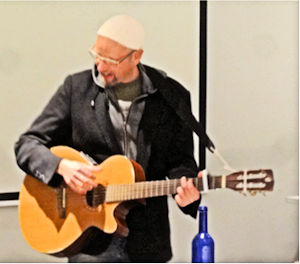 CAARI enjoyed a presentation on Talmudic humor by Gil Kopatch, a well-known Israeli
comedian and satirist. He had a very popular Israel TV program in the 1990s which included
satirical skits of Israeli politicians and political parties, based upon biblical and
Talmudic themes which infuriated several of the targets of his humor. Gill entertained us
with a number of jokes, and humorous interpretations of passages from the bible and
the Talmud.
CAARI enjoyed a presentation on Talmudic humor by Gil Kopatch, a well-known Israeli
comedian and satirist. He had a very popular Israel TV program in the 1990s which included
satirical skits of Israeli politicians and political parties, based upon biblical and
Talmudic themes which infuriated several of the targets of his humor. Gill entertained us
with a number of jokes, and humorous interpretations of passages from the bible and
the Talmud. Dr. Yitzhak Reiter: 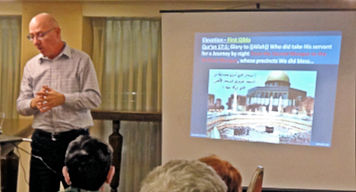 Dr. Yitzhak Reiter addressed CAARI on the topic of "The Temple Mount from the Muslim Perspective".
Dr. Reiter was associated with the Ashkelon Academic College and the Jerusalem
Institute for Policy. He reviewed the history of the Muslim claims to association with
the Temple Mount from the time of the Prophet Mohammed right up to the present. My summation
of Dr. Reiter’s presentation was that the Muslim claims were based upon distortions of fact,
fabricated traditions and deliberate falsehoods.
Dr. Yitzhak Reiter addressed CAARI on the topic of "The Temple Mount from the Muslim Perspective".
Dr. Reiter was associated with the Ashkelon Academic College and the Jerusalem
Institute for Policy. He reviewed the history of the Muslim claims to association with
the Temple Mount from the time of the Prophet Mohammed right up to the present. My summation
of Dr. Reiter’s presentation was that the Muslim claims were based upon distortions of fact,
fabricated traditions and deliberate falsehoods. Esther Carmel-Hakim: 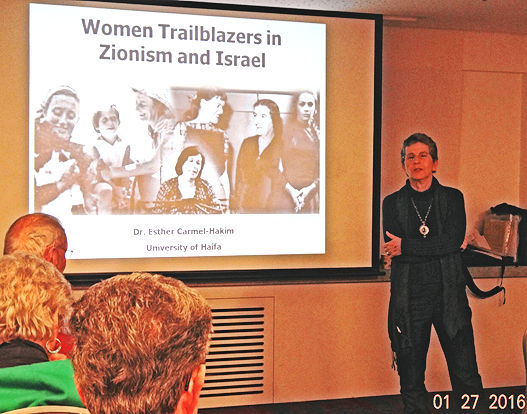 A 2016 guest speaker, Esther Carmel-Hakim, addressed CAARI on the topic of “Women
Trailblazers in Zionism and Israel". Esther Hakim was a member of Kibbutz Ramat Hashofet,
a graduate of Concordia University in Montreal, Canada, had an MA and PhD in Land of
Israel Studies from the University of Haifa, and was a member of the faculty there.
A 2016 guest speaker, Esther Carmel-Hakim, addressed CAARI on the topic of “Women
Trailblazers in Zionism and Israel". Esther Hakim was a member of Kibbutz Ramat Hashofet,
a graduate of Concordia University in Montreal, Canada, had an MA and PhD in Land of
Israel Studies from the University of Haifa, and was a member of the faculty there. In 2004-2005, Esther Hakim was a visiting lecturer and researcher at the Near Eastern and Judaic Studies at Brandeis University. Her teaching and research interests included Women's Zionist Organizations, Women in Israel, and Women on the Kibbutz. She had also taught Intermediate Hebrew at The Middlebury College School of Languages. Hakim’s presentation covered the history of a number of mostly unknown Jewish women who fought for and mostly obtained equality for women in Israel – the exception being the ultra-Orthodox who still did not recognize women as equals and maintained their exclusive control of marriage and divorce in Israel. She noted that the kibbutz movement in Palestine and then Israel had significantly contributed to the attainment of equal rights by women in Israel. Maganda Restaurant: 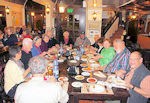 Over the years, CAARI often visited the Maganda Restaurant in the Neve Tzedek
section of Tel Aviv for a dinner. Maganda was an excellent Yemenite kosher restaurant
where the atmosphere in the restaurant was always warm and welcoming, the food was
excellent - not too fancy, not too spicy, and always very plentiful.
Over the years, CAARI often visited the Maganda Restaurant in the Neve Tzedek
section of Tel Aviv for a dinner. Maganda was an excellent Yemenite kosher restaurant
where the atmosphere in the restaurant was always warm and welcoming, the food was
excellent - not too fancy, not too spicy, and always very plentiful. In 1927, the Habura family purchased the land and built a house where the restaurant was now located. In 1965, the Maganda Restaurant opened its doors under the management of the Habura brothers who named it after their youngest brother, nicknamed Maganda, who resembled “Maganda”, the leading actor of an African movie playing at the time. The dishes served in the restaurant hadn’t changed since the 1965 opening. The restaurant was well known for its active part in bringing food to Israeli soldiers in the field during periods of national crises. Liliyot Restaurant: 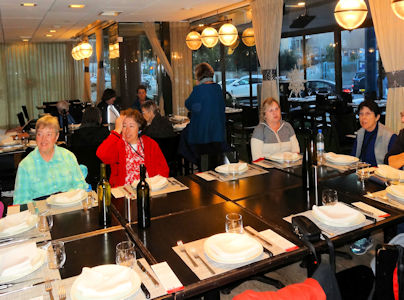 On many of the annual CAARI programs, we would enjoy dinner at the Liliyot Restaurant,
located in the unique and modern Beit Asia building. The restaurant was part of a social
action initiative for the rehabilitation of youth at risk. Every year Liliyot Restaurant
trained and employed 15 high school drop-outs, who received instruction, supervision and
employment for a period of up to a year and a half. The vocational training enabled participants
to acquire a high demand profession, and, for the first time in their lives, equipped them with
the means necessary to integrate into society as productive citizens. Food, ambiance, and service
at the restaurant were all excellent - I would highly recommend a visit there.
On many of the annual CAARI programs, we would enjoy dinner at the Liliyot Restaurant,
located in the unique and modern Beit Asia building. The restaurant was part of a social
action initiative for the rehabilitation of youth at risk. Every year Liliyot Restaurant
trained and employed 15 high school drop-outs, who received instruction, supervision and
employment for a period of up to a year and a half. The vocational training enabled participants
to acquire a high demand profession, and, for the first time in their lives, equipped them with
the means necessary to integrate into society as productive citizens. Food, ambiance, and service
at the restaurant were all excellent - I would highly recommend a visit there. Tu B’Shvat Seder: 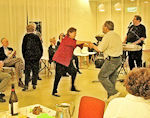 One special event that took place every year was the CAARI Tu B’Shvat Seder party. At the
seder party, we would eat a number of different fruits and nuts that included the seven
species mentioned in the Bible – wheat, barley, grapes, olives, pomegranates, figs, and
dates (honey) - and also drink 4 cups of wine consisting of: white wine at the beginning
of the seder, the second cup mostly white wine, the third cup half white and half red, and
red wine at the end.
One special event that took place every year was the CAARI Tu B’Shvat Seder party. At the
seder party, we would eat a number of different fruits and nuts that included the seven
species mentioned in the Bible – wheat, barley, grapes, olives, pomegranates, figs, and
dates (honey) - and also drink 4 cups of wine consisting of: white wine at the beginning
of the seder, the second cup mostly white wine, the third cup half white and half red, and
red wine at the end. Our Tu B’Shvat celebration included some very spirited singing and dancing to the accompaniment of the keyboard music and the singing of the highly talented Gidi Sivan. Gidi sang in Hebrew, Yiddish, English and Spanish, (and in a few other languages that I couldn’t recognize). Gidi was a perennial mainstay of the CAARI Tu B’Shvat celebrations and always got everyone singing, clapping, tapping and dancing. Shabbat: Most Friday evenings and Saturday mornings, I attended synagogue services. In Tel Aviv, I usually went to the orthodox Sephardic Temple Beit El, while on Saturday mornings I most often went to the modern Orthodox Ichud Shavat Zion Synagogue. On one particular Saturday morning it was clear that I was in Israel when I noticed that one of the younger congregants had an automatic pistol strapped to his hip. Unscheduled: Not all of the time spent with CAARI involved scheduled events or tours. One year, CAARI arranged for an unscheduled weekend trip to the ancient a nd famous Nabatean city of Petra in Jordan. Another time, Neil Eisenstadt put together a weekend of visits to Christian sites in Israel for a Southern Baptist Christian member of our CAARI group. I and a number of other Jewish participants joined in the side trip and had a fabulous time. During my last CAARI trip, my then 16-year old grandson joined us for his weeklong February school vacation. Again, Neil promptly organized another unscheduled side trip, tailored to my grandson’s interests, during his weekend in Israel. Occasionally, changes in the CAARI schedule had to be made to accomodate the weather, Israeli bureaucracy, last minute speaker cancellations, and other uunforeseen circumstances. Modern Orthodox, Conservative, Reform and Secular Jews: 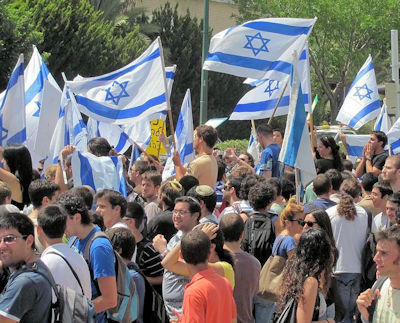 The large majority of Jewish Israelis are Modern Orthodox, Conservative, Reform or secular Jews.
They were friendly and ready to enter into conversation on the street, in a bus, driving a taxi,
in a store or in a hotel. Most spoke English but I tried to converse with them in my rudimentary
Hebrew whenever possible. My favorite Israeli to practice my Hebrew on was the taxi driver.
From the driver, I could pick up the real news, the latest gossip and an insight into Israeli
life.
The large majority of Jewish Israelis are Modern Orthodox, Conservative, Reform or secular Jews.
They were friendly and ready to enter into conversation on the street, in a bus, driving a taxi,
in a store or in a hotel. Most spoke English but I tried to converse with them in my rudimentary
Hebrew whenever possible. My favorite Israeli to practice my Hebrew on was the taxi driver.
From the driver, I could pick up the real news, the latest gossip and an insight into Israeli
life. Ultra-Orthodox Jews: 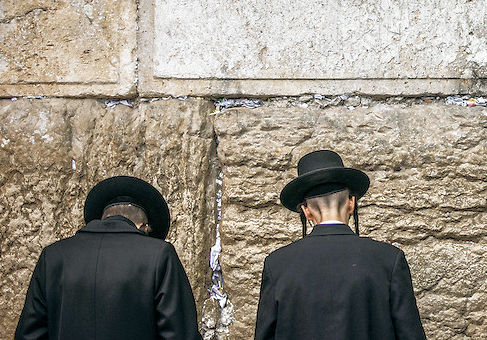 In Israel, ultra-Orthodox or Haredi Jews have tended to live very insular lives.
In certain Haredi communities, the entire infrastructure, from jobs to school and
legal systems have been maintained within the confines of the community itself.
The Israeli Haredi community has also been known for its sometimes violent and
hateful outbursts against moves toward modernity and a more cohesive Israeli
society. Slowly this has been changing, with new educational initiatives to bring
secular study into a strictly religious environment to provide more opportunities
for women and children, and even Haredim playing crucial roles as soldiers in the
Israel Defense Forces (IDF), from which they were once exempt from service. In 2010,
the ultra-Orthodox Jews constituted about 8 percent of Israel's population, or some
600,000 to 700,000 people and was the fastest-growing segment in Israel. Dressed all
in black, these ultra-Orthodox have practiced a strict form of Judaism, mostly cut
off from the rest of the modern Israeli society. In cities like Jerusalem and Tel Aviv,
they have had their own neighborhoods, shops and schools and have not hesitated to
challenge the authorities. Many mainstream Israelis look with disfavor upon the ultra-Orthodox,
noting their refusal to serve in the military, their disdain of working, and their government
subsidies.
In Israel, ultra-Orthodox or Haredi Jews have tended to live very insular lives.
In certain Haredi communities, the entire infrastructure, from jobs to school and
legal systems have been maintained within the confines of the community itself.
The Israeli Haredi community has also been known for its sometimes violent and
hateful outbursts against moves toward modernity and a more cohesive Israeli
society. Slowly this has been changing, with new educational initiatives to bring
secular study into a strictly religious environment to provide more opportunities
for women and children, and even Haredim playing crucial roles as soldiers in the
Israel Defense Forces (IDF), from which they were once exempt from service. In 2010,
the ultra-Orthodox Jews constituted about 8 percent of Israel's population, or some
600,000 to 700,000 people and was the fastest-growing segment in Israel. Dressed all
in black, these ultra-Orthodox have practiced a strict form of Judaism, mostly cut
off from the rest of the modern Israeli society. In cities like Jerusalem and Tel Aviv,
they have had their own neighborhoods, shops and schools and have not hesitated to
challenge the authorities. Many mainstream Israelis look with disfavor upon the ultra-Orthodox,
noting their refusal to serve in the military, their disdain of working, and their government
subsidies. Yemenite Jews: 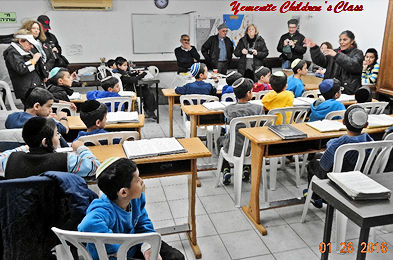 In 2016, CAARI visited Rosh HaAyin, about 15 miles east of Tel Aviv, which was
home to thousands of Yemenite Jews that had immigrated to Israel in the 1950's and their
descendants. There, we learned about the Jews of Yemen, their special traditions and how
they have been absorbed into Israeli society. Yemenite Jews had been physically
separated from the European and Sephardic Jews that were forced from Palestine after
the destruction of the Second Temple and they therefore were not exposed to the changes
in the Jewish religion following the destruction of the Second Temple. Yemenite Jews had
therefore been practicing pre-Mishnaic Judaism for the past 2,000 years. In other words,
they practiced the Jewish religion as it existed over 2,000 years ago.
In 2016, CAARI visited Rosh HaAyin, about 15 miles east of Tel Aviv, which was
home to thousands of Yemenite Jews that had immigrated to Israel in the 1950's and their
descendants. There, we learned about the Jews of Yemen, their special traditions and how
they have been absorbed into Israeli society. Yemenite Jews had been physically
separated from the European and Sephardic Jews that were forced from Palestine after
the destruction of the Second Temple and they therefore were not exposed to the changes
in the Jewish religion following the destruction of the Second Temple. Yemenite Jews had
therefore been practicing pre-Mishnaic Judaism for the past 2,000 years. In other words,
they practiced the Jewish religion as it existed over 2,000 years ago. Between 1949 and 1950 some 50,000 Yemenite Jews were brought to Israel in Operation Magic Carpet, otherwise known as the “wings of eagles”. In Rosh HaAyin, we visited a museum dedicated to preserving the Yemenite heritage and which housed documents, photos, ancient manuscripts, household utensils, traditional dress and artistic artifacts. There was a learning center for students and groups which focused on the history, literature, and folklore of Yemen. Also in the museum were: a collection on genealogy and family history; home made films, documentaries and audio cassettes; family books and family researches; oral history collections. We were treated to a Yemenite dance, performed by a group of 70+ year young Yemenite women who were able to entice several of our group into dancing with them, including Zacharia, our Yemenite bus driver. From the museum, we drove a very short distance to a Yemenite synagogue to meet a class of Yemenite boys being taught how to read and chant the Torah in Hebrew and Aramaic (an ancient form of Hebrew). The class was taught in the tradition of the Hebrew Cheder or Talmud Torah (religious school) with a Melamed (teacher) as in the old Eastern European Shtetels (villages) of yesteryear. The boys attended the class seven days a week in addition to their regular schooling. The class was mixed, with some being highly religious, as evidenced by their peyas (side locks) and tzizis (fringes), while others were secular. Yemenite girls did not attend these schools, did not have Bat Mizvahs and were not called up to the Torah when it was read in the synagogue. Ethiopian Jews: 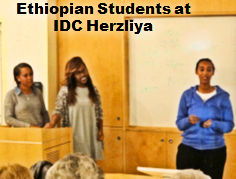 CAARI introduced me to the Ethiopian Jewish community with talks by Ethiopian Jewish women in
2012 and in 2016. The Ethiopian Jewish community in Israel was properly known as Beta Yisrael
(House of Israel). The Beta Yisrael claimed descent from Menilek I, traditionally
the son of the Queen of Sheba and King Solomon. Beta Yisrael remained
faithful to Judaism after the conversion
of the powerful Ethiopian kingdom to Christianity in the 4th century. Thereafter the Beta Yisrael
were persecuted and forced to retreat to the area around Lake Tana, in northern Ethiopia.
The Beta Yisrael were severely persecuted by the military regime that ousted Emperor Haile
Selassie in 1974 and thousands subsequently died of starvation and murder. Between 1980
and 1992 some 45,000 Beta Yisrael fled drought- and war-stricken Ethiopia and
immigrated to Israel.
CAARI introduced me to the Ethiopian Jewish community with talks by Ethiopian Jewish women in
2012 and in 2016. The Ethiopian Jewish community in Israel was properly known as Beta Yisrael
(House of Israel). The Beta Yisrael claimed descent from Menilek I, traditionally
the son of the Queen of Sheba and King Solomon. Beta Yisrael remained
faithful to Judaism after the conversion
of the powerful Ethiopian kingdom to Christianity in the 4th century. Thereafter the Beta Yisrael
were persecuted and forced to retreat to the area around Lake Tana, in northern Ethiopia.
The Beta Yisrael were severely persecuted by the military regime that ousted Emperor Haile
Selassie in 1974 and thousands subsequently died of starvation and murder. Between 1980
and 1992 some 45,000 Beta Yisrael fled drought- and war-stricken Ethiopia and
immigrated to Israel. The Beta Yisrael had a Bible and a prayer book written in an ancient Ethiopian language. They had no Talmudic laws, but their preservation of and adherence to Jewish traditions was undeniable. They observed the Sabbath, practiced circumcision, had synagogue services led by Cohanim (priests), followed certain dietary laws of Judaism, observed many laws of ritual uncleanness, offered sacrifices on the 14th Nisan (the day before the first day of Passover) in the Jewish religious year, and observed some of the major Jewish festivals. The ongoing absorption of the Beta Yisrael community into Israeli society was a source of ethnic tension in Israel. To some degree, the Beta Yisrael suffered from prejudice and discrimination, much as Blacks or Hispanics do in the U.S. Full integration into Israeli society was said to be hindered by their lack of political clout. The Beta Yisrael community had failed to integrate into a unified political block which could then lobby for greater equality and a speed-up in the integration process. One area in which assimilation had proceeded more or less smoothly was the military. There was much less discrimination in the IDF and there were better opportunities for advancement – talent counted more than ethnicity. Most Ethiopian immigrants were illiterate – it was their children who learned to read and write Hebrew and English. Efrat: 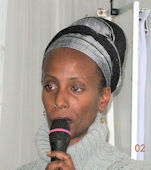 Efrat was an Ethiopian Jew who worked on problems of the Ethiopian community in Israel.
She explained to CAARI that the Beta Yisrael had remained faithful to Judaism
after the conversion of the Ethiopian kingdom to Christianity in the 4th century.
The Beta Yisrael were persecuted by the military regime that ousted Haile
Selassie. Thousands of Beta Yisrael died of starvation and murder under the
military regime. Between 1980 and 1992 some 45,000 Beta Yisrael
fled drought- and war-stricken Ethiopia and immigrated to Israel. Most of them reached
Israel through Israeli-coordinated evacuation efforts - “Operation Moses" in 1984-1985 and
“Operation Solomon” in 1991.
Efrat was an Ethiopian Jew who worked on problems of the Ethiopian community in Israel.
She explained to CAARI that the Beta Yisrael had remained faithful to Judaism
after the conversion of the Ethiopian kingdom to Christianity in the 4th century.
The Beta Yisrael were persecuted by the military regime that ousted Haile
Selassie. Thousands of Beta Yisrael died of starvation and murder under the
military regime. Between 1980 and 1992 some 45,000 Beta Yisrael
fled drought- and war-stricken Ethiopia and immigrated to Israel. Most of them reached
Israel through Israeli-coordinated evacuation efforts - “Operation Moses" in 1984-1985 and
“Operation Solomon” in 1991. The absorption of the Beta Yisrael community into Israeli society was difficult and the tensions between the Black Ethiopian Jews and the lighter-skinned Ashkenazi and Sephardic Jews was described in some detail by Efrat. Efrat estimated that there were about 120,000 Ethiopians living in Israel, with 200 or so are still arriving each month. Efrat’s presentation concluded with a film showing the plight of the Falasha in Ethiopia and the Sudan in the early 1980’s, before the large-scale immigration efforts to Israel were started. Karaite Jews: 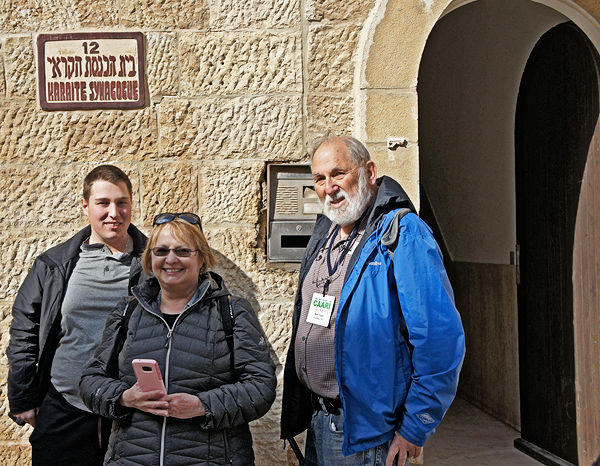 Karaite Judaism was a Jewish religious movement characterized by the recognition of the
Tanakh (the 5-books of Moses, the books of the Prophets and the additional writings that
are included in the Hebrew Bible) alone as its supreme authority. It was distinct from
mainstream Rabbinic Judaism, which considered the Oral Torah, as codified in the Talmud
and subsequent works, to be authoritative interpretations of the Torah. Karaites maintained
that all of the divine commandments handed down to Moses by God were recorded in the
written Tanakh. As a result, Karaite Jews did not accept as binding the written collections
of the oral tradition in the Midrash or Talmud. It was estimated that 35,000-40,000 Karaites
resided in Israel.
Karaite Judaism was a Jewish religious movement characterized by the recognition of the
Tanakh (the 5-books of Moses, the books of the Prophets and the additional writings that
are included in the Hebrew Bible) alone as its supreme authority. It was distinct from
mainstream Rabbinic Judaism, which considered the Oral Torah, as codified in the Talmud
and subsequent works, to be authoritative interpretations of the Torah. Karaites maintained
that all of the divine commandments handed down to Moses by God were recorded in the
written Tanakh. As a result, Karaite Jews did not accept as binding the written collections
of the oral tradition in the Midrash or Talmud. It was estimated that 35,000-40,000 Karaites
resided in Israel. The Karaite Heritage Center in the Old City area of Jerusalem was co-located with the oldest active Karaite Synagogue in the world and contained replicas of old and rare manuscripts written by Karaite scholars throughout the generations, including the famous Aleppo Codex. It was visited by CAARI in 2017. Samaritans: 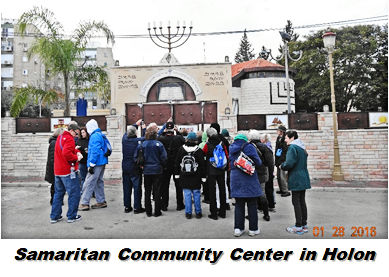 The Samaritans observed practices close to that of Judaism 2500 years ago. The Samaritans claimed
descent from the Israelite tribes of Ephraim and Manasseh (sons of Joseph)
as well as from the priestly tribe of Levi. Their religion was based on the Samaritan
Pentateuch and they claimed that their worship was the true religion of the Israelites
prior to the Babylonian Exile following the destruction of the First Temple. The
Samaritans split from Judaism around 2,000 years ago, but because they spoke ancient Hebrew
and prayed in synagogues, they were often mistaken for Jews.
The Samaritans observed practices close to that of Judaism 2500 years ago. The Samaritans claimed
descent from the Israelite tribes of Ephraim and Manasseh (sons of Joseph)
as well as from the priestly tribe of Levi. Their religion was based on the Samaritan
Pentateuch and they claimed that their worship was the true religion of the Israelites
prior to the Babylonian Exile following the destruction of the First Temple. The
Samaritans split from Judaism around 2,000 years ago, but because they spoke ancient Hebrew
and prayed in synagogues, they were often mistaken for Jews. Samaritans celebrated Passover every year around their ancient temple site of sacrifice on Mount Gerizim, their holy mountain. The Day of Atonement was the Samaritans’ holiest day of their year. They rigidly observed the Sabbath. The Samaritans were a distinctly religious community and their high priest also acted as their political official and representative. The Samaritans maintained relationships with both Israelis and Palestinians. Neither Muslim nor Jew, Samaritans functioned well in both societies. They lived and worked among Israelis, attending their schools and serving in the army. As of January 2012, the Samaritans numbered just 751, divided between Kiryat Luza on Mount Gerizim in Samaria (West Bank) and the city of Holon, just outside Tel Aviv. Most Israeli-Samaritans spoke Arabic and Modern Hebrew. The Samaritans considered themselves the true Israelites. While most Jews in Israel were returnees from the diaspora, the Samaritans never left. They remained in Israel following the expulsion of the rest of the Jews following the destruction of the Second Temple. Israeli-Arabs: 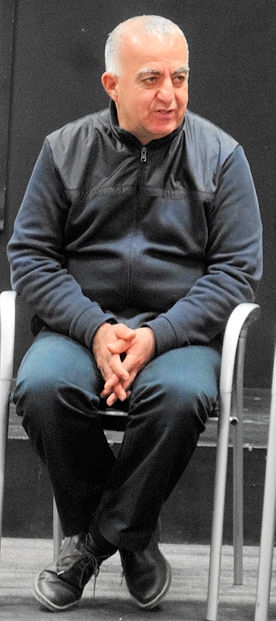 Israeli-Arabs were Israeli citizens whose primary language or linguistic heritage was Arabic.
Most Arab citizens of Israel were functionally bilingual, their second language being Modern
Hebrew. By religious affiliation, most were Muslim, particularly of the Sunni branch of Islam.
There was a significant Arab Christian minority from various denominations as well as the
Druze, among other religious communities.
Israeli-Arabs were Israeli citizens whose primary language or linguistic heritage was Arabic.
Most Arab citizens of Israel were functionally bilingual, their second language being Modern
Hebrew. By religious affiliation, most were Muslim, particularly of the Sunni branch of Islam.
There was a significant Arab Christian minority from various denominations as well as the
Druze, among other religious communities. In 2013, the Israeli-Arab population was estimated at 1,658,000, representing 21% of the country's population. Arab citizens of Israel mostly lived in Arab-majority towns and cities. The vast majority attended separate schools and Arab political parties had never joined a government coalition. Many had family ties to Palestinians in the West Bank and the Gaza Strip as well as to Palestinian refugees in Jordan, Syria and Lebanon. Negev Bedouins and the Druze tended to identify more as Israelis than other Arab citizens of Israel. Christian Arabs comprised about 9% of the Arab population in Israel. Approximately 70% resided in the north. Druze villages had small Christian Arab populations. Nazareth had the largest Christian Arab population and Haifa's Arab minority was mostly Christian. Christian Arabs were one of the most educated groups in Israel. Umm Al Fahem: 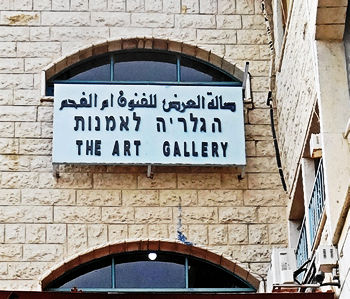 In 2016, CAARI traveled to the Arab Cultural Center in the Arab town of Umm Al Fahem –
about 8 miles southwest of Afula.
In 2016, CAARI traveled to the Arab Cultural Center in the Arab town of Umm Al Fahem –
about 8 miles southwest of Afula. In Umm Al Fahem, we met Said Abu Shakra, who started and ran the Umm Al Fahem Art Gallery which also served as the Arab Cultural Center. We started our visit with Arab coffee, sliced apples and halvah. Said then told us about his background, his perspective of being an Arab Moslem citizen of Israel and his approach to bettering the lives of the Arab community in Israel. He was an Israeli police officer and an artist before starting and growing the art gallery. His idea was to use the art gallery as a cultural center to bring Jews and Arabs together to meet and discuss the Arab-Jewish situation and to develop ways to improve the conditions of the Arab communities in Israel. His efforts were partially successful – he got Arab and Jewish children working together at the gallery as have adults. Basma Café: 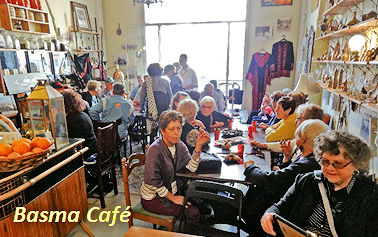 CAARI enjoyed a visit to the popular Basma Café in Jaffa. This was a special
café that employed
only women and was run by an Arab woman from Jaffa. She showed us how she prepared her many
different coffees by hand roasting and then served us fresh brewed coffee and tea, along with
Arab pastries – a most relaxing way to pass the time in Jaffa.
CAARI enjoyed a visit to the popular Basma Café in Jaffa. This was a special
café that employed
only women and was run by an Arab woman from Jaffa. She showed us how she prepared her many
different coffees by hand roasting and then served us fresh brewed coffee and tea, along with
Arab pastries – a most relaxing way to pass the time in Jaffa. Bedouins: 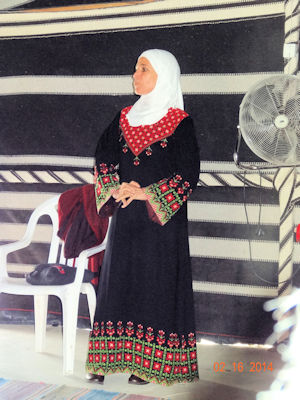 The Bedouin population in Israel in 2016 numbered about 210,000 persons who lived in all
regions of the country, most notably in the Negev. Since the establishment of the State of
Israel, the Bedouin population had increased tenfold. Quite Significantly, within a single
generation, the Bedouins of Israel had succeeded in reducing illiteracy from 95% to 25%, with
those still illiterate being aged 55 and above.
The Bedouin population in Israel in 2016 numbered about 210,000 persons who lived in all
regions of the country, most notably in the Negev. Since the establishment of the State of
Israel, the Bedouin population had increased tenfold. Quite Significantly, within a single
generation, the Bedouins of Israel had succeeded in reducing illiteracy from 95% to 25%, with
those still illiterate being aged 55 and above. Since 1948, Bedouins had served in the Israel Defense Forces (IDF) in large numbers, mostly in scouting or tracking units. There was a monument honoring Bedouin soldiers' contribution to Israel and its army in the Galilee. Despite their integration into the IDF, Israel's Bedouin population remained largely unintegrated into the rest of Israeli society. Whereas the Negev Bedouin were ambivalent in their attitude toward the State of Israel and their identification with it, the northern Bedouin identified with it almost fully. This was manifested, first and foremost, in the extent of volunteering for the security services. At the Bedouin community of Lakiya, about 6 miles east of Be’er Sheva, CAARI visited a Bedouin Women’s Workshop where Bedouin women made desert embroidery. In a large tent, we were served coffee and tea, after which, the Bedouin founder of the project, Na’ama, described the program and two other projects that are all aimed at improving the status and education of Bedouin women and children. The “Desert Embroidery” project enabled Bedouin women to create traditional embroidery at home, with traditional motifs and decorations that have been passed down in the Bedouin tribes. The “Desert Weaving” project was unique. The women wove rugs, performing all the stages on site, including spinning and dying the threads, interweaving, weaving in ground looms and the finish. Weaving skills were passed on from mother to daughter. Na’ama and her projects faced opposition from much of the male Bedouin community. Much of their effort focused on providing leadership training to Bedouin girls and improving their status in the male-dominated society, while still retaining ancient traditions. The projects had striven to empower women and girls through education. Christian Arabs: 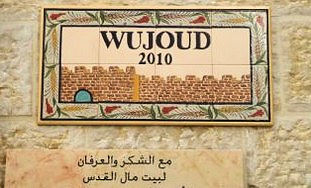 I met a number of Christian Arabs (mostly Eastern Orthodox Christians) in Israel. In the
Christian quarter of Jerusalem’s Old City, CAARI was given a tour of the Wojoud Cultural
Center and Museum by a Cristian Arab woman, Nora. Nora was head of a nondenominational
woman’s group and administered the museum.
I met a number of Christian Arabs (mostly Eastern Orthodox Christians) in Israel. In the
Christian quarter of Jerusalem’s Old City, CAARI was given a tour of the Wojoud Cultural
Center and Museum by a Cristian Arab woman, Nora. Nora was head of a nondenominational
woman’s group and administered the museum. Most recently, it was reported that some 166,000 Christians currently live in Israel, comprising 2% of the population. As of December 2014, 79% of Israeli Christians were of Arab descent. A historic change occurred in the Israeli Christian Arab community in August 2012, when the Christian Community Mobilization Forum was created to encourage all streams of Christian Arabs to enlist in the IDF. The Christian Arab community in Israel was very pro-Israel and they advocated full integration into Israeli society, as well as returning to their Christian Aramean roots. Druze: 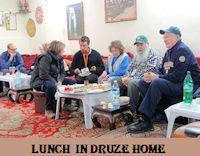 The relationship between Israeli Jews and Druze since Israel's independence in 1948 was both
emotional and practical, partly because of the considerable number of Israeli Druze soldiers
that had fallen in defense of Israel during Israel's many wars with its Arab neighbors. The
bond between Jewish and Druze soldiers was commonly known by the term "a covenant of blood".
The overarching basis of the Druze religion was to “do good”. The Druze were of Arab descent,
but they did not practice the Islamic religion. They were Arabic-speaking Citizens of Israel and
they served in the IDF. Members of the community had attained top positions in Israeli politics
and public service. Many Druze of college age had attended Haifa University and the
Technion,
and there were members of the faculties at these universities that were Druze. Most of Israel’s
Druze population lived in the northern region of the country, near Haifa.
The relationship between Israeli Jews and Druze since Israel's independence in 1948 was both
emotional and practical, partly because of the considerable number of Israeli Druze soldiers
that had fallen in defense of Israel during Israel's many wars with its Arab neighbors. The
bond between Jewish and Druze soldiers was commonly known by the term "a covenant of blood".
The overarching basis of the Druze religion was to “do good”. The Druze were of Arab descent,
but they did not practice the Islamic religion. They were Arabic-speaking Citizens of Israel and
they served in the IDF. Members of the community had attained top positions in Israeli politics
and public service. Many Druze of college age had attended Haifa University and the
Technion,
and there were members of the faculties at these universities that were Druze. Most of Israel’s
Druze population lived in the northern region of the country, near Haifa. The Druze community revered the non-Jewish father-in-law of Moses, Jethro. The tomb of Jethro near Tiberias was the most important religious site for the Druze community. It was claimed that the Druze were actually descendants of Jethro. While the Druze were very communal or clannish, they were very hospitable to outsiders. I, along with CAARI, visited the Druze town of Isfiya/Daliyat al-Karmel near Haifa. There, we had lunch in a private Druze house. The house served tourists and was certified to be kosher. Circassians: 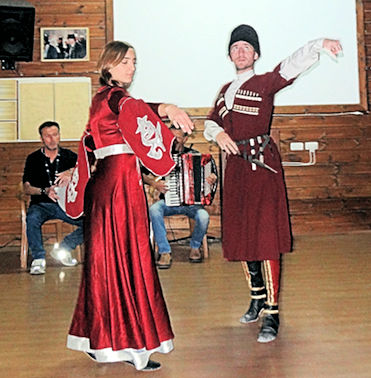 CAARI visited the town of Kfar Kama founded by Circassians who were non-Arab Muslims.
The Circassians come from Russia’s northern Caucasus, between the Black Sea and the Caspian Sea,
where they had a reputation for being fierce fighters. In the mid-1800s, the Circassians were
massacred and expelled from their homeland by Czarist Russia.
The Ottoman Empire took in the
Circassians to help them defend their empire. The Ottoman Turks settled Circassians in areas
like the Galilee in Palestine. Today, Israeli-Circassians refers to the
Adyghe community and they are Sunni Muslims.
CAARI visited the town of Kfar Kama founded by Circassians who were non-Arab Muslims.
The Circassians come from Russia’s northern Caucasus, between the Black Sea and the Caspian Sea,
where they had a reputation for being fierce fighters. In the mid-1800s, the Circassians were
massacred and expelled from their homeland by Czarist Russia.
The Ottoman Empire took in the
Circassians to help them defend their empire. The Ottoman Turks settled Circassians in areas
like the Galilee in Palestine. Today, Israeli-Circassians refers to the
Adyghe community and they are Sunni Muslims.Circassians emphasized the separation between religion and their nationality. About 4,000 Circassians lived in Israel, mainly in the villages of Kfar Kama and Rehaniya. Since 1958 all male Circassians (at their leader's request) had to complete Israeli military service upon reaching the age of majority, while females did not. The modern histories of Jews and Circassians in the Holy Land were intimately intertwined. Circassians first settled in Kfar Kama in 1876 and Rehaniya in 1878. In 1882, just 10 miles away, Zionist immigrants established Rosh Pina, the first Jewish agricultural settlement in the Galilee. Circassians helped the Jewish immigrants — many of them illegal — reach the Promised Land. The major division in the Galilee at the time wasn’t between Arabs and Jews, but between sedentary people and Bedouin nomads. The nomads demanded protection money from all the sedentary communities. The Circassian and Jewish settlements in the Galilee thus had a common reason to band together to fight off their common enemy. When conflict between Jews and Arabs began in the British Mandate period, the Circassians usually took neutral or pro-Jewish stances. Circassians identified with the Jews’ history of exile and dispersion. Also, many Jews and Circassians understood and spoke Russian. Most Circassian children in Israel were fluent in Hebrew and Arabic, learned English at school and their Circassian language (Adyghe) at home. A Circassian resident of Kfar Kama, took CAARI to the Circassian Heritage Museum, showed us an excellent film that provided information about the Circassians, and told us about modern Circassian life. Physical fitness, diet consciousness, and dance played an important role in Circassian life and there were many outstanding Israeli-Circassian athletes. At the museum, we were treated to a very enjoyable Circassian dance performance and were served tea and pastry. Baha’i:  Mirza Husayn ali Nuri (1817-92), known as Bahaullah or Baha Allah,
the “Promised One” founded the Baha'i faith in Iran in 1863. From 1852 to 1877 Baha Allah
was imprisoned or exiled. During that time, he wrote the Kitab al-aqdas (Arabic for
“The Most Holy Book”). At the time of Baha Allah‘s death in 1892, the Baha'i were based in
Iran and in Acre in Palestine.
Mirza Husayn ali Nuri (1817-92), known as Bahaullah or Baha Allah,
the “Promised One” founded the Baha'i faith in Iran in 1863. From 1852 to 1877 Baha Allah
was imprisoned or exiled. During that time, he wrote the Kitab al-aqdas (Arabic for
“The Most Holy Book”). At the time of Baha Allah‘s death in 1892, the Baha'i were based in
Iran and in Acre in Palestine. Baha Allah was buried near Akko (Acre). Baha Allah‘s son, Abbas Effendi, or Abd al-Baha, spread the Baha’i faith around the world. Since 1962, the Baha'i have been administered by their Universal House of Justice, based in Haifa. In more recent times, the Baha'i were Iran’s largest minority and were treated with relative tolerance by the Shah's regime. Iran’s current Islamic government now persecutes the Baha’i. In marked contrast to Iran’s treatment of the Baha’i, a very positive relationship existed between the Baha'i faith and the State of Israel. Israel even had a Baha'i Department under the Ministry of Religious Affairs. Baha Allah left explicit instructions that spreading the faith and accepting converts was forbidden in Palestine (now Israel). In keeping with this ruling, there were no permanent Baha’i in Israel. The only Baha'i in Israel were volunteers, estimated to number about 20,000 workers. Visitors from Around the World: 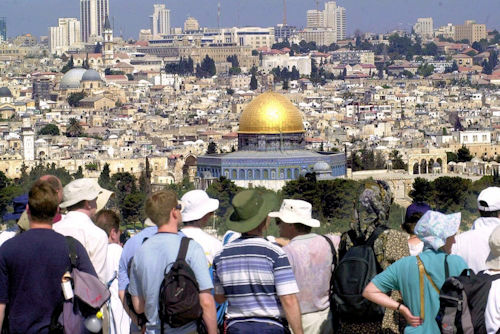 One of the more enjoyable aspects of my CAARI visits to Israel was the chance to meet not
only many Israelis, but also a vast number of visitors from all corners of the
globe.
One of the more enjoyable aspects of my CAARI visits to Israel was the chance to meet not
only many Israelis, but also a vast number of visitors from all corners of the
globe. Tourism in Israel was one of Israel's major sources of income, with a record 3.6 million tourist arrivals in 2017, and 25% growth since 2016. The largest percentage of tourists came from the United States accounting for 19% of all tourists, followed by Russia, France, Germany, the United Kingdom, China, Italy, Poland, and Canada. On CAARI's 2014 visit to Israel, after dinner at our hotel in Jerusalem, we were serenaded by a Christian tour group with Gospel singing. The harmony was excellent. The one Christian member of our CAARI party, a Baptist from North Carolina, joined in the hymn singing. I asked where the group was from and if they have been practicing. I was told that they were from all over the U.S. and that they hadn’t really done any practicing. The leader of the group asked who our group was and if our group was Jewish. When we said yes, the Christian group started singing “Am Yisrael Chai” in Hebrew. Our CAARI group joined in. We were then asked to sing a Hebrew song. We responded by singing “Oseh Shalom” and were joined by the Christian group. The leader of the Christian group, a pastor, then told us how supportive and appreciative the group was for what Israel and the Jewish people had contributed to the world and, to show this appreciation, they visited Israel every year. CAARI can be contacted at 917-724-2235 or at caarivolunteers@gmail.com. The CAARI web site can be found at www.caarivolunteers.com. Click here to visit the CAARI web site |
| 3 August 2018 {Article 330; Israel_38} |